ETHICAL FISHKEEPING
These days we are a little more conscious of the secret, complex lives of fish. But we still have a long way to go.
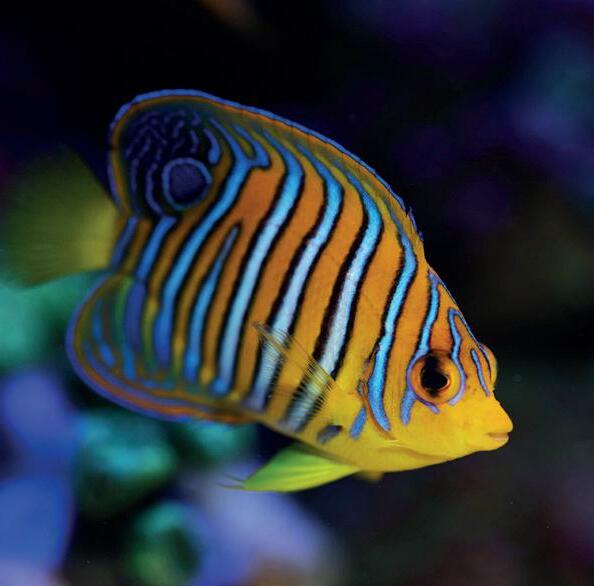
THE GAMBIAN POUCHED RAT
This species has helped diagnose 18,000 people, destroyed 13,000 landmines, and reduced poaching of pangolins across Africa.

MISUNDERSTOOD MONSTERS
Draped in superstition and displaced across the USA, Gila monsters might be under more threat than we thought.
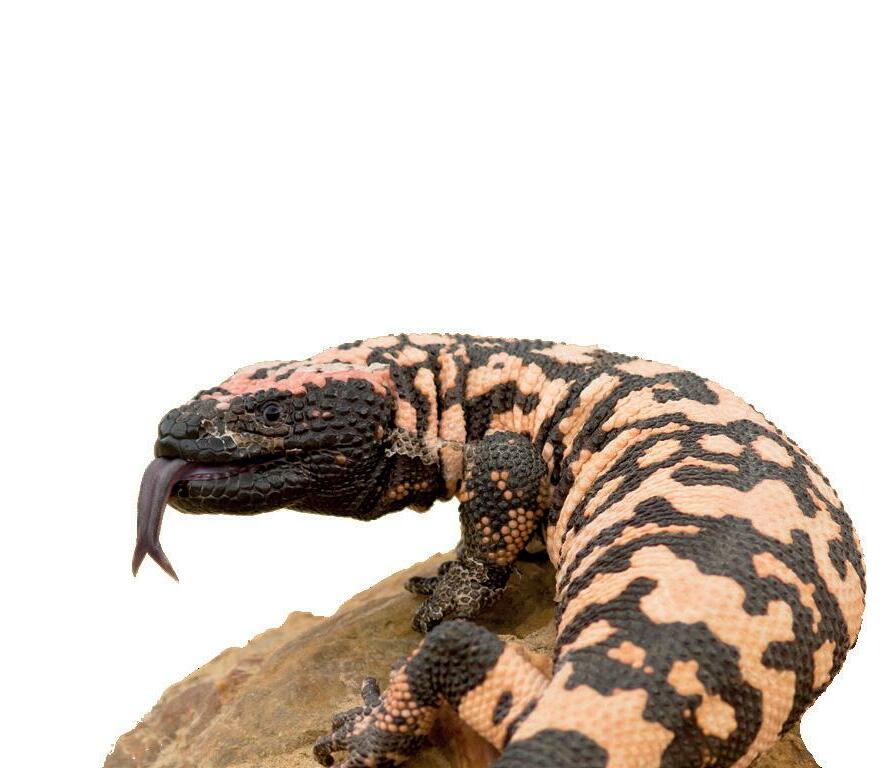
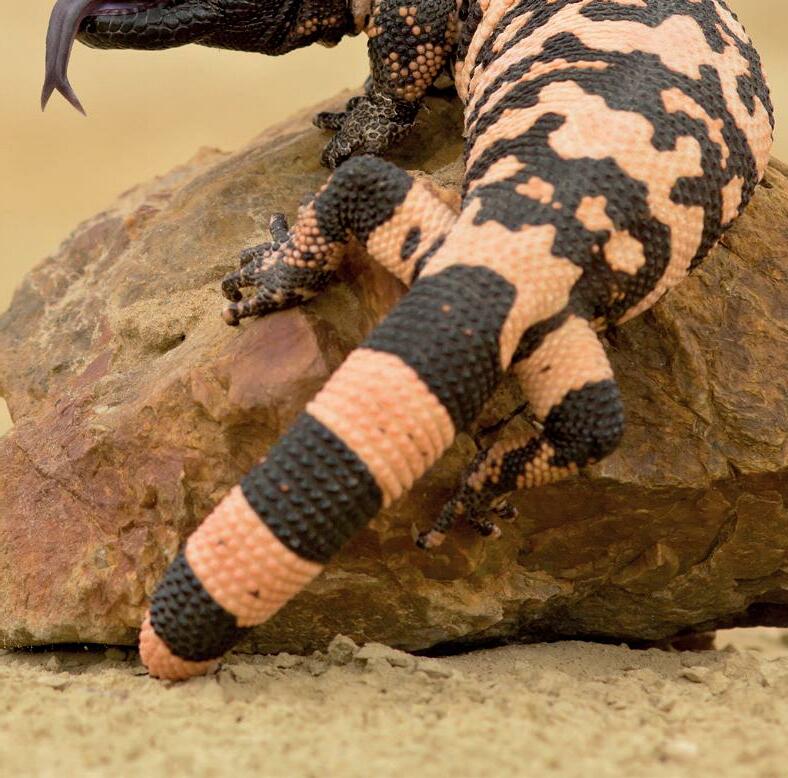
EXOTIC NEWS • SUN SPIDER • KEEPER BASICS - LIGHTING • ENRICHMENT IDEAS • POISON FROGS www.exoticskeeper.com • march 2022 • £3.99 NEW HIGH SCORE Perfecting pacman frog care.
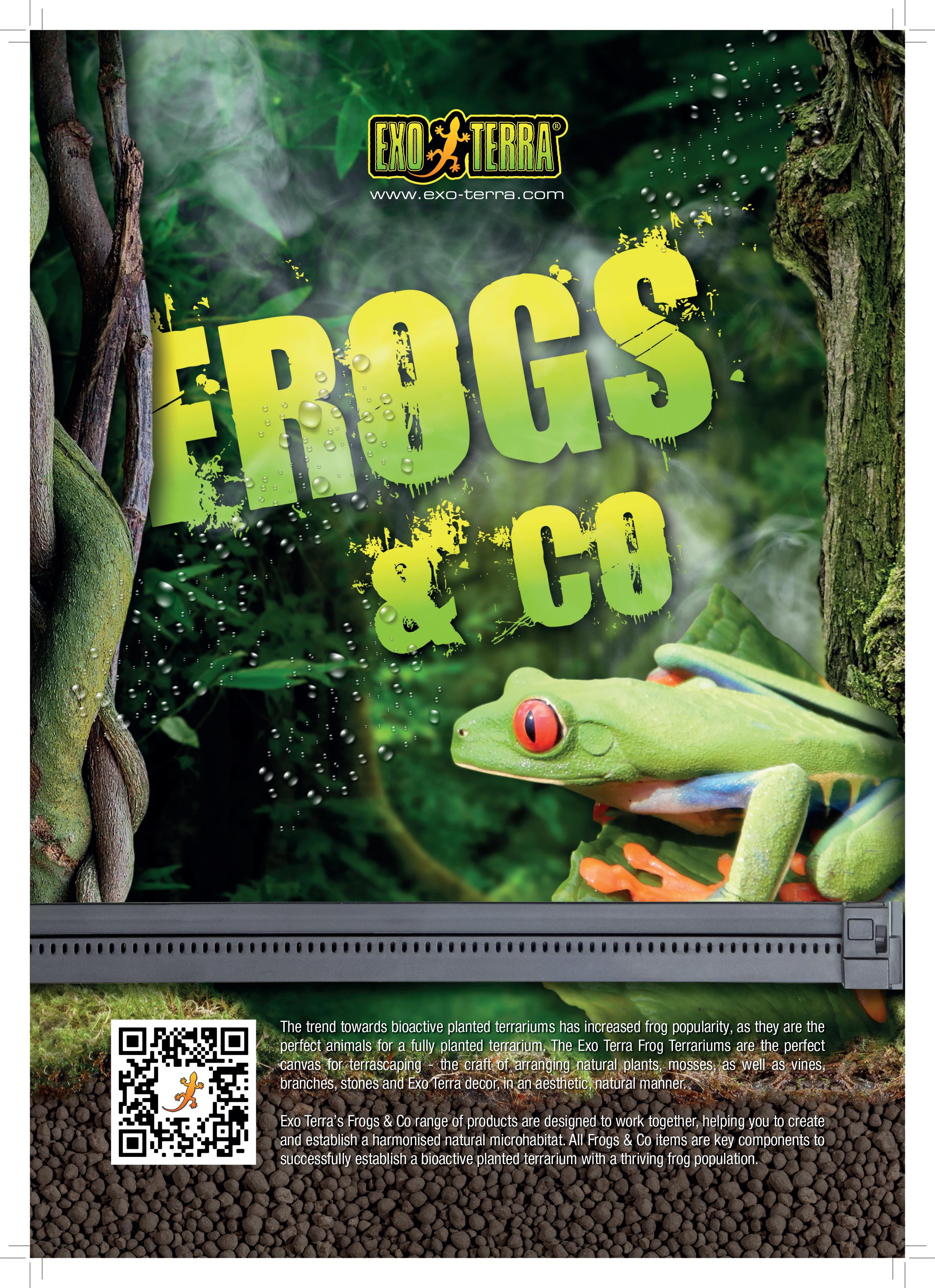
CONTACT US
EDITORIAL ENQUIRIES hello@exoticskeeper.com
SYNDICATION & PERMISSIONS scott@exoticskeeper.com
ADVERTISING advertising@exoticskeeper.com

About us
MAGAZINE PUBLISHED BY
Peregrine Livefoods Ltd Rolls Farm Barns Hastingwood Road Essex CM5 0EN
Print ISSN: 2634-4687 Digital ISSN: 2634-4688
This year is already flying by and with Spring just around the corner, it’s about time for the herptile and insect fanatics to begin thawing out for the year ahead. Here in the UK, we have some incredible species and now’s a brilliant time to consider building a pond, compost heap, or wildflower patch in the garden to support emerging reptiles, amphibians, and insects.
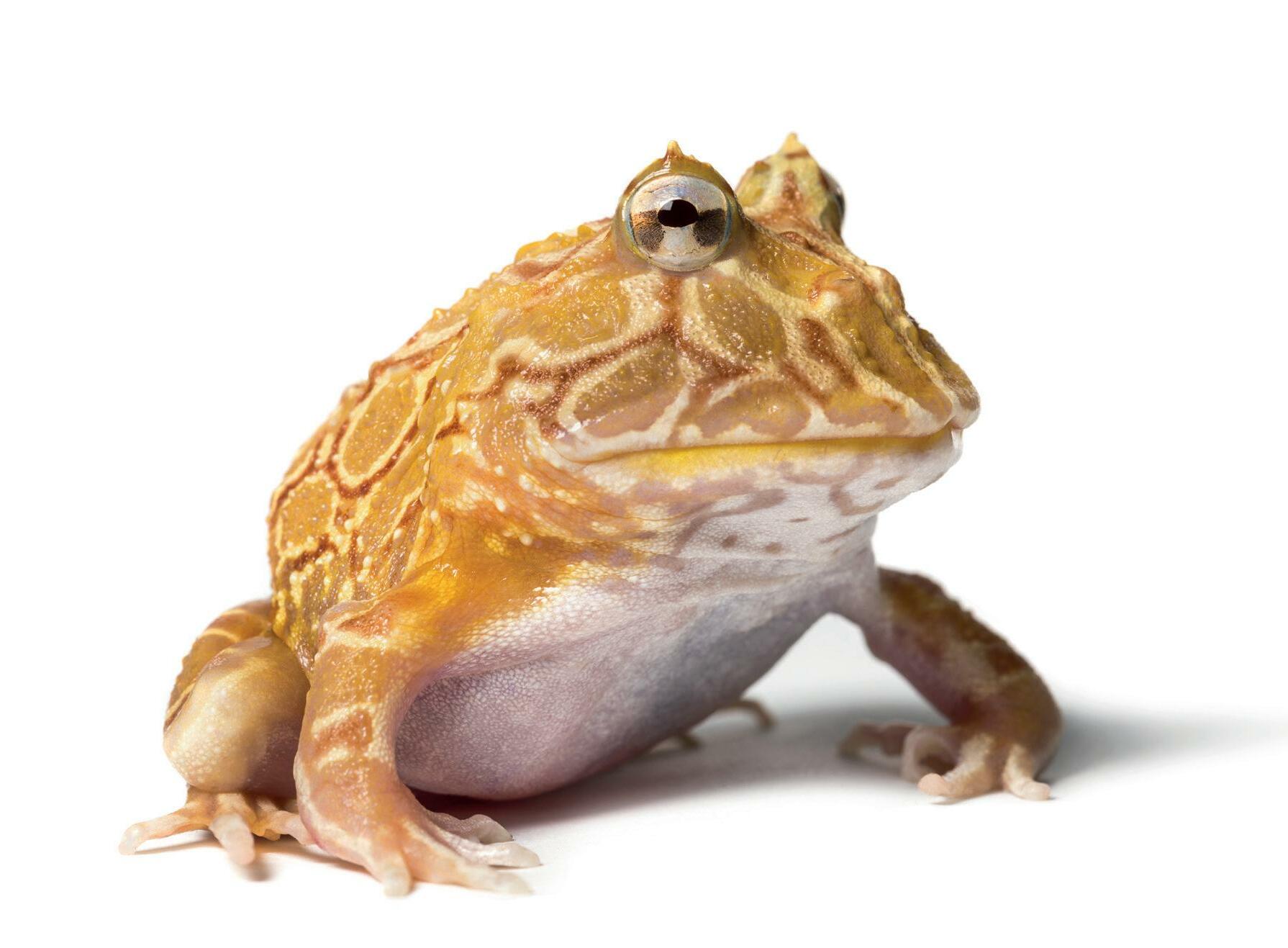
Of course, in captivity, we’re also seeing things begin to stir. Keepers should be extra vigilant as their animals awaken from hibernation and brumation and consider stocking up on appropriate supplements for this delicate period. If an animal is showing any signs of ill health, it’s a good idea to arrange a vet visit ASAP. This brings us on nicely to introducing our newest Exotics News Section sponsor, British Pet Insurance. We couldn’t think of a better fit for EK than an insurance policy to help safeguard our much-loved animals.
Subscriptions
We have also managed to make our first charitable donation this year. APOPO is an organisation saving lives across the world by training rats to sniff out landmines and tuberculosis. So far, the charity has saved hundreds of thousands of lives whilst simultaneously changing perspectives on rodents across the world.
team and work to get magazines printed and sent to our depot for the first of each month. At this point, we begin running adverts on social media but also send the magazines out to our mailing house on the same day. This means that although subscribers will always get their magazines first, weekends and bank holidays can easily push the arrival date into the second week of the month. As always, we are available via email or social media to respond to any queries and questions.

you,
Follow us
Every effort is made to ensure the material published in EK Magazine is reliable and accurate. However, the publisher can accept no responsibility for the claims made by advertisers, manufacturers or contributors. Readers are advised to check any claims themselves before acting on this advice. Copyright belongs to the publishers and no part of the magazine can be reproduced without written permission.

. . . . . . . . . . . . . . . . . . . . . . . . .
EDITORIAL: Thomas Marriott Aimee Jones DESIGN: Scott Giarnese Amy Mather
Front cover: Ornate horned frog (Ceratophrys ornata) Right: Cranwell’s horned frog (Ceratophrys cranwelli)
Thank
Thomas Marriott Features Editor

AVAILABLE NOW Pinkies 1g+ | Pinkies 1g+ | Pinkies 1g+ | Large Pinkies 2g+ | 10 Pack Large Pinkies 2g+ | Large Pinkies 2g+ Fuzzies 4g+ | Fuzzies 4g+ | Fuzzies 4g+ | Hoppers 6g+ | Small 10g+ | Small/Medium 15g+ | Medium 19g+ Medium/Large 23g+ | Large 26g+ | Extra Large 30g+ Ex-Breeder 35g+ | Ex-Breeder 40g+ Rat Pups 4g+ | Fuzzies 12g+ | Hoppers Small 20g+ | Weaner Small 30g+ | Weaner Medium 50g+ Weaner Large 70g+ | Small 100g+ | Small/Medium 130g+ | Medium 160g+ | Medium/Large 200g+ | Large 250g+ Extra Large 300g+ | Jumbo 350g+ 5 pack | Ex-Breeder 400g+ | Ex-Breeder 450g | Ex-Breeder 500g
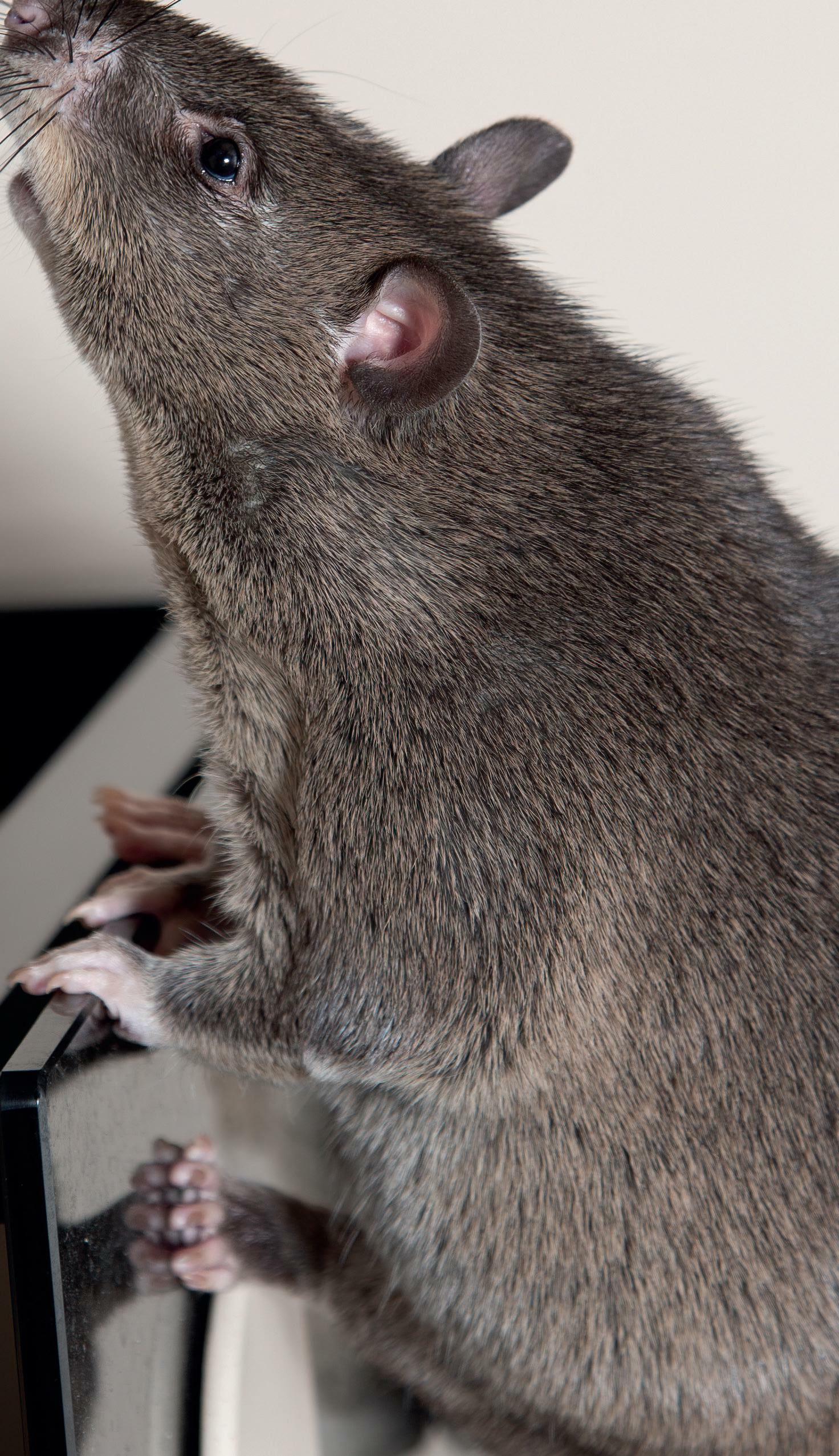
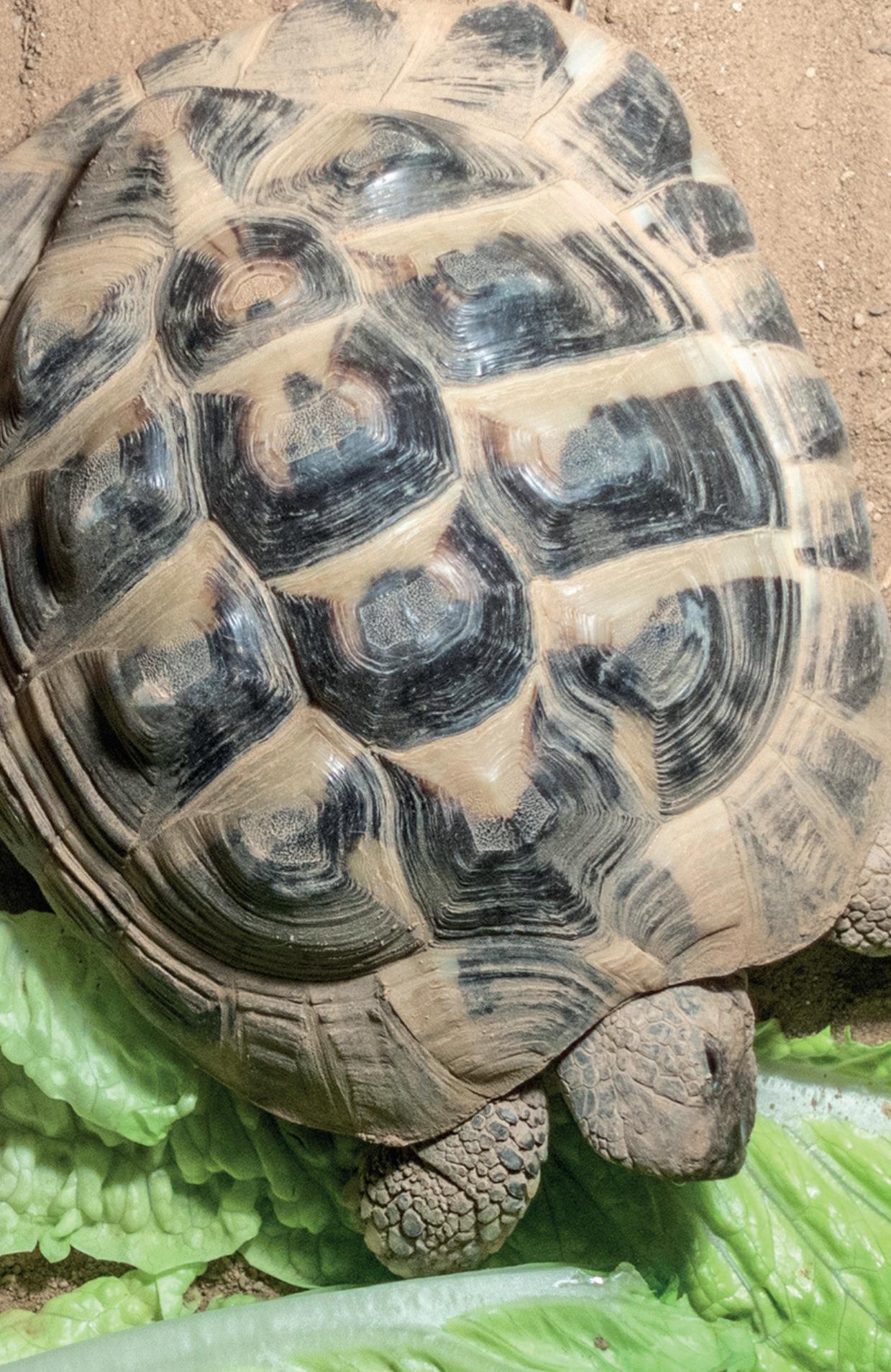
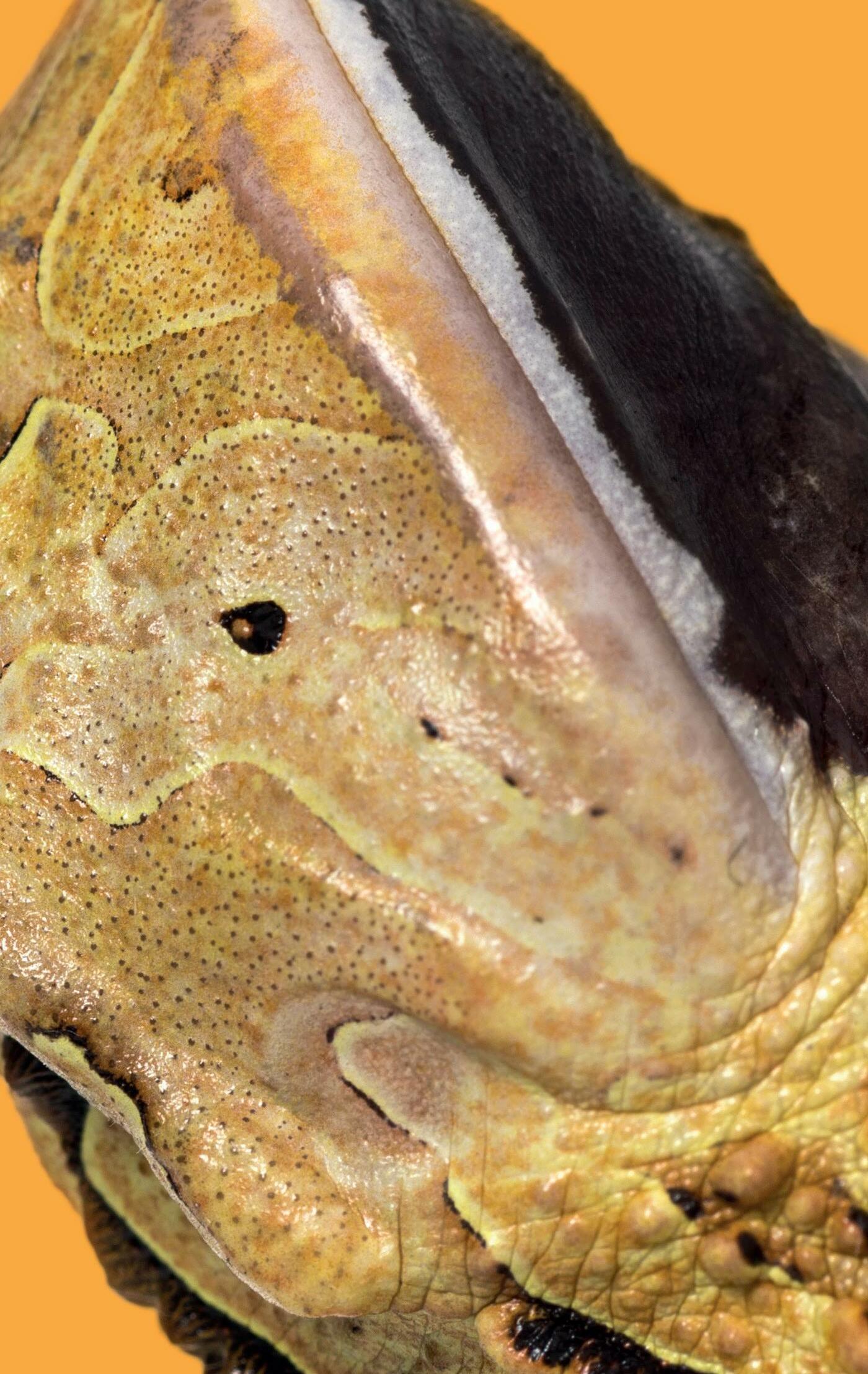

02 06 16 02 EXOTICS NEWS The latest from the world of exotic pet keeping. 06 NEW HIGH SCORE Perfecting pacman frog care.. 14 SPECIES SPOTLIGHT Focus on the wonderful world of exotic pets. This month it’s the Sun spider (Galeodes sp). 16 ETHICAL FISHKEEPING Are fish overlooked when it comes to animal welfare? 24 A HERO OF GIANT PROPORTIONS How many other exotic pets have saved tens of thousands of lives? 31MISUNDERSTOOD MONSTERS A look at the relationship between man and (Gila) monster. 37 KEEPER BASICS: The EK guide to lighting. 45 FASCINATING FACTS Did you know...? 46 ENRICHMENT IDEAS Monthly tips on how to enrich the life of your pet. 24 31 37
EXOTICS NEWS
The latest from the world of exotic animals
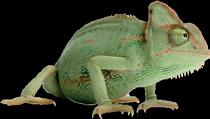
Chester Zoo in February 2021. They all settled well and began breeding in November 2021 with the first two calves being born. This was followed by a third birth on January 22nd 2022. These births take the herd up to seven animals.

Island tree boas (Chilabothrus granti) as part of their captive breeding project. As one of the most endangered members of the Boidae family, the project aims to form a captive population whilst directing in-situ conservation and evaluating the scope of reintroduction.
Penguin Losses at Dudley Zoo & Castle
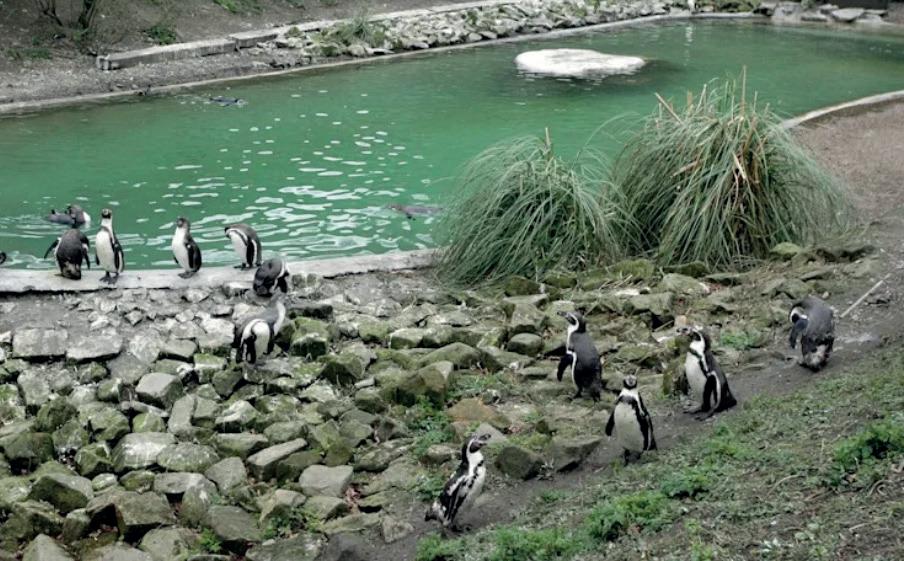
In January the zoo announced the sad news that 50 out of its 69 Humboldt’s penguins had tragically died of Avian Malaria. This accounted for 70% of the breeding colony – which, for 30 years, had been the best breeding colony of this species in the U.K. since it began in 1991 with five hand-reared birds.
Avian malaria is a parasitic disease spread by mosquitos. In the U.K. seasonal and environmental / weather conditions, such as global warming, may play a part in the increased risk of this disease occurring and penguins are particularly prone to contracting it.
The disease is highly contagious and very hard to spot in the early stages; in recent years the penguin colonies at Longleat and Marwell Zoo were also badly affected and it is always very devastating for all involved when these instances occur.

Javan Bantengs Born
As part of the EAZA (European Association of Zoos & Aquaria) priority breeding programme, four Javan banteng were brought to the park. A young male “Henky” arrived from the Royal Burgers Zoo in the Netherlands, in late 2020. He was joined by three females “Dewi”, “Anisa” and “Jin” from
Longleat
Have achieved a first European breeding of the Southern koala (Phascolarctos cinereus cinereus), the joey, born six months ago, has now emerged from the pouch of female “Violet”, the offspring was sired by male “Burke” - taking the group up to four.
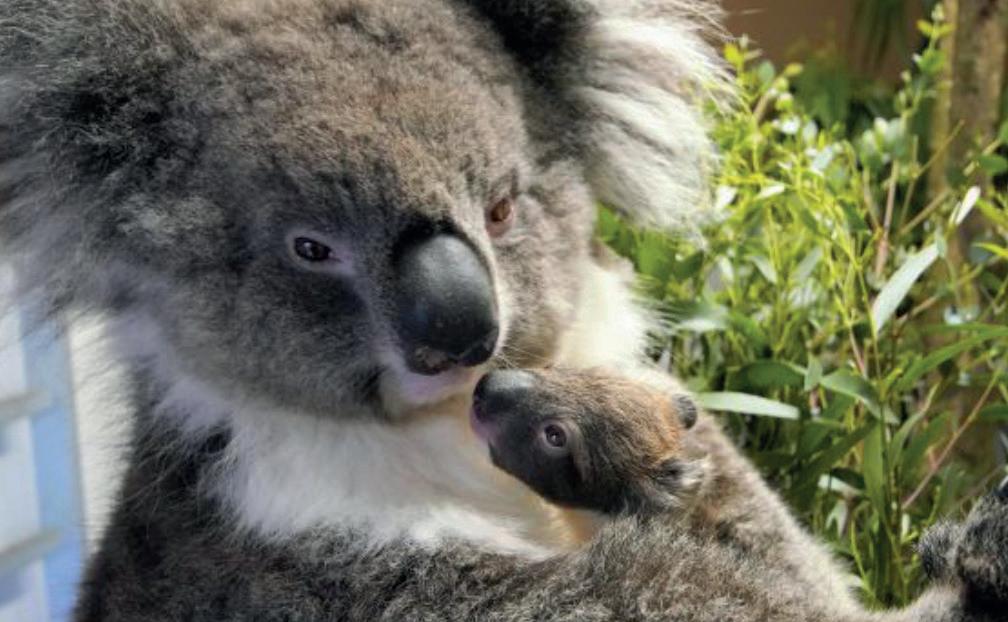
Virgin Island tree boas born in captivity
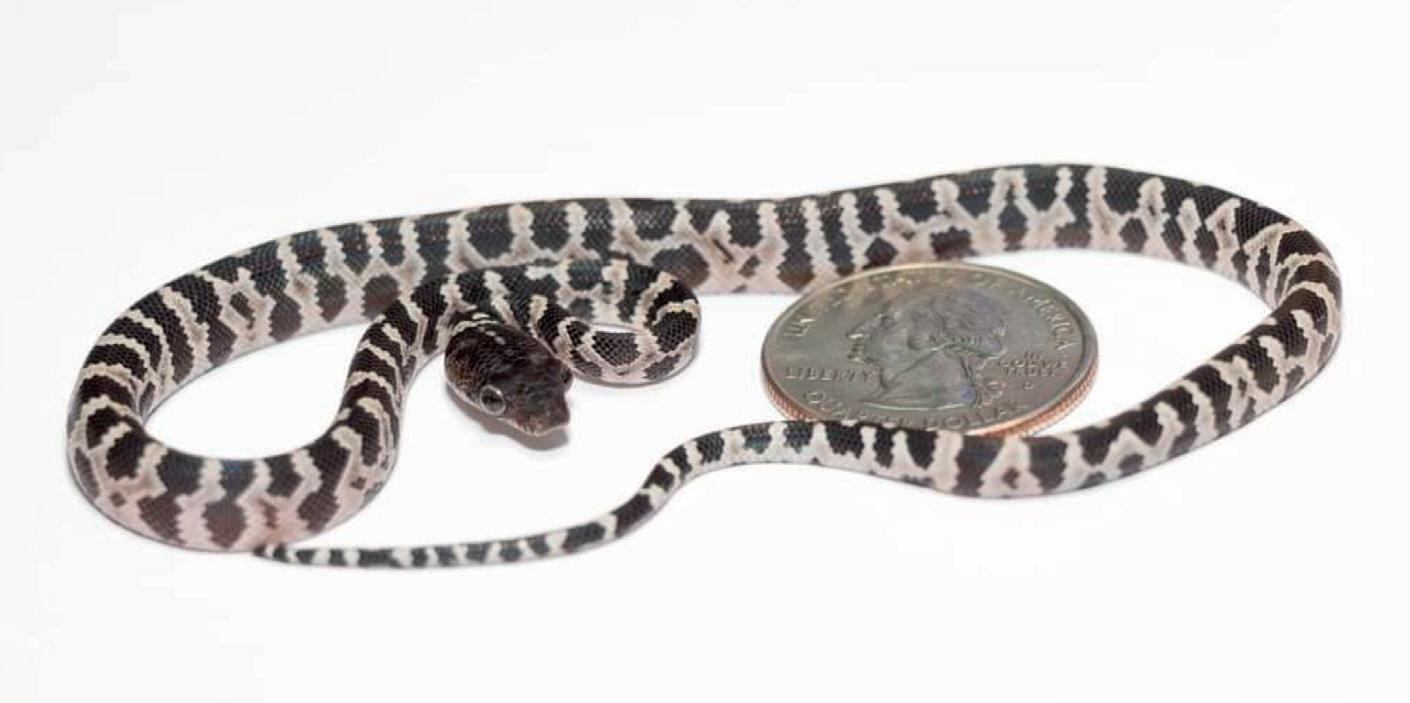
Saint Louis Zoo in Missouri, USA has recently produced four hatchling Virgin
The Virgin Islands tree boa is restricted to just six fragile populations across Eastern Puerto Rico and neighbouring islands. Classified as “Endangered” by the IUCN in 2015, the species has been on the conservation radar for many years. The species is threatened by invasive species, as well as humananimal conflicts. Currently, in-situ education programmes are aiming to change public attitudes towards the feared, yet harmless snakes.
Saint Louis Zoo, in partnership with North Carolina Zoo and United States Fish and Wildlife Service (Caribbean) are at the forefront of implementing the recovery plan for the species. Two pairs were born this year, bringing the total number to four. The young snakes weighed just 3.5 grams at birth and represent a small step towards protecting the longevity of the species.
2 MARCH 2022 Exotics News
©Saint Louis Zoo
©Dudley Zoo & Castle
©Ian Turner
Oldest Primates
Ozzie, the world’s oldest male gorilla, and the third-oldest gorilla in the world, has died at Zoo Atlanta, aged 61. The 350-pound western lowland gorilla’s cause of death is not yet known, the zoo said. “Ozzie was considered a true legend at the zoo and was the only surviving member of the original generation of gorillas who arrived with the opening of its Ford African Rain Forest in 1988”.

Zoo staff noticed a decline in Ozzie’s appetite, but they were encouraging him to eat, and were treating him when he presented symptoms including facial swelling, weakness, and an inability to eat or drink.
Ozzie has more than 20 descendants, some of which still live in the zoo whilst the rest of his offspring live at other accredited zoos in the US and Canada.
the first ichthyosaur of its species (Temnodontosaurus trigonodon) found in the country. The ichthyosaur was discovered by Joe Davis, Rutland Water Conservation Team Leader, during the routine draining of a lagoon island for re-landscaping in February 2021. He said; “The find has been absolutely fascinating and a real career highlight, it’s great to learn so much from the discovery and to think that this amazing creature was once swimming in seas above us, and now once again Rutland Water is a haven for wetland wildlife albeit on a smaller scale!”
The ichthyosaur is approximately 180 million years old and, with a skeleton measuring around 10 metres in length and a skull weighing approximately one tonne, it is the most complete large ichthyosaur ever found in Britain. Ichthyosaurs first appeared around 250 million years ago and went extinct 90 million years ago. They were an extraordinary group of marine reptiles that varied in size from 1 to more than 25 metres in length, and resembled dolphins in general body shape.
Largest Ichthyosaur found in U.K
The fossilised remains of Britain’s largest ichthyosaur, colloquially known as a ‘Sea Dragon’, was discovered at Rutland Water Nature Reserve, which Leicestershire and Rutland Wildlife Trust manage in partnership with Anglian Water.


It is the biggest and most complete skeleton of its kind found to date in the UK and is also thought to be
The fragile remains of the huge skeleton were carefully excavated in August and September 2021 by a team of expert palaeontologists assembled from around the UK, in partnership with Anglian Water, Rutland County Council and Leicestershire and Rutland Wildlife Trust. The excavation was led by world ichthyosaur expert Dr Dean Lomax and specialist palaeontological conservator Nigel Larkin, along with marine reptile specialist Dr Mark Evans, Dr Emma Nicholls from the Horniman Museum and volunteers with experience of excavating fossilised marine reptiles.
The discovery is not the first at the Anglian Water reservoir, with two incomplete and much smaller ichthyosaurs found during the initial construction of Rutland Water in the 1970s. It is however the first complete skeleton to be discovered there.
3 MARCH 2022 Exotics News
©Anglian Water
©Anglian Water
©Zoo Atlanta
Record Venom Sample
A deadly Australian snake released a record sample of venom with the potential to kill up to 3,000 healthy human adults. Keepers at the Australian Reptile Park in Somersby, New South Wales, filmed the Coastal Taipan snake releasing a 4.9-gram sample from his fangs - breaking his previous personal record of 4.5 grams. The reptile was milked as part of the zoo’s antivenom program. Zookeeper Zac Bower extracted three times the normal amount for this species of snake. The park said the newly extracted venom will be used to create antivenom to save Australian lives across the country.
New Lizards Found
Two new species of lizard – one skink and one gecko species, have been found in the Mataura Range in Southland and in Nelson Lakes National Park, on the South Island in New Zealand. They are both new to science, but are yet to be fully described.
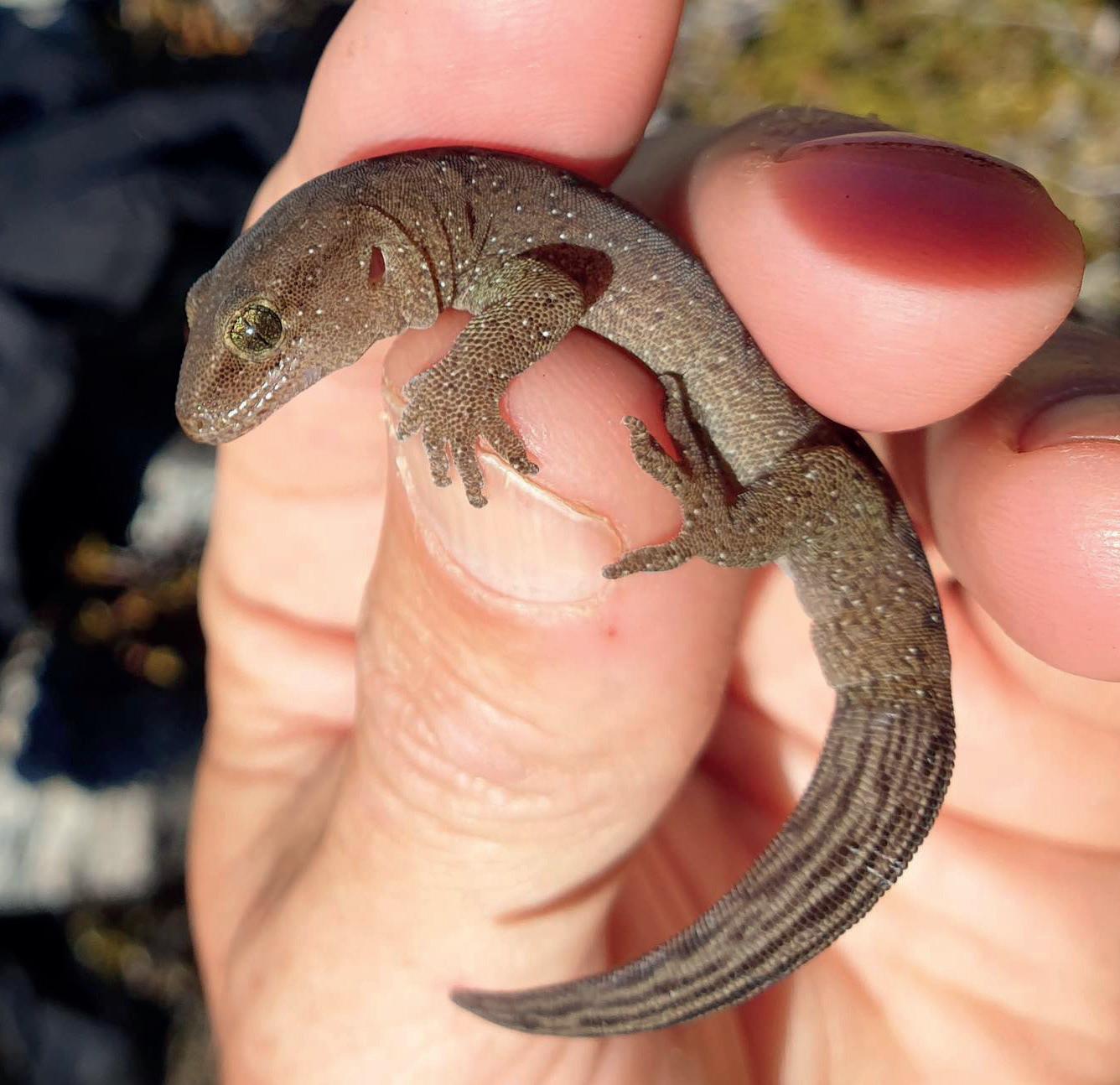
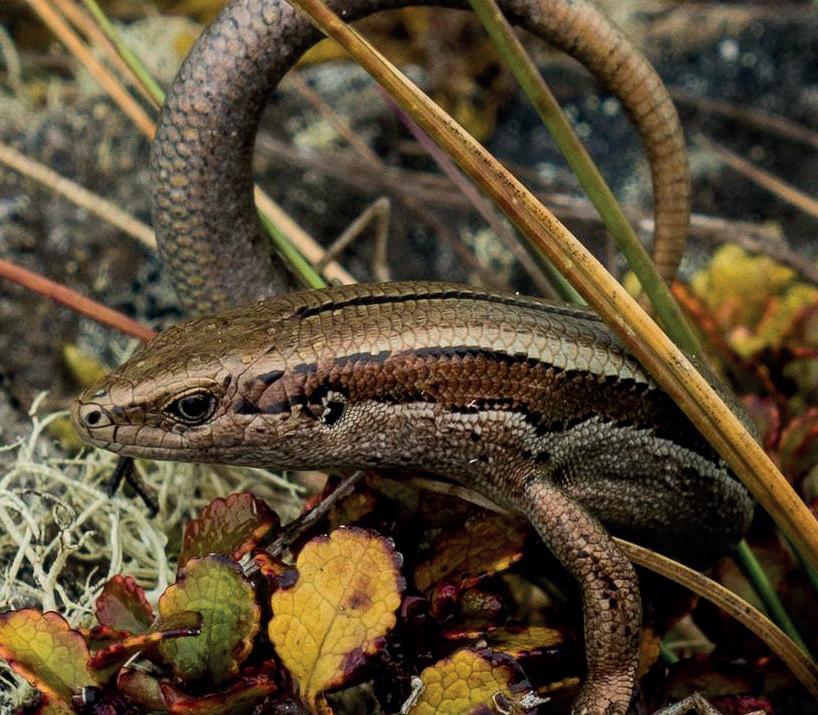
Genetic tests have confirmed the new species from discoveries made during Department of Conservation surveys in South Island alpine areas last summer. Further surveys will help to learn more about them, and determine their conservation status and how to manage them.
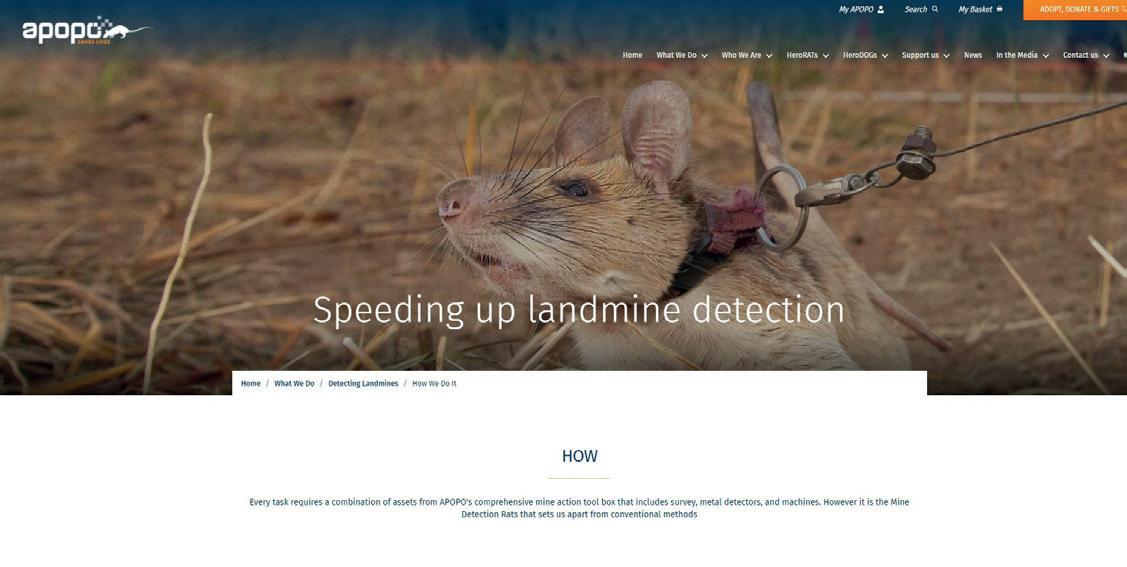
Science adviser and lizard survey project leader, Dr Jo Monks, said the intensive lizard surveys are unearthing lizards in our least explored places. “We’re still in the age of discovery for our lizards, and we’re likely to find more as we continue our survey work this summer. “Over the past 30 years, the number of known lizard species has increased nearly four-fold with new discoveries”, she said. Several new populations of cryptic skinks, Eyre`s skinks and cascade geckos were also confirmed.
New Zealand has 126 gecko and skink species, counting the two new ones, found nowhere else in the world.
Collated and written by Paul Irven.
4 MARCH 2022
Each month we highlight a favourite website or social media page THIS MONTH IT’S: APOPO APOPO addresses global issues through research, development and deployment of scent detection technology at its training and research center in Tanzania and seven other countries. www.apopo.org/en ON THE WEB Websites | Social media | Published research Exotics News
A Mataura Range skink ©Carey Knox
Gecko found in the Nelson Lakes National Park ©Ben Barr
T5 UNITS ECO




























The new Eco T5 units come supplied with next generation UVB tubes, designed to replicate the profile of sunlight.











Available in three Ferguson Zones and three sizes, each unit comes with a removable 103° reflector to provide a powerful wide spread of light.




MARCH 2022
NEW HIGH SCORE
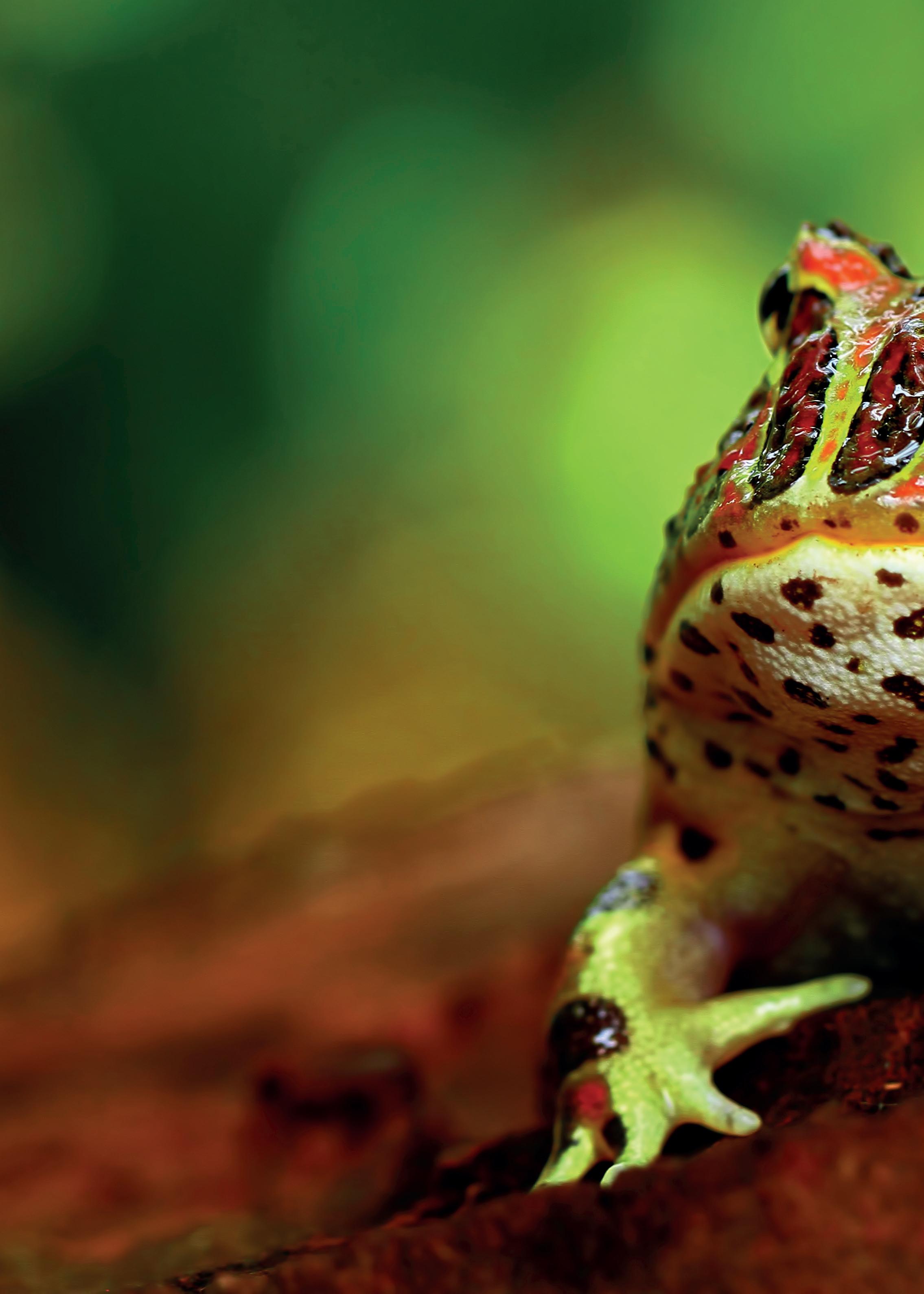
6
Perfecting pacman frog care.
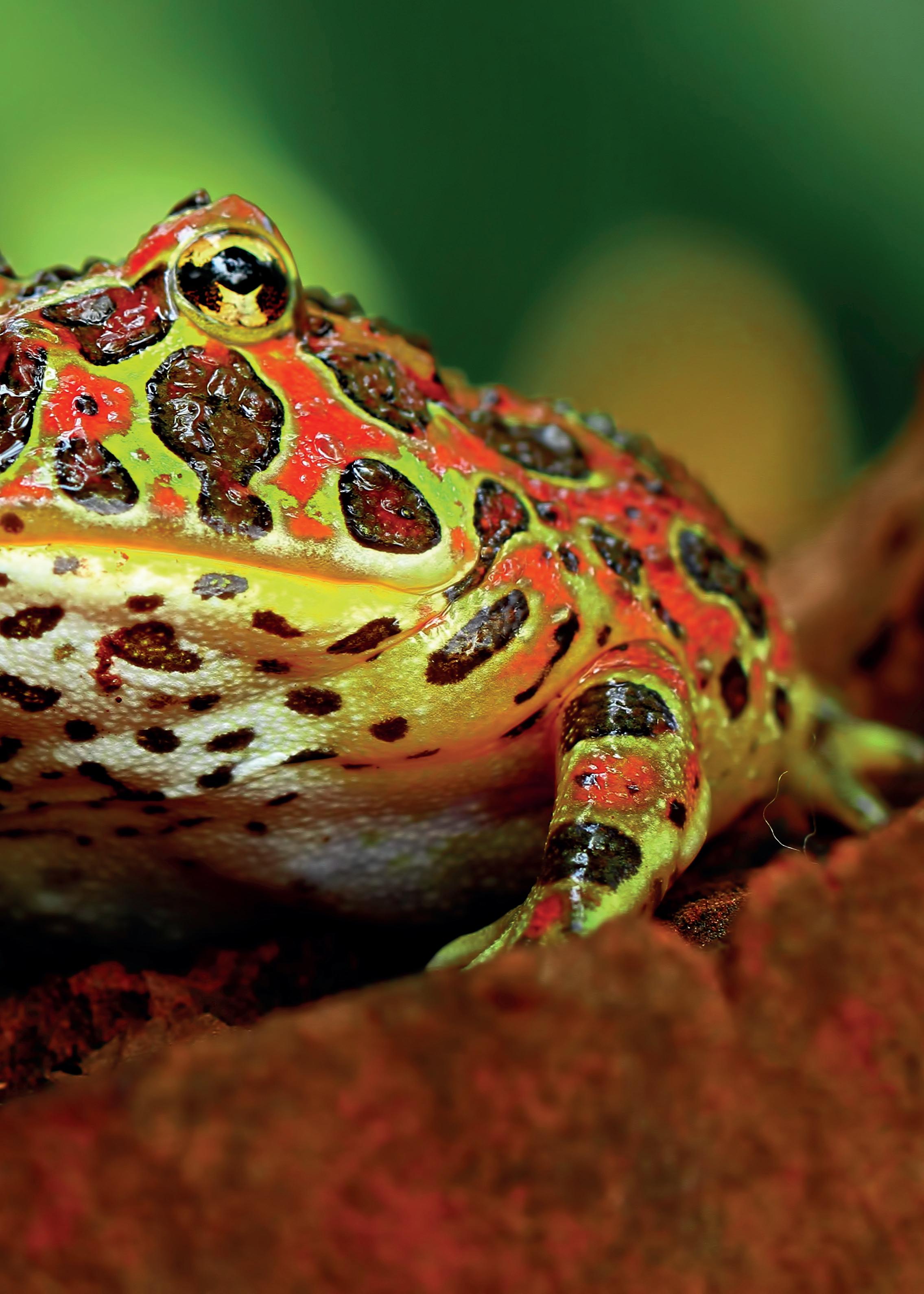 Red ornate pacman frog (Ceratophrys ornata)
Red ornate pacman frog (Ceratophrys ornata)
Affectionately named ‘pacman’ frogs for their rotund bodies, huge mouths and insatiable appetites, horned frogs are easily some of the best pet frogs available. Their straightforward care requirements and comedic characteristics make them popular first pets, but has this hardy reputation impacted the way we keep horned frogs?
Cranwell’s horned frog
There are eight separate species of horned frog, all belonging to the Ceratophrys genus and coming from different parts of South America. Several species are reasonably well-established in the hobby, but C. cranwelli, takes the top spot for its rich spectrum of colours and morphs available. C. cranwelli was previously thought to be synonymous with C. ornata, but several morphological differences allowed researchers to distinguish the two. Now, with limited genetic diversity, the Ornate or Bell’s horned frog (C. ornata) is much less frequently produced.
The main appeal of horned frogs in captivity, aside from their ‘cute’ personalities as froglets, is their ease of care. As a predominantly fossorial species, horned frogs do not require much space when compared to other amphibians. However, they will sometimes leave their burial spot at night and as a fast-growing species, must be given appropriately sized enclosure upgrades. These frogs generally reach sexual maturity at around two years old.
Unlike C. ornata, which is found in the tropical Amazon, the Cranwell’s horned frog comes from the Chaco region
of South America. There is indeed some overlap between their distributions, but the Ornate horned frog inhabits the tropics of the North, whereas Cranwell’s horned frogs prefer the plains of the South. The Chaco is a dry savannah that stretches across Argentina, Bolivia, Brazil, and Paraguay. With many keepers linking South America with tropical rainforests, it is understandable that this is the most common misconception to cause husbandry errors. Keepers should simulate the natural environment of C. cranwelli by providing much drier conditions than most South American amphibians in the hobby are accustomed to.
The keeper should spray the enclosure just enough to keep the substrate moist. Being fossorial, the ambient humidity does not need to be monitored quite as rigorously. The Chaco region experiences low humidity (and sometimes frosts) during the dry season and over 70% humidity (and 35°C+ temperatures) in the wet season. This makes Cranwell’s horned frogs extremely adaptable and an average of 50% humidity to be optimal, though experienced keepers could experiment with some seasonal fluctuations. For keepers who have a different species of
8 MARCH 2022 New High Score
horned frog, humidity should be kept consistently higher, with a heavier spray and moister substrate.
Cranwell’s horned frogs are often observed in ephemeral (short-lasting) pools but never in semipermanent ponds.
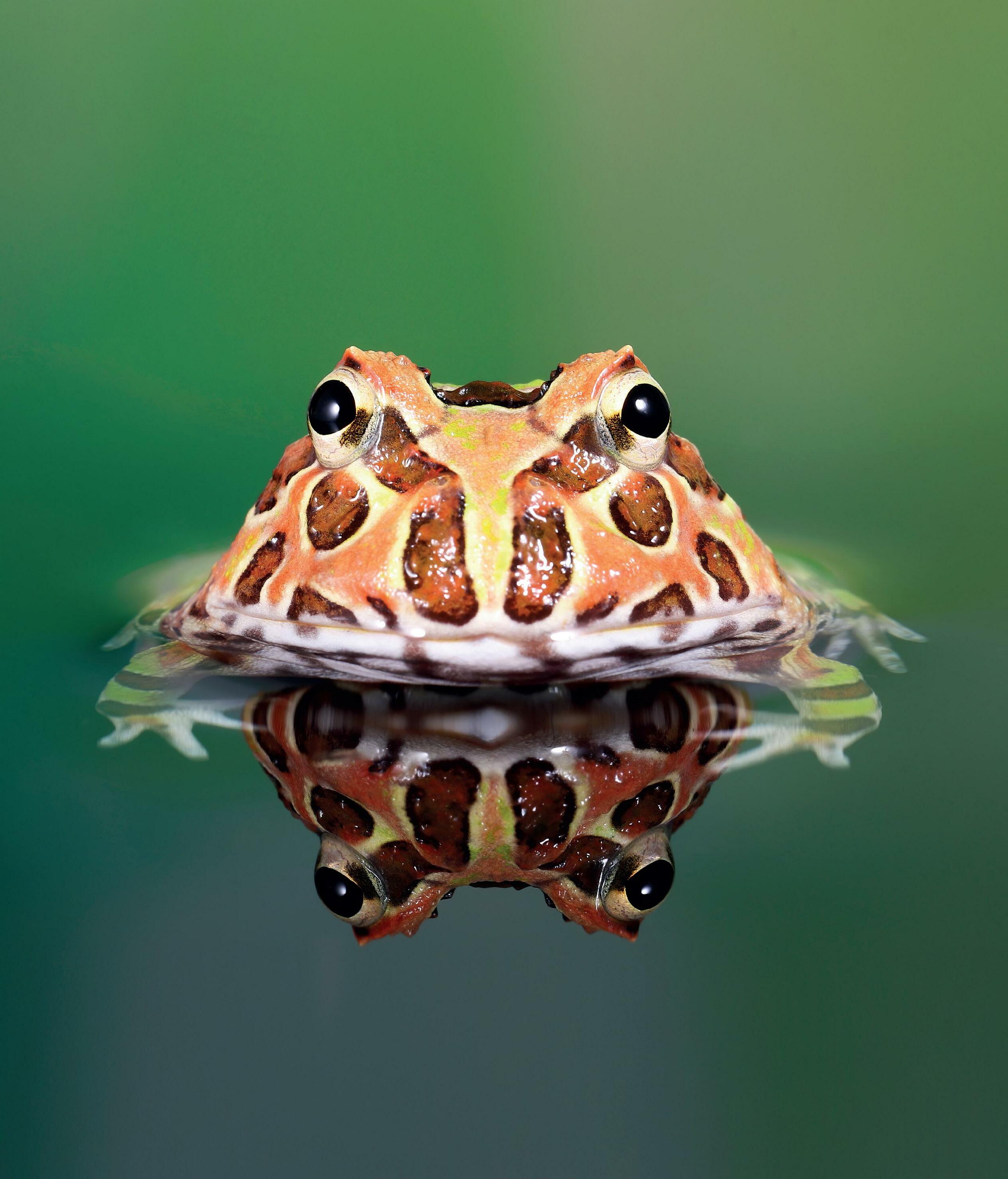
It is, therefore, a good idea to provide a large shallow
water-bowl, although an aquatic area is not necessary. This contrasts the horned frogs’ closest cousins, the Budgetts frogs (Lepidobatrachus sp.) which will spend long periods submerged in water. Horned frogs will often use a water bowl to assist with shedding, so keepers should be vigilant to remove shed skin and other debris from the bowl.
9 MARCH 2022
Cranwell’s horned frog (Ceratophrys cranwelli)
Let there be light
As a burrowing species, horned frogs would generally receive only a small amount of sunlight, but in an open savannah environment, these short bursts will still provide some UV. Therefore, providing Ferguson Zone 1 lighting is likely to be beneficial. However, keepers should be considerate in providing some cover from the overhead light in the form of sturdy, broad-leaved plants (real or artificial). This is especially true for keepers of albino horned frogs, as these animals will typically be more sensitive to UV. As well as providing shelter, keepers can reduce the UV exposure (by around 30-40%) of their animal by using a mesh cover on the top of the enclosure.
Another common mistake is the use of heating. Because horned frogs need to be kept warmer than the average home, heat mats are commonly used to push the temperature up. However, the unnatural concept of heating from below means that burrowing species, who often use their digging behaviour to avoid the hot sun, end up digging towards the heat. Instead, if a heat mat is used, it should be applied to the side of the enclosure. Heat cables can also be used strategically to provide heat from different angles. Of course, a well-insulated glass enclosure with a lighting fixture will naturally raise the temperature, so new keepers should record the ambient temperature of the enclosure for a few days prior to acquiring their frog.
It should also be noted that substrate should be very deep. Most keepers will know that this is a burrowing species, but substrate should allow for the frog to bury itself completely out of sight if it wishes to. Although they will typically keep their mouth and eyes above the ground looking for a tasty morsel of prey, these slow-moving animals will dig deeper to avoid predators and the extra few inches of substrate will ensure the frog feels safe and secure. Previously, coir was the substrate of choice but as a material that can easily dry out, get stuck to the animal’s skin and potentially be ingested, a bioactive forest substrate such as Bio Life is much more appropriate.
Voracious predators
Horned frogs will eat almost any living thing they can fit into their mouths. Although limited, literature on this species’ wild diet has discovered that several frog species are commonly eaten (Leptodactylus bufonius, Physalaemus biligonigerus and P. albonotatus). In captivity, a diet comprised mostly of insects would be preferable. However, keepers have an excellent opportunity to provide some enrichment through a varied diet.
As a food-motivated species, one of the best ways to interact with a pet horned frog is through treats. Shrimps, chopped fish, appropriately sized rodents, earthworms, waxworms, silkworms, etc will all be readily accepted. Of course, these foods are generally high in fat, so ensuring they are spaced out through an appropriate feeding schedule is important. Young frogs should be fed daily, but as they grow, this frequency should be reduced. It should also be noted that if the temperature of the enclosure is much cooler than 25°C, it can prevent young frogs from feeding. Therefore, it is vital to ensure all the conditions are met, before introducing a baby horned frog into an enclosure.
Some keepers also opt to feed their frogs in a separate enclosure to avoid the animal ingesting substrate. While this is not entirely necessary (especially if the frog is tongfed), it does offer a new safeguarding measure and allows the keeper to do a quick visual health check. Furthermore, bathing the frog for 5 minutes in room temperature, de-chlorinated water will allow the frog to remove its skin, as well as any debris that might be stuck to them and prompt them to go to the toilet without creating a mess in their water bowl. This is a popular feeding routine for breeders or those with lots of animals to maintain.
Horned frogs can eat vertebrates of their own size due to their disproportionate head and incredible bite force. In a 2017 study, Lappin et al discovered that horned frogs (Ceratophrys sp.) bite with ~5 to 500N of force at the jaw point. This is much more in line with amniotes (reptiles,
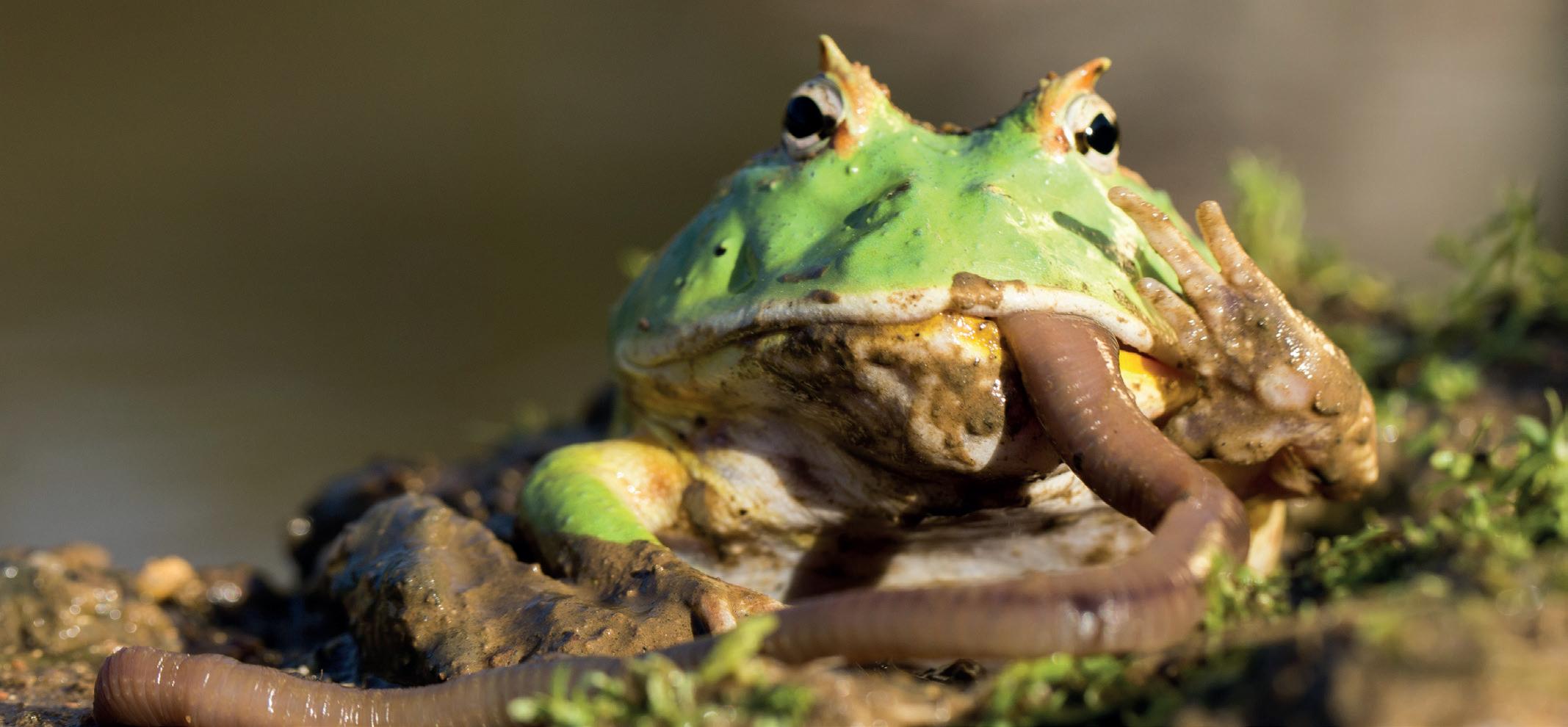
10 MARCH 2022 New High Score
Argentinian horned frog (Ceratophrys ornata)
birds and mammals) than amphibians. It also suggests that primitive amphibians such as the menacing devil frog (Beelzebufo ampinga), thought to be the largest frog that ever lived, would have had a similar bite force, and fed on hatchling dinosaurs. Aside from its 41cm length, the devil frog is morphologically very similar to today’s horned frogs, but as its remains have only been found in Madagascar, scientists are still trying to join the dots.

Maintenance and care
During the cold months, horned frogs may go into estivation. While this can be avoided by maintaining consistent temperatures (around 26°C), new keepers should be aware that this is completely normal. The frog will develop a hardened layer of skin to retain moisture through the winter months and should not be disturbed while they are in this phase. Gently increasing the temperature and humidity over a few days should bring them out of estivation. New keepers should also be warned that frogs also shed their skin naturally as they grow.
If you want a job done properly…
New High Score
Non-bioactive enclosures should be cleaned entirely every week, digging out all substrate to remove any waste. Horned frogs will frequently use their burrows and water bowl to defecate and so keepers should keep to a strict cleaning schedule even if they cannot see any obvious mess. Bio-active enclosures may require slightly less maintenance, but the horned frog’s ravenous appetite adds a new challenge of keeping the clean-up crews alive. In this case, picking a clean up crew too small to be considered a snack is a good idea (i.e springtails or white dwarf isopods).
As ambush predators, horned frogs are some of the few species that may benefit from a smaller enclosure, particularly as juveniles. Introducing a baby horned frog into a very large terrarium with just one or two prey items can mean the frog could be waiting a very long time to eat. This can be avoided by feeding in a separate enclosure, or by ensuring the main enclosure is size-appropriate for the animal to feed. Compressing substrate so it is firm enough to ensure small prey items remain on the surface is also a good way of supporting a frog’s feeding behaviour.
11 MARCH 2022
Cranwell’s horned frog (Ceratophrys cranwelli)
DID YOU KNOW
Cranwell’s horned frogs can make sounds, even as tadpoles. It is widely believed that the vocalisations from these tadpoles (between Gosner stages 25 and 42) are used to avoid predators and tadpoles will create sounds more frequently in a high predator:prey environment.
Breeding horned frogs
Despite their abundance in the hobby, horned frogs are notoriously difficult to breed. They generally experience massbreeding events in the wild, waiting for heavy rainfall before bursting into a breeding frenzy to make the most of the newly formed pools of water across the Chaco. Breeders are required to delicately adjust temperatures across the year, before creating a rain chamber for the frogs.
Due to the nature of their breeding habits, the frogs will typically spawn between 1000 and 2000 eggs each which usually hatch in less than 4 days. Not only will adult frogs eat the spawn, meaning they must be isolated immediately, but the tadpoles are also highly cannibalistic. To combat this, the breeder must feed the tadpoles several times a day with aquatic foods (bloodworms, tubifex, chopped earthworms, etc), before isolating each individual tadpole as soon as possible. Responsible breeders should be aiming for 0 preventable mortalities which is extremely difficult if that person has a day job during the breeding season.
exhibit a yellow/pink colouration. Of the green varieties, there are ‘peppermint’ which are readily available as well as the more recent ‘emerald’ and ‘teal’ varieties in the US. From the peppermint colouration also comes more vibrant blues, as well as ‘chocolate mint’ which (of course) combines brown patterning with a peppermint colour base.
As well as a whole spectrum of colour morphs, some mutations are also prevalent in horned frog line breeding. The most common of these is the ‘four spot’ which is aptly named due to its almost patternless body, possessing just four spots behind its eyes. ‘Samurai’ line frogs are also frequently available in the UK. These animals have gold outlines around their patterning and are some of the more sought-after frogs within the hobby.
Only eight percent of the Cranwell’s horned frog’s distribution is comprised of protected land. Despite them being currently listed as ‘Least Concern’ by the IUCN, there is cause to believe further research is required. This species is often persecuted by people across its home range for falsely believing that it is venomous.
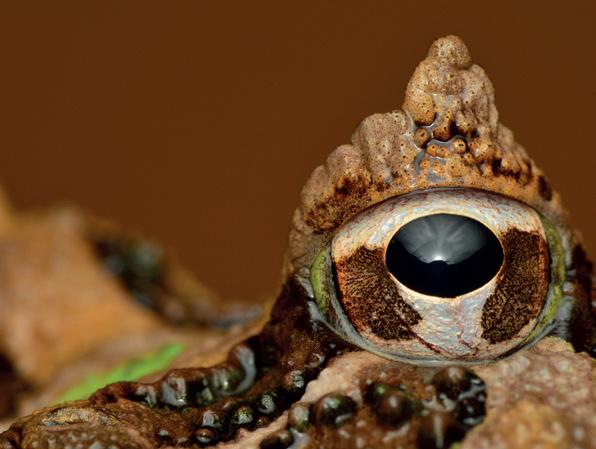
The name Cranwell’s horned frog in in honour of Dr Jorge Cranwell who was the first to identify it as a species separate to C. ornata.
Recently, a study looking at biofluorescence in amphibians discovered that C. cranwelli can create a green glowing pattern when exposed to blue excitation light. This could potentially help with identifying other frogs, finding a mate, camouflaging amongst plants or have no purpose at all.
After 3 to 5 weeks the tails are absorbed, and the frogs become fully-fledged froglets. Providing the breeder is successful and manages to raise 1000 healthy frogs, finding a home for them will no doubt prove difficult. Most horned frogs in the UK are imported from breeding facilities overseas, which have already invested hundreds of thousands of pounds into equipment, full-time staffing, building a reliable network of customers and essentially refining their breeding process. For the hobbyist, the financial outlay of equipment for every life stage of the frogs, time and resources to prevent cannibalism, space for a reservoir of neutral, toxin free water and the ability to find 1000 new homes, means that horned frogs are simply not a viable breeding project.
Morphs and mutations
The Cranwell’s horned frog has many morphs and colour mutations. With only a handful of breeders producing many thousands of horned frogs, the availability of these morphs frequently changes. Albinos are generally the most readily available morphs and from this, there are several ‘strawberry’, ‘apricot’, ‘pineapple’ etc morphs that all
Another popular morph that has recently seen a dip in availability is the fantasy horned frog. This is a hybrid between the Cranwell’s and the ornate horned frog. They have the iconic horns and bulky size of C. ornata whilst possessing the colouration and spaced patterning of C. cranwelli. Exotics Keeper Magazine advises against the hybridisation of species. Fantasy horned frogs, whilst generally healthy animals, cannot reproduce which suggests we should avoid crossbreeding where possible.
The perfect pet?
Horned frogs are easily some of the best pet amphibians. Not only do their natural behaviours lend them to being a manageable pet, but they are readily captive-bred and there is an excellent support network of dedicated keepers for new hobbyists to engage with. Although there are still many mistakes that people can make, ensuring the keeper knows exactly which species they are buying, has already established an enclosure with reliable temperatures and humidity readings and is fully prepared to upgrade the enclosure frequently, horned frogs are an excellent entry-level amphibian. With breeders dedicating huge amounts of time and resources to produce animals for private keeping and medical research purposes, as well as various researchers delving into the natural history of these animals, horned frogs will undoubtedly remain a popular species and inspire new herpetoculturists for many more years.
Title 12 MARCH 2022
12 New High Score
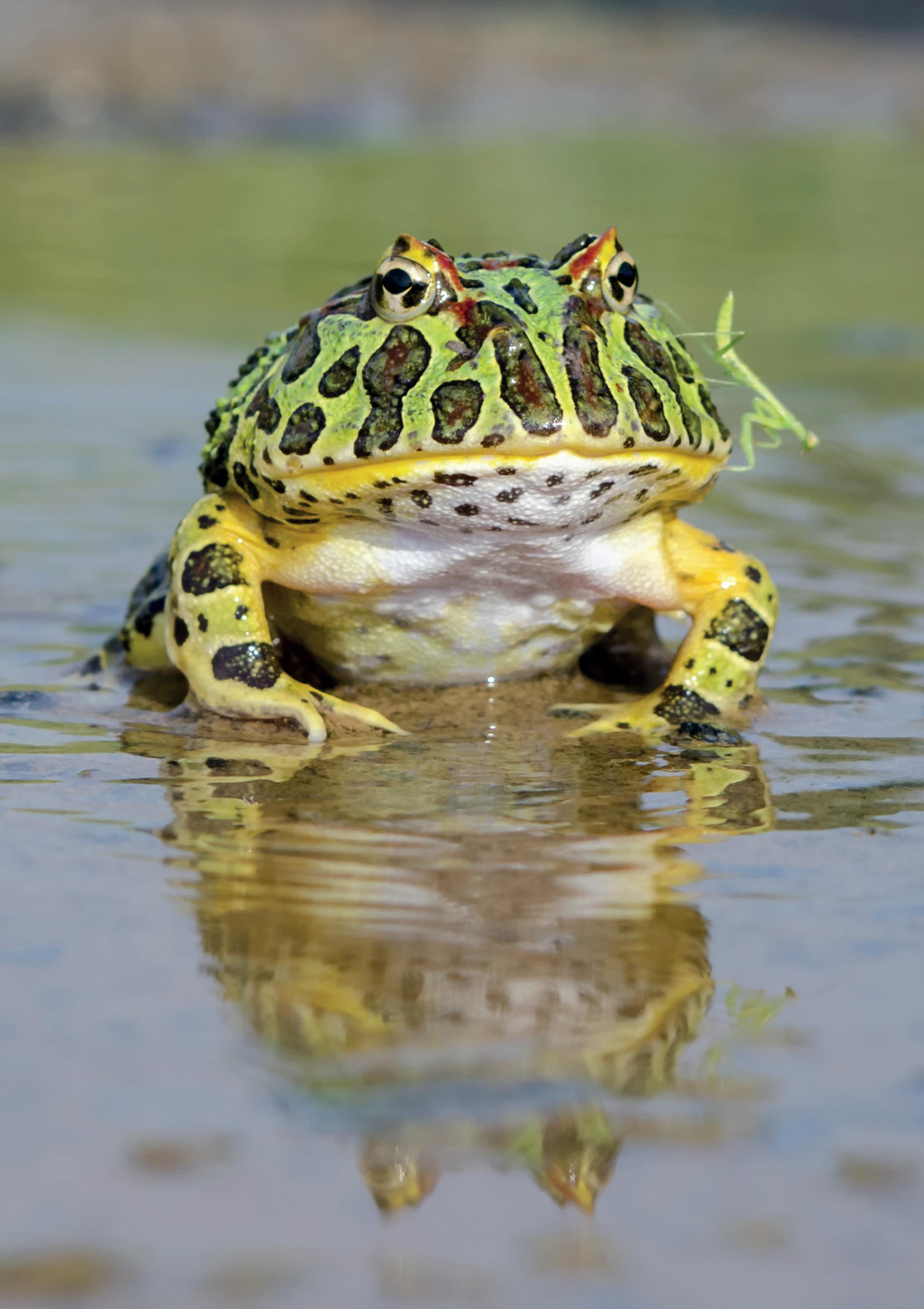 Ornate horned frog (Ceratophrys ornata)
Ornate horned frog (Ceratophrys ornata)
SPECIES SPOTLIGHT

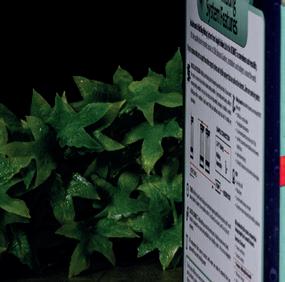






The wonderful world of exotic animals

Sun spider (Galeodes sp)




Sun spiders are an arachnid from the order Solifugae. The sun spiders most found in the hobby belong to the Galeodes genus, along with almost 200 other species. These can be found in Northern Africa and tolerate extreme conditions.
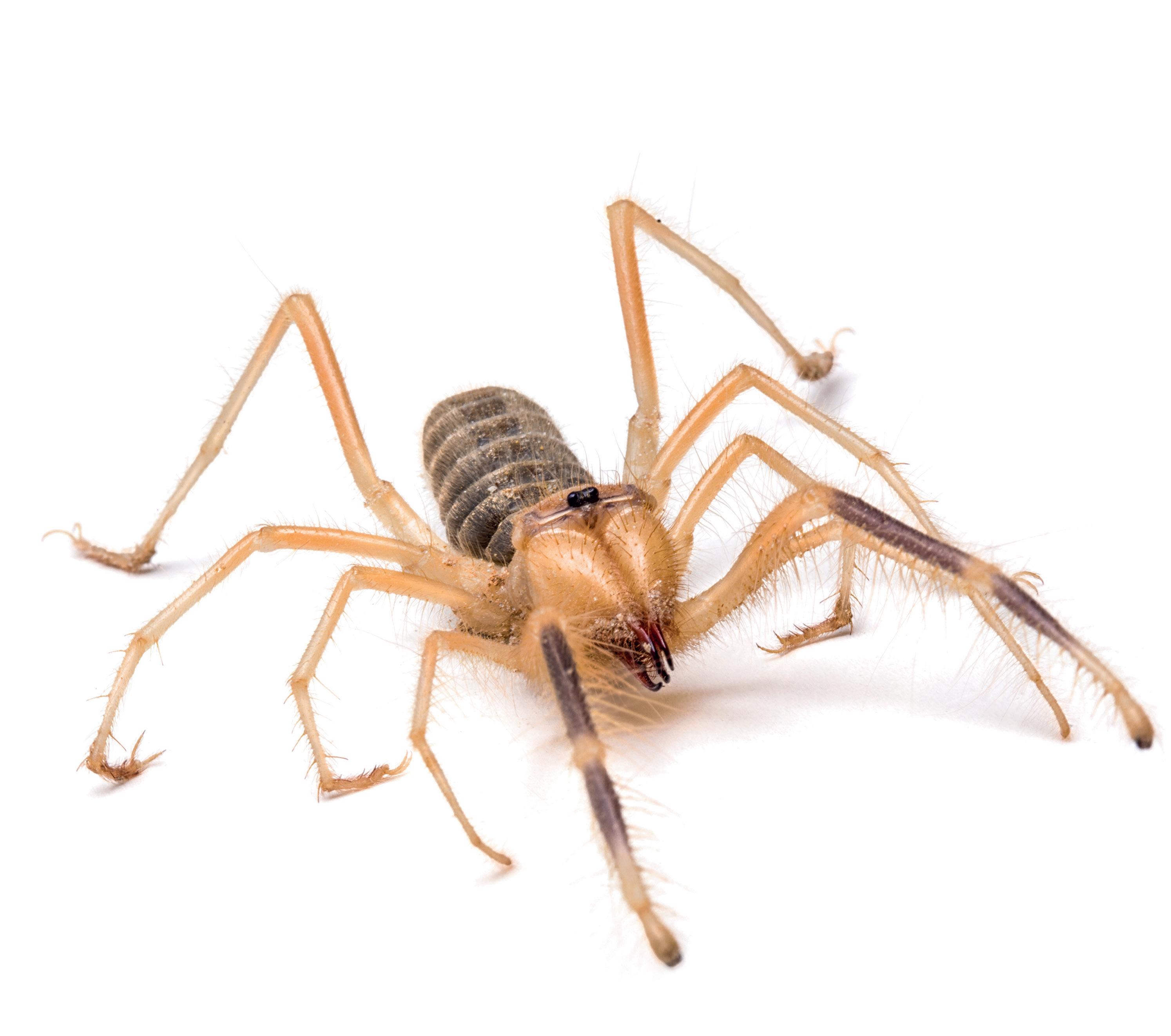




In the wild, temperatures regularly reach up to 44°C, meaning sun spiders opt to burrow deep into the sand during the daylight hours. As such, they should be provided with deep substrate with an ambient temperature above 30°C. Keepers should create an arid enclosure with plenty of open sand and cork bark. Live plants can be used but expect that these arachnids will disperse substrate whilst burrowing, making them quite messy.
Their menacing appearance is matched by a whole string of obscure and unsettling traits. During the night, sun spiders will actively hunt scorpions. Some Galeodes species will also

produce sounds by stridulation which may be an imitation of some viper species. Even the mating rituals of sun spiders are odd. The male will hold the female’s abdomen high in the air, before depositing his spermatogonia into her genitals using his mouth (chelicera).
Galeodes sp. have lots of common names including camel spiders, giant solpugids and sun spiders. While there are lots of sun spider species that can reach more than 15cm, most animals in the hobby are imported as juveniles between 4 and 5cm in length. They are insectivorous and have a voracious appetite, regularly feeding on large crickets. They are cared for in a very similar way to most terrestrial scorpions but with higher temperatures. Their care requirements are reasonably straightforward and can be housed in a glass terrarium, providing all the necessary heating equipment is supplied. However, they should not be considered ‘entry level’ inverts as they are extremely fast-moving animals. In fact, it’s been reported that sun spiders can move at speeds of up to 10 miles per hour.
Species Spotlight
MARCH 2022
Disinfectant Wipe Refill For Everyday Use

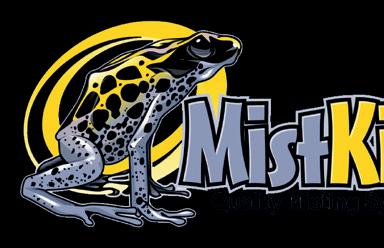






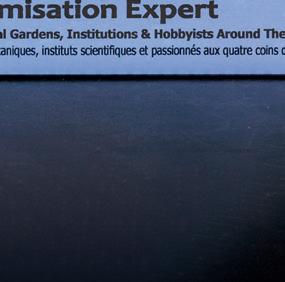
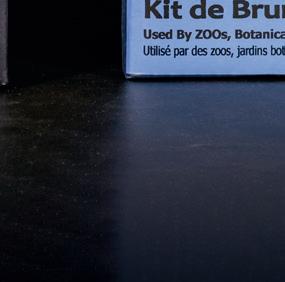
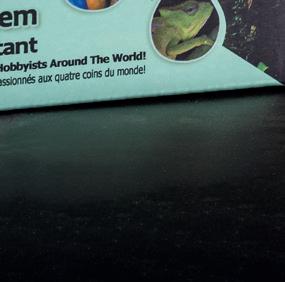
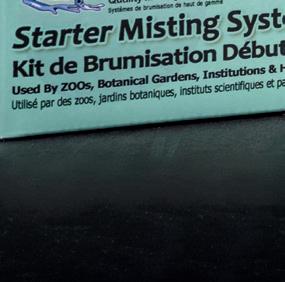

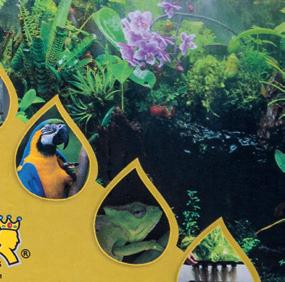
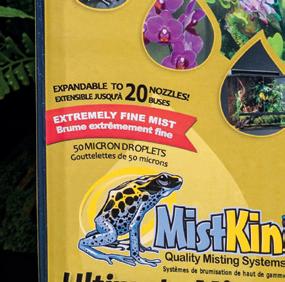
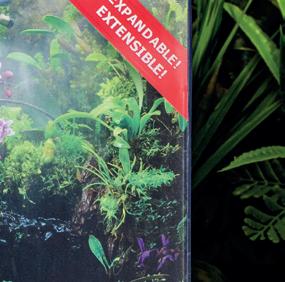
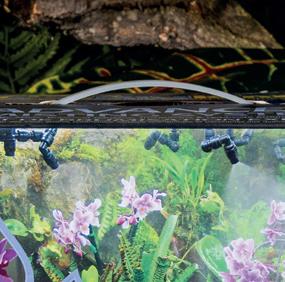




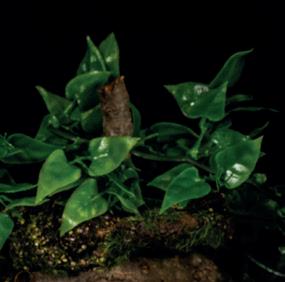
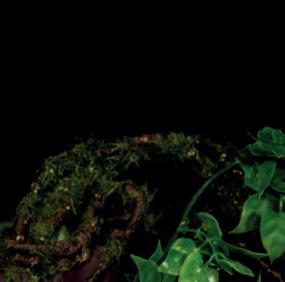
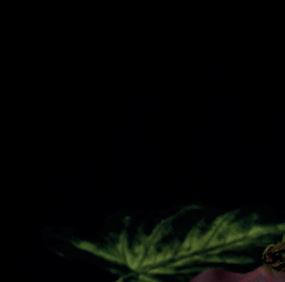











































A refill option for the Disinfectant Wipes These packs contain 100 F10 wipes, so are ideal if you have previously bought F10 wipes and just want to replenish the tub. This will help to reduce plastic usage - and of course they are also a little cheaper than buying the tub too.
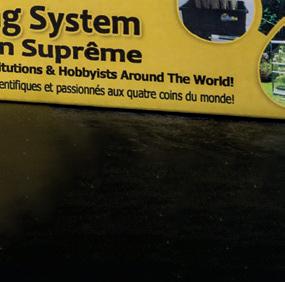

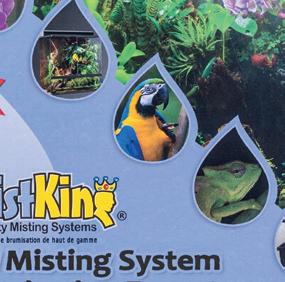
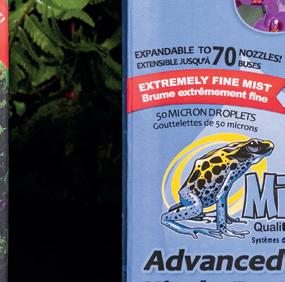
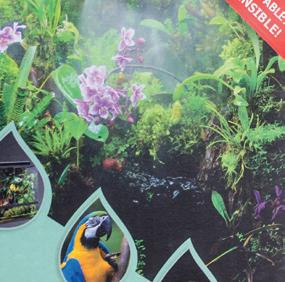
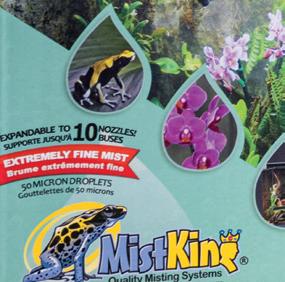
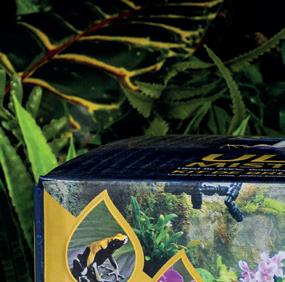




F10 Disinfectant Wipes are biodegradable, single-use wipes impregnated with F10SC. F10SC is proven effective against all known types of pathogen – so are antibacterial, antiviral, antifungal. The wipes are ideal for quick and effective clean-up and disinfection. F10SC has proven high levels of safety, they won’t damage equipment, can be used on skin (for quick hand decontamination), and are safe for use around animals. www.f10products.co.uk



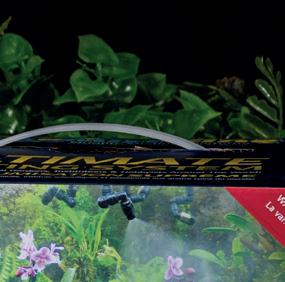
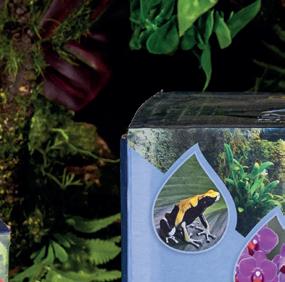
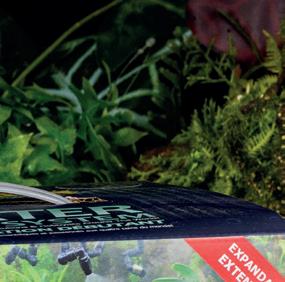
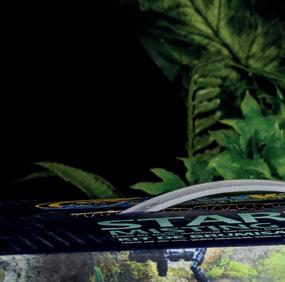


















“Head and shoulders above the rest”
ETHICAL FISHKEEPING
Are fish overlooked when it comes to animal welfare?
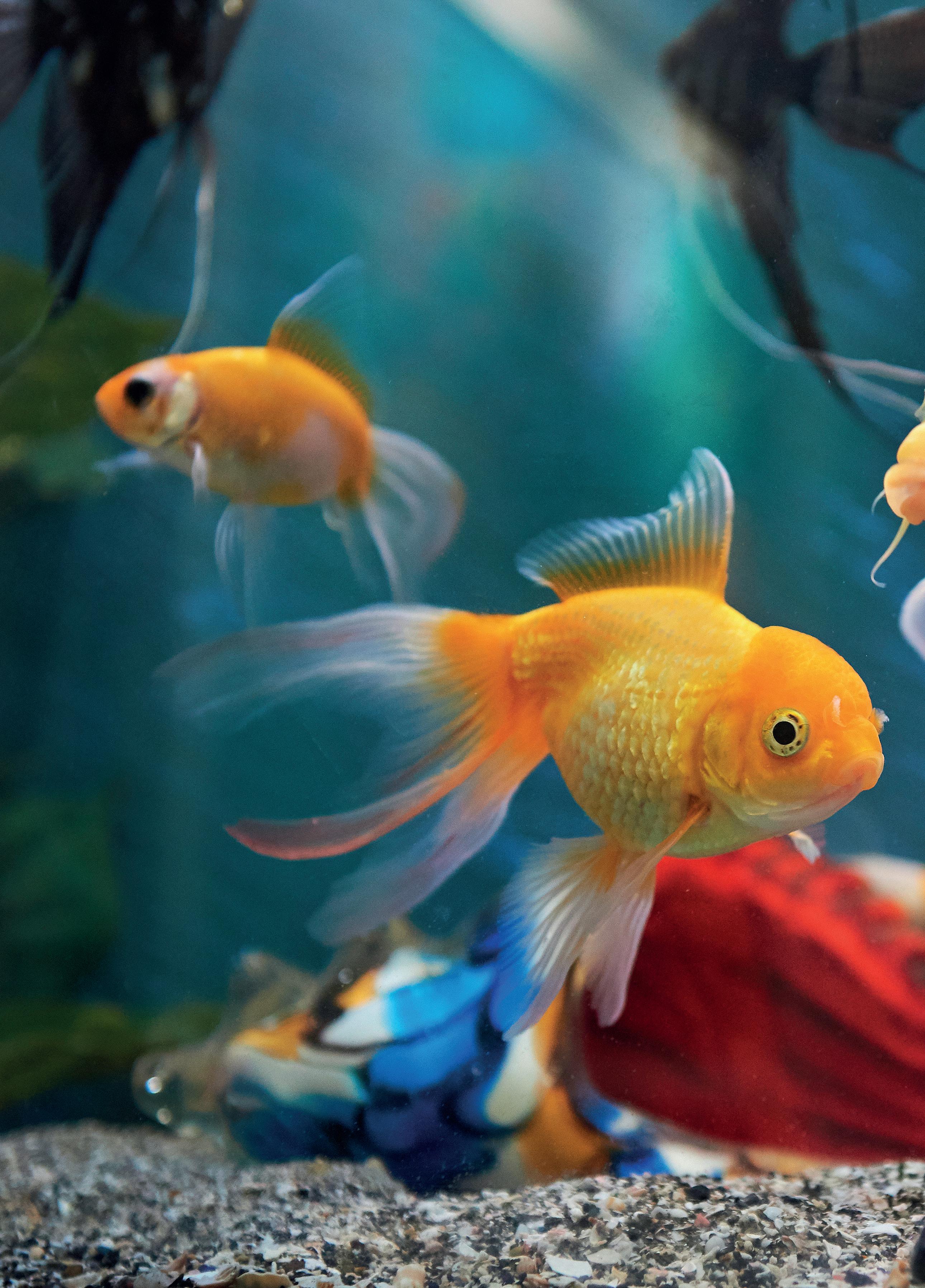 by Max Pedley
by Max Pedley
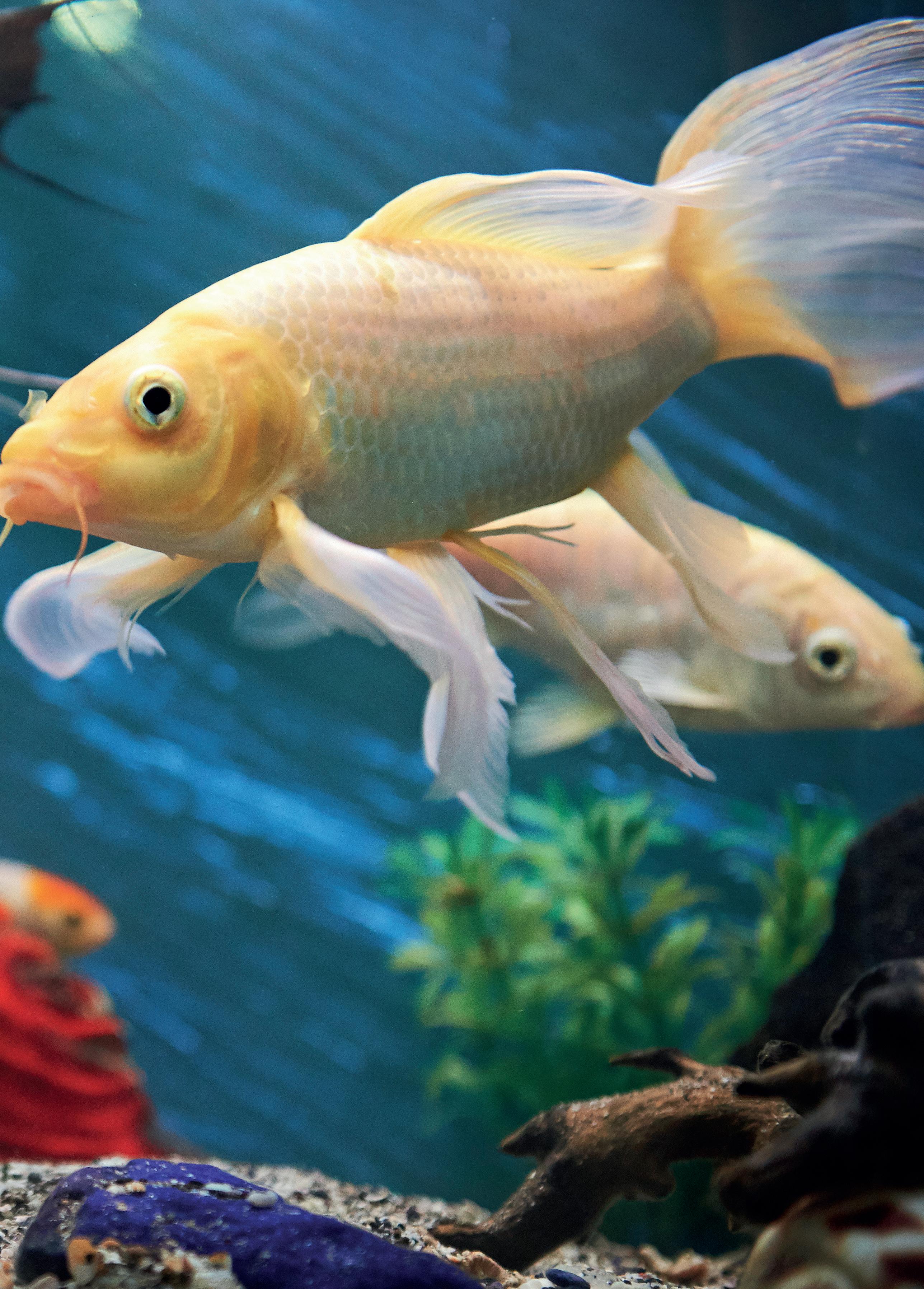
Long-held was the belief that a goldfish’s memory lasted a paltry 2 seconds. As such, goldfish were widely thought of as simple animals. They were kept in small bowls with little to no enrichment, fed the same food and provided little to enhance their standard of living. Thankfully, these days we are a little more conscious of the secret, complex lives of fish and our improving husbandry demonstrates that. But we still have a long way to go….
Tank Sizes
Unfortunately, it is all too easy to buy a small tank without considering the species of fish you wish to keep. New keepers generally go for complete setups, often around 60L. Whilst such a volume is adequate for a small community of fish when faced with choosing such fish from a well-stocked shop, one can easily become carried away. Peering into tanks upon tanks of fishes with varying colours, sizes, shapes and attitudes, can prompt the purchase of something unsuitable. To avoid this, it is important to have a rough idea of what you aim to keep prior to buying and setting up your aquarium. This way, the needs of your chosen fish can be well researched and catered to. Speak to your local aquarium club or get chatting with employees at a reputable shop to get an inkling of what you would like to achieve.
Remember, fish will appreciate more swimming space. As a rule, for every 1 inch of an individual shoaling fish’s body length, 1 foot of swimming space should be given. Allow more space for territorial species.
Top tip – It’s easy to tell yourself that you plan to upgrade your tank as fish grow, but circumstances can change, preventing you from doing so. Make sure to increase tank size before increasing fish numbers or buying bigger fish!
Top tip – Research is key! Make sure that you have thoroughly researched the needs of your fish to ensure that you can successfully maintain the correct water chemistry and dietary needs as well as understand if your current stocking is compatible.
Top tip – Get a good handle on how water quality works. Learn about the Nitrogen cycle to avoid a ‘dirty’ or toxic aquarium.
Top tip – Not all fish like the same water. A reasonable understanding of water hardness and pH is your best friend here.
18 MARCH 2022 Ethical Fishkeeping
Sourcing fish –Where should I buy my fish?
Even as consumers it is possible to help elevate the standard of welfare for ornamental fishes by supporting ethical suppliers. There are a few ways to help ascertain how ethical a supplier is.
Fish Health – Walking around the shop and looking into stock tanks, you should not see dead or dying fish. This is an indication that the business does not pay enough attention to animals whilst health checking. Unfortunately, the age-old myth that dead fish should be left a while to feed other fish is simply untrue. When not removed, harmful pathogens may linger in the aquarium only to be passed onto other animals. Also, the breakdown of a carcass can foul the water, releasing ammonia which is toxic to fish.
Look out for diseased fish too. Fish that are under treatment should be clearly marked. Odd-coloured water (ie. bright green or blue) might indicate that a treatment has been used. If fish in such a tank are still on sale, one must question why. An ethical dealer will only sell wellquarantined, healthy fish. Look for fish ‘clamping’ their fins tight to the body, as well as excess mucous production or listless behaviour. These are signs which must not be ignored and may be indicative of more nefarious conditions.
Sourcing of fish – Any responsible store should know the origin of the fishes they stock. Luckily for fish keepers, the collection of wild fishes is well officiated, especially as far as popular species are concerned.
Some stores may buy from particularly reputable wholesalers and exporters who make an effort to help conserve the natural habitat of aquarium species. Such efforts should be commended.
Banned and Taboo Fish – Keep an eye out for banned livestock in your dealer’s tanks. Crayfish must be treated with an air of caution. Only one species, Cherax quadricarinatus (blue claw cray) is legal in the UK. ALL other species are illegal without appropriate permits. Should your supplier sell these banned animals without such permits, it is your duty not only to tell them but also DEFRA and OATA (Ornamental Aquatic Trade Association). There are also many more species of fish protected under legislation, of which lists are available online. Genetically modified ‘glow fish’ are also illegal in this country and should be reported.
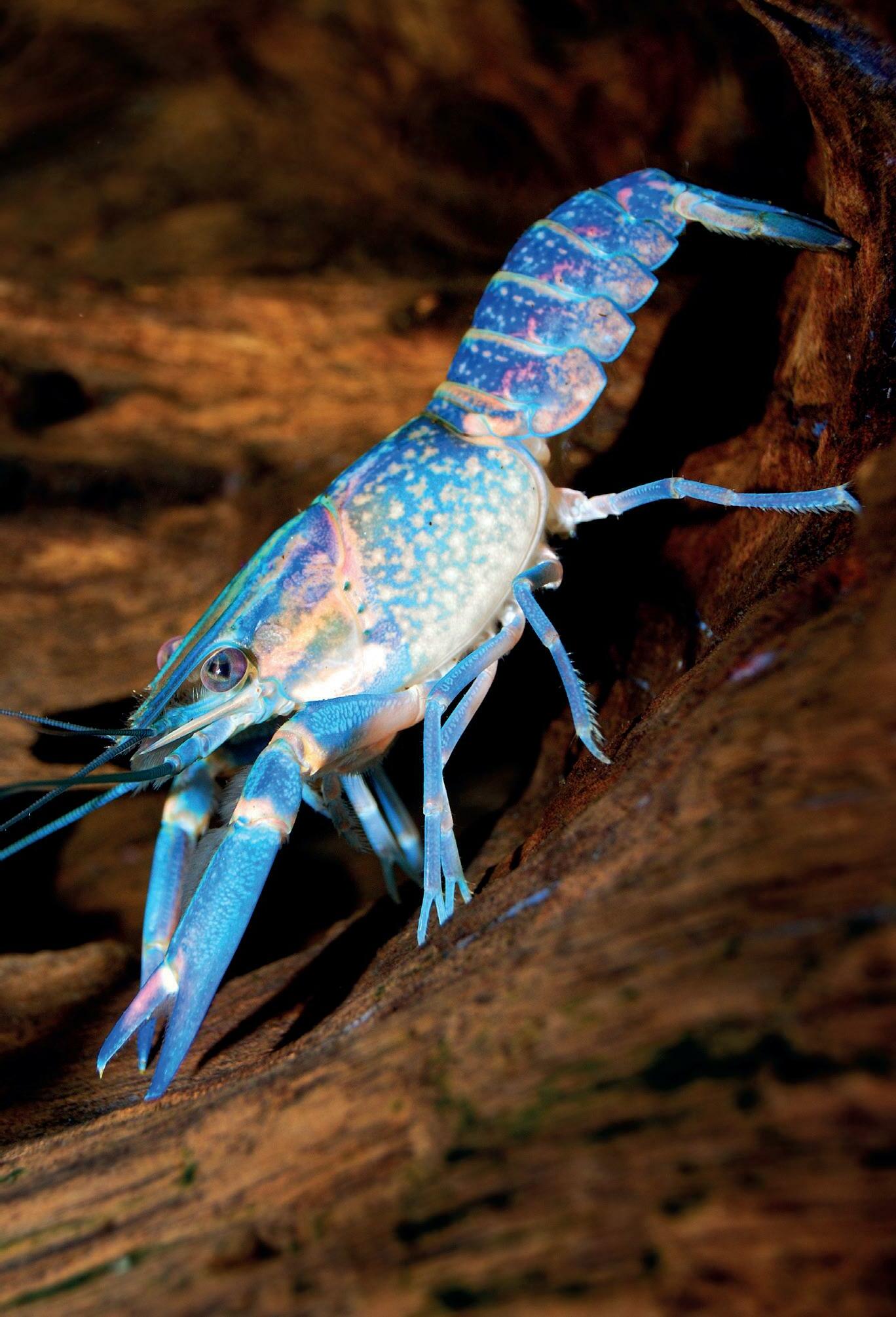
Dyed/tattooed fish are not banned from sale, but it is against the law to carry out the colouring of these fishes in this country. Many publications, forums and clubs stand against the import and sale of tattooed animals due to the pain and lasting damage it causes. Responsible, ethical shops will not offer these fish for sale.
Compatibility
Perhaps the most self-explanatory section of this article; It is of imperative importance that interspecies and conspecific aggression is mitigated in an aquarium.
Whilst there are no hard and fast rules to adhere to, one must take great care in keeping compatible fish together. It goes without saying that fish with large mouths can swallow small fish, so immediately you must consider the predatory nature of certain species.
Consider feeding too. Shy, slow feeders will struggle to feed when kept with active, gregarious fish. It is the responsibility of the keeper to learn and understand the behavioural needs and compatibility of their fish.
19 MARCH 2022 Ethical Fishkeeping
Blue claw cray (Cherax quadricarinatus)
Ethical Fishkeeping
Enrichment for Fish
Fish can be kept in poor conditions and survive. That may be why they have become so ubiquitous as pets. They show little emotion and as humans, we don’t feel the same empathy towards our scaled friends. However, there are many ways in which we can provide enrichment for our fish.
Substrate
As with many taxa, the immediate environment in which the animals are held should be considered the primary form of enrichment. Substrate, décor and even space are all good places to start. As with any exotic animal, the substrate should play a huge role when it comes to ethical fishkeeping.
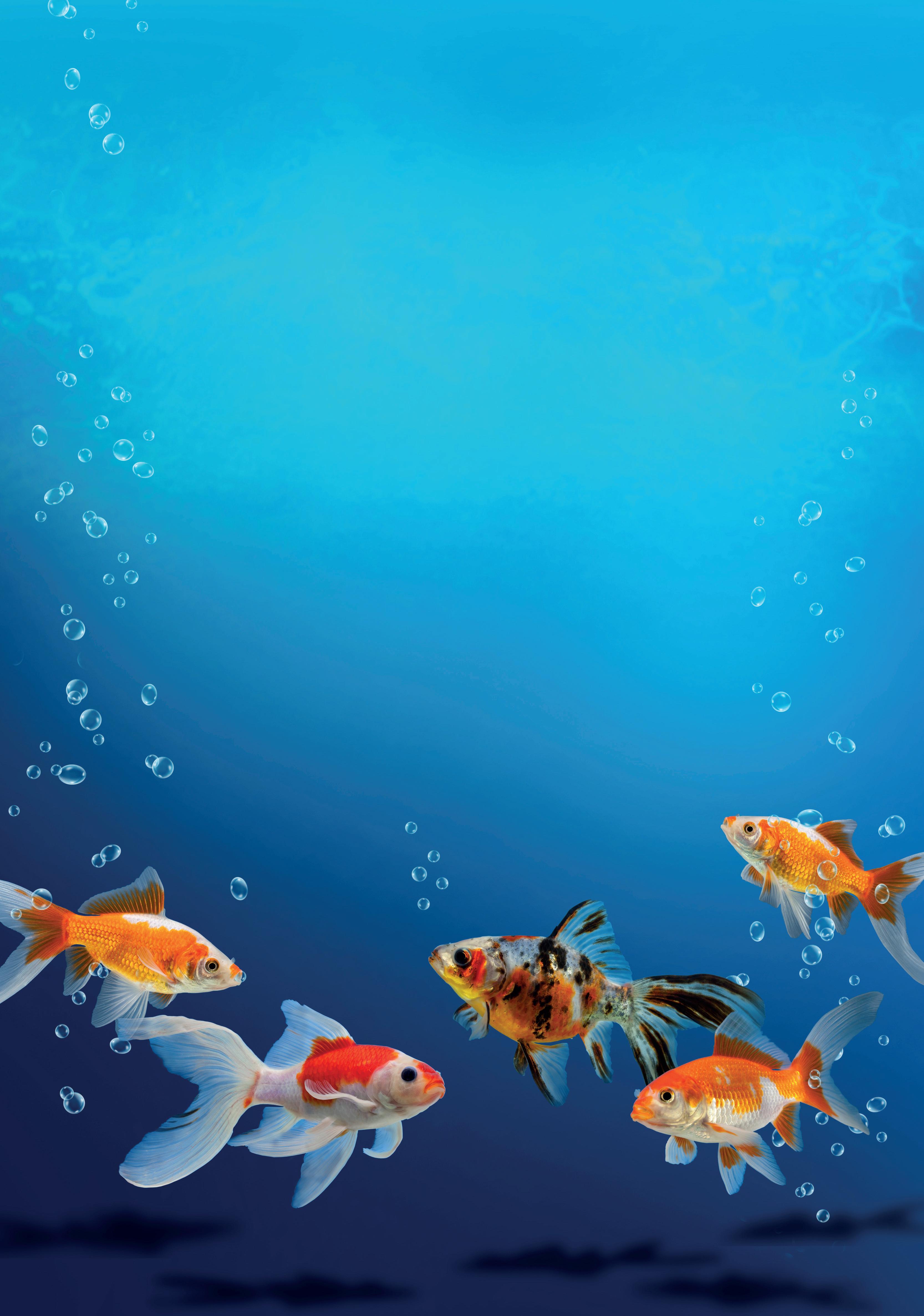
Gravel – Gravel is probably the most common, household aquarium substrate. Think of goldfish bowls and you’ll probably envision rainbowcoloured pebbles or naturally coloured pea gravel littering the base. But is this always ideal? Most aquatic environments do not exhibit beds of evenly sized gravel. The few environments that do are often rapids or fast-moving upland habitats. Minnows and other ‘egg-scattering’ species often spawn over gravel beds, as the eggs can fall into the spaces between, afforded refuge from hungry mouths. For this same reason, gravel is often very difficult to clean, as debris and detritus can build up between the cracks if it is not vacuumed regularly with a siphon.
Bare Bottom – Some aquarists opt for bare-bottomed tanks. These are very useful in quarantine aquaria as they can be kept sterile and easily cleaned should detritus settle. Unfortunately for fish, a bare bottomed aquarium offers few behavioural benefits. Some fish might spook due to the sheer openness. Light bouncing upwards often has strange effects on fish too, which are generally adapted to receiving light from above.
Sand – For many species, sand may well be the best substrate choice. It should be considered cosmopolitan, found in virtually all aquatic environments. Sand is fine and does not cause abrasions with benthic fish, who often have a penchant for digging and rooting. Other fishes such as loaches and stingrays even hide beneath the sand. When feeding fish in an aquarium with sand you will invariably notice ‘sand-sifting’ behaviour, as they search for morsels of food in the substrate. It is widely considered that this has incredible benefits for both the physical (helps to clean the gills and mouth cavity) and mental health of fish.
20 MARCH 2022
Décor
Walk into any well-stocked aquatics store and you should be amazed by the amount of décor on display. In the hobby, we refer to this as hardscape and it should most definitely be used on your quest to improve fish welfare.
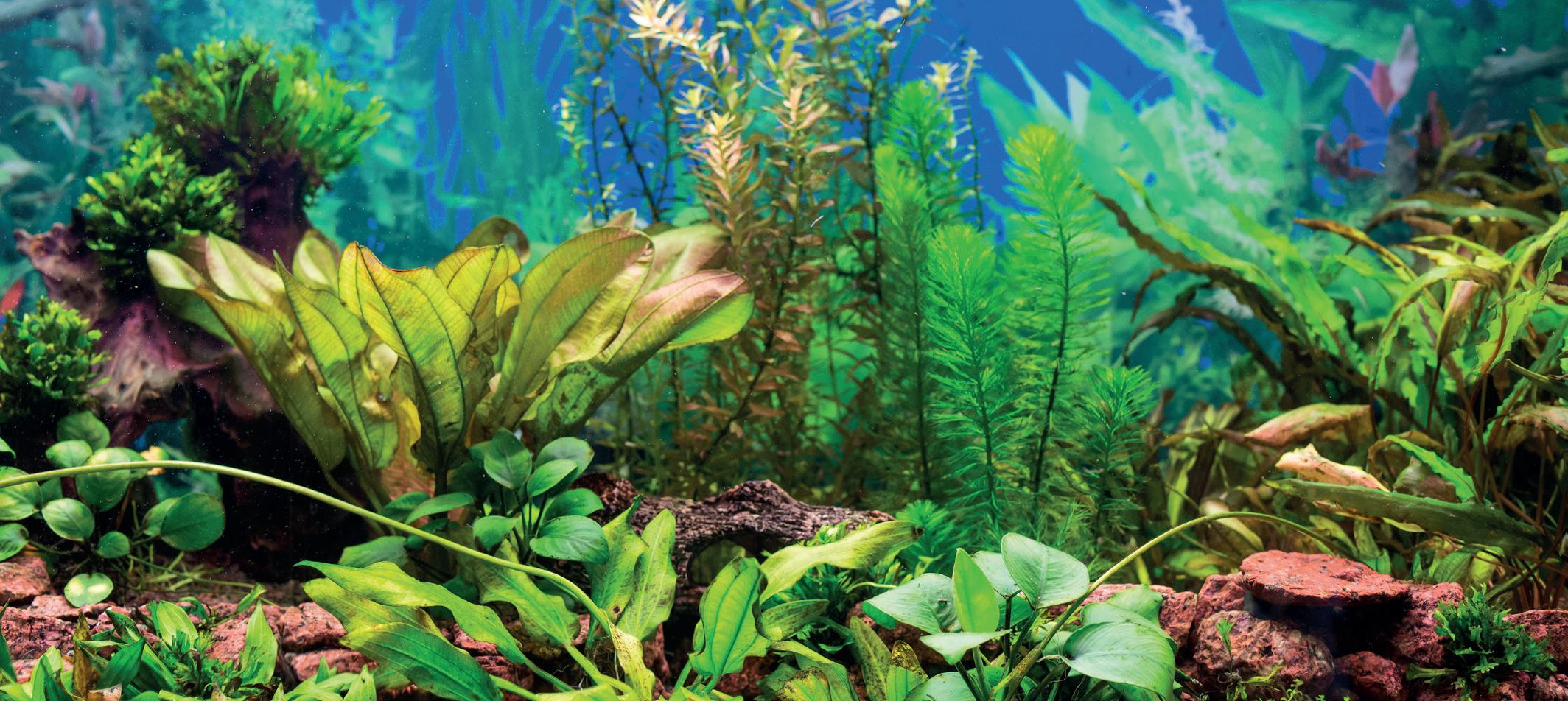
Rocks – Ranging from round pebbles up to huge boulders, rocks have a place in most aquaria. In many African Rift Lake setups, interlocking rocks are stacked to create territories and boundaries for fish to hide and seek refuge. Gregarious, bolshy fish should be given many hiding spaces in such a manner to prevent bullying and fighting. These techniques can be employed in most aquatic situations.
In other aquaria, larger rounded boulders can be used for fish that actively feed on algae and the other lifeforms which encrust surfaces. These may be referred to as Aufwuchs. Some breeders of Loricariid catfishes (plecs/L numbers) and Hillstream loaches swear by this method so much, that they may ‘cure’ boulders outside in trays of dirty water under the sun, swapping out existing ones once they have been scraped clean by the fish. This is a fantastic method of replicating nature to provide for our fishes.
Of course, you may simply like the look of certain rocks and fancy a few in your tank, but make sure to select those which have not been artificially coloured, have sharp edges or may affect the chemistry of your fish tank. Limestone will dissolve slowly in water, increasing the pH as it does so.
Wood – Driftwood, rootwood and mopani all feature heavily in fish tanks, and with good reason! They come in a variety of shapes and sizes, look natural and provide many benefits for fish. Some species, such as L number catfish even eat wood! Panaque spp. are large, armoured catfish of the Neotropics which use spoon-shaped teeth to rasp the outer layer off fallen wood, digesting both the wood itself and any organism living within. For good health in captivity, it makes sense to at least provide your L numbers with the opportunity to do the same.
Smaller species of shoaling fish such as tetras and barbs often seek the shelter of tangles of wood, away from the reach of predators. Provide them with similar shelter in captivity and they will certainly feel more secure and exhibit more natural behaviours.
Botanicals – New to the aquatics and exotics scene is the introduction of botanicals. ‘Botanicals’ refers to plant products such as leaves, seed pods and branches, but also includes the skeletons of cacti, dried flowers and other such wonders.
Leaf litter – Trees surround us, and leaves fall. So, it’s only natural to find these in most freshwater habitats. Providing leaves adds an extra dimension to an aquarium. Small cichlids and catfish will take great delight in exploring and burrowing within. As the leaves break down, they provide food for microbes on which fish and fry feed, as well as releasing humic acid into the water which is excellent for jungle-dwelling species. For fish that prefer alkaline water, leaf litter should be kept at a modest level.
Seed Pods – These have become increasingly popular by both aquarist and frog keepers. The pods make ideal spawning real estate. Gouramis, dwarf cichlids, small predatory fish and dart frogs will all utilise these spaces and it comes as quite a surprise that seed pods are not more widely available. For the more casual keeper, they also look great as décor in the tank!
Artificial Ornaments – Although not everyone’s cup of tea, a resin diver or a novelty skull can still be of use in aquaria. If nothing else, such ornaments break up the line of sight, calming aggressive fish and giving respite to those at the wrong end of such aggressors. However, these items should be specifically designed for aquaria. Some paints and coatings of conventional ornaments might be toxic, so it is recommended that customers double-check with their shopkeeper.
21 MARCH 2022
Fishkeeping
Ethical







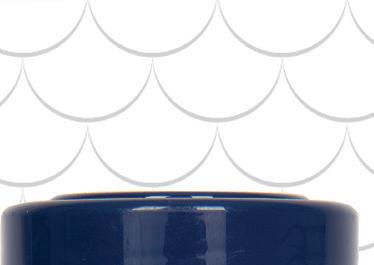
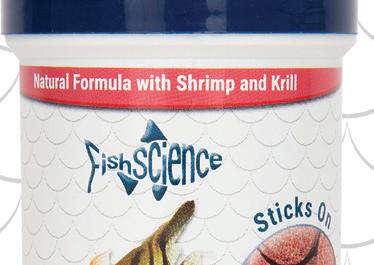




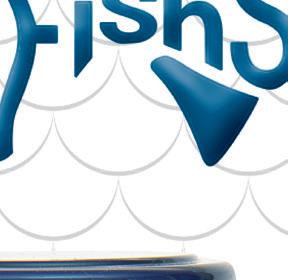



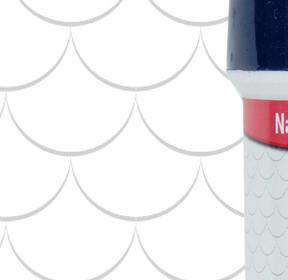
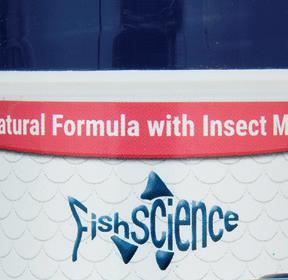
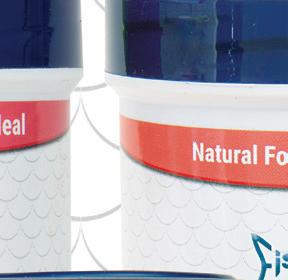
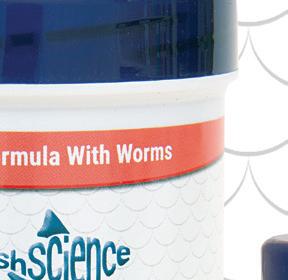
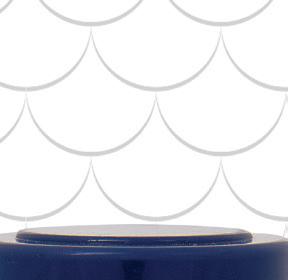

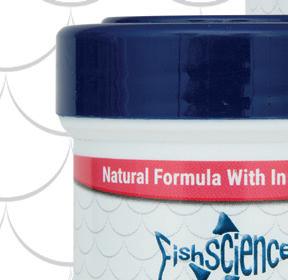
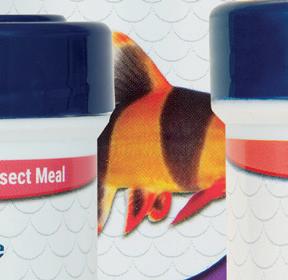
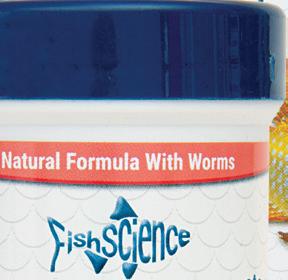
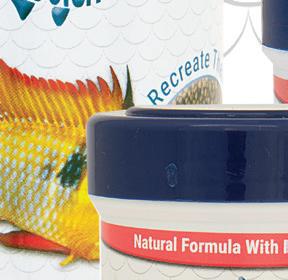

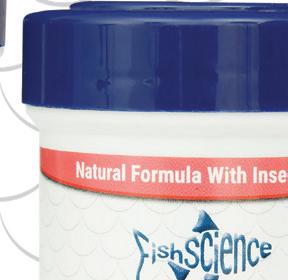

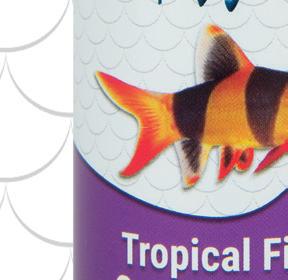
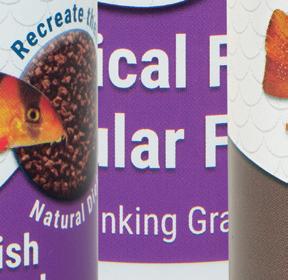
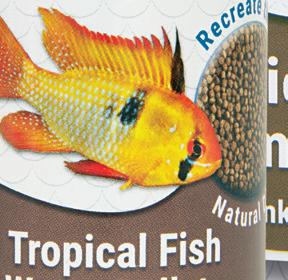
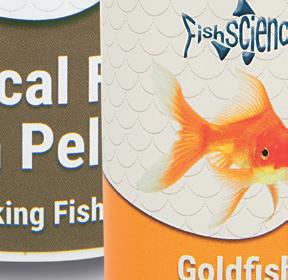
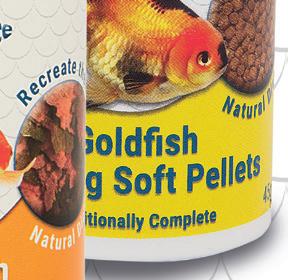
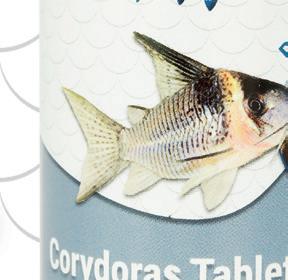




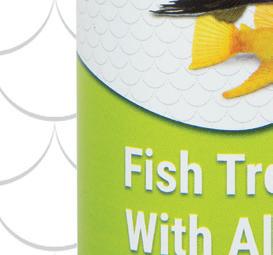


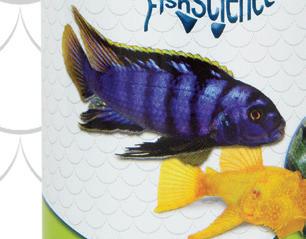
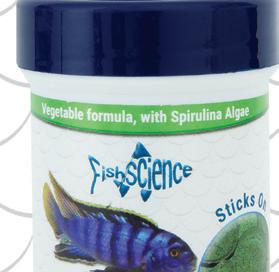
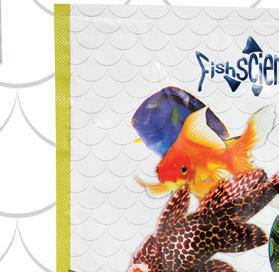


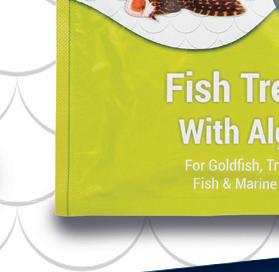


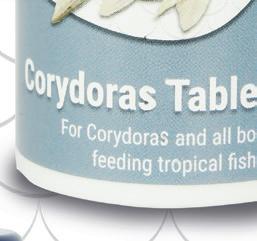


Aquarium Fish Foods with Insect Meal www.fishscience.co.uk Uses cultured insect meal to recreate the natural insect based diet that most fish eat in the wild. Easily digested and processed by the fish resulting in less waste. ‘Best Aquarium Fish Food’ As voted by readers of Practical Fishkeeping magazine Environmentally friendly and sustainable.
Food

Food might be the most instantly rewarding form of enrichment one can provide the animals they care for. It is all too common to fall into the trap of regular, small pinches of flake for fish. Of course, a staple, dry food is a great target to aim for with fish to ensure you are providing the correct balance of nutrients and vitamins, but such a diet can and should be mixed up regularly.
Fresh Produce – Many species of fish are herbivorous/ omnivorous. If you own a community tank with livebearers, herbivorous catfish or larger cichlids, you might find that a few pieces of veg might go down well now and again. Courgette, sweet potato, and mushrooms, sunk with a lead weight or even skewered with a spoon, make an interesting treat. Make sure that these are not left in the aquarium for more than a few hours as this can lead to decomposition and fouling the water quality.
Frozen Food - Frozen food comes in many flavours. Bloodworm, Brine Shrimp (Artemia) and Daphnia are probably the most common, amongst others. Frozen foods offer fish the chance to feed on natural, disease-free foods. Some frozen food may lose nutrient content during the freezing process, so it is important to make sure that they are utilised as a treat, rather than a staple diet.
Mysis shrimp can be found in most aquatic retailers’ freezers and make a fantastic conditioning food, but due to the high lipid content they should be used sparingly.

Frozen food can be fed via feeders, tongs, or pipettes, offering the possibility for further enrichment. Bloodworms may be syringed in the substrate, encouraging your animals to dig and search for their meal.
Live food – Most of the frozen food options can also be purchased live. Used in much the same way, the benefits include higher nutrient content and increased activity levels. This is particularly useful for wild-caught or finicky fish which would otherwise be difficult to feed in captivity.
Other excellent live choices include tubifex and blackworm, both thin, high protein worms which will bury into the substrate. Keepers of predatory fish might even opt for river shrimps to enhance the diet of their fish.
Surface dwelling fish can be fed on small crickets and fruit flies too which are very active and provide good enrichment for tank mates. Feeding live vertebrates to fish is illegal in this country and serves no good purpose, so you should not be tempted to buy ‘feeder’ goldfish or guppies. Not only is it unethical, but it vastly increases the chance of disease transference to your fish.

23 MARCH 2022
A HERO OF GIANT PROPORTIONS
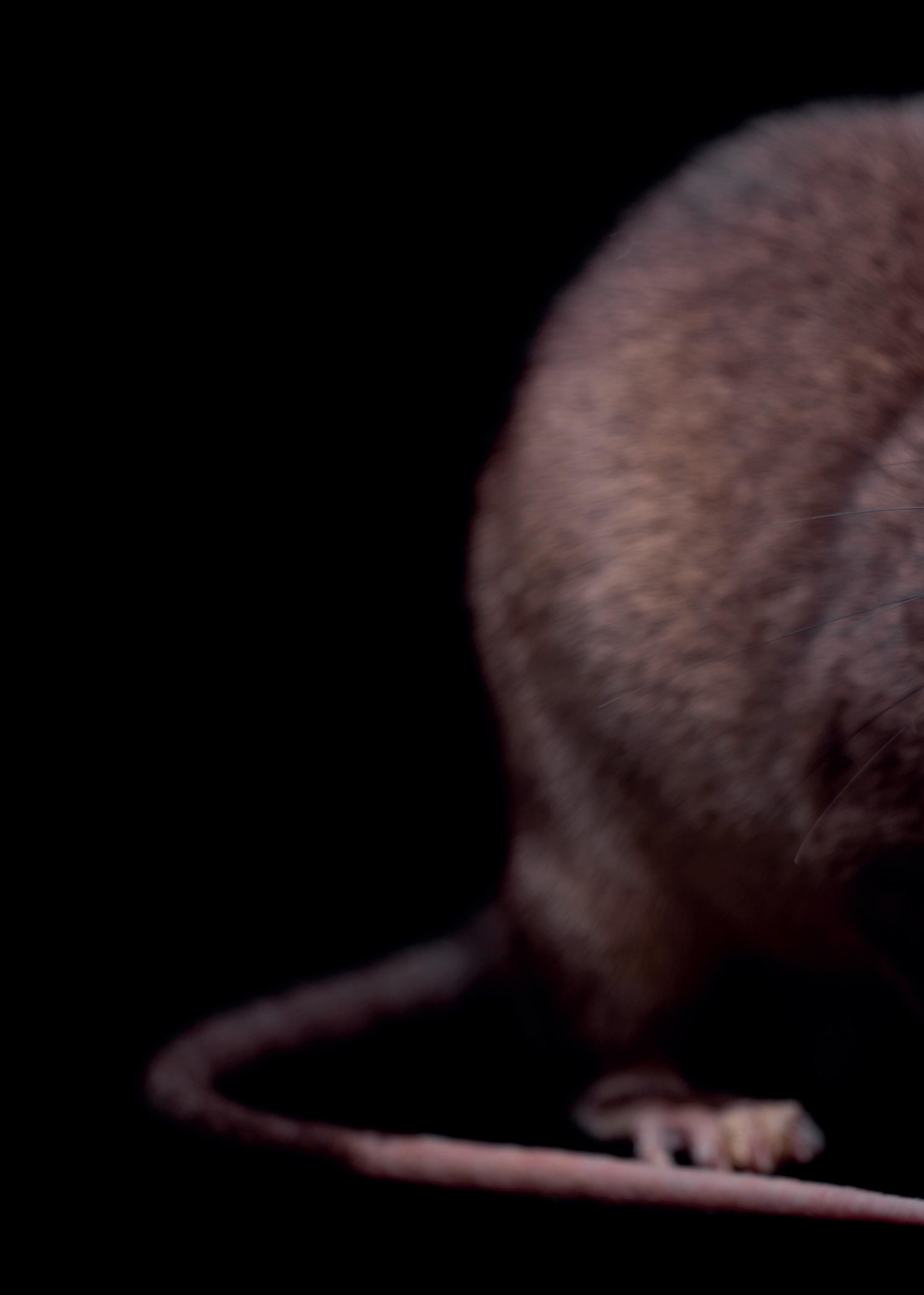
How many other exotic pets have saved tens of thousands of lives?
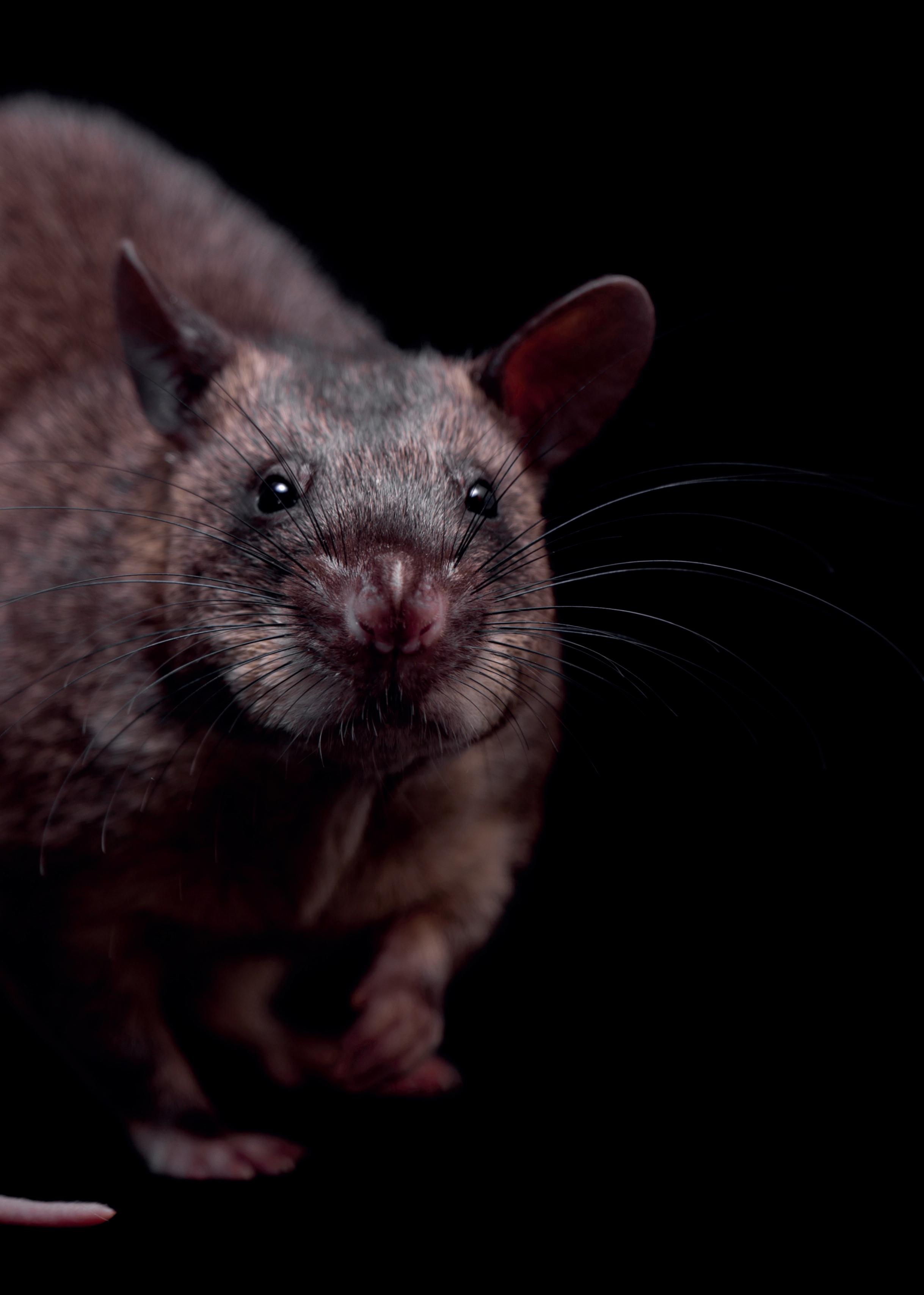 Gambian pouched rat (Cricetomys gambianus)
Gambian pouched rat (Cricetomys gambianus)
The Gambian or Giant pouched rat (Cricetomys gambianus) is one of the largest species of rat on the planet. Whilst that may send shivers down the spines of some people, these rats are not your average rodent. Not only are they the focal point of an entire society of dedicated keepers, but across the world, they have been used to detect mines, missing people, and tuberculosis. This species has helped diagnose 18,000 people, destroyed 13,000 landmines in Mozambique (declaring it a mine-free country) and reduced poaching of pangolins (Phataginus sp. & Smutsia sp.) across Africa. One rat even received the PDSA Gold Bravery Medal.
Man or a mouse?
The giant pouched rat gets its name from the cheek pouches it uses to store food, in a similar way to a hamster. Although visually it looks much like the common brown rat (Rattus norvegicus), there are some substantial differences.
Firstly, the giant pouched rat can grow up to 3 feet in length from nose to tail. Despite being a very muscular animal, its nimble movements and comparatively light weight mean that it can navigate minefields efficiently and without detonating dangerous explosives. Secondly, this species lives up to 6 to 8 years which is double the lifespan of most other rats, making it ideal to train and contributes to its popularity as an exotic pet. They are almost blind and rely very heavily on their sense of smell, which is accentuated by their enormous whiskers.
APOPO (translates to Anti-Personnel Landmine Removal
Product Development in English) is the largest charity training the rats to detect mines and disease across West Africa and Southeast Asia. A mix of socialisation, clicker training and indication is used to train the rats. Like many animals, they are highly food-motivated and will quickly learn commands and puzzle-solving activities. Eventually,
these puzzles become more complex, and trainers begin using a method of ‘discrimination’. This is when a rat that has learnt to identify TNT is then exposed to various other elements, teaching the animal to only identify landmines. The rats are given a series of tests and only animals that score 100% can move onto the next stage. Some of these animals are used across the world to save human lives.
The landmine monitoring report suggests that over 60 million people worldwide are threatened by undetected landmines. Last year saw a 20% rise in causalities which spanned 54 countries and of the 4,437 civilian victims, over half were children.
Clever critters
As well as their lifesaving abilities, giant pouched rats are a niche, yet much loved pet in the UK and Europe. Across their home range of Central Africa, public opinions towards the rodents vary. In some places they are treated as pests, in others they are eaten as bushmeat and in others, they are very popular pets. The term ‘pouched rat’ refers to four different species, with the Gambian pouched
26 MARCH 2022 A
of
Proportions
Hero
Giant
rat (R. gambianus) most kept. Only one other species, the Emin’s pouched rat (R. emini) has previously been bred in the UK, but it is now rarely seen within the hobby.
Shannon Ann Bolton, Pouched Rat Keeper and Committee Member at the National Pouched Rat Society told Exotics Keeper Magazine: “They have such big characters. For me, I wanted a pet, and I don’t have any outdoor space, so I started looking at my options and stumbled across them through APOPO. I joined the group, followed for many months, then eventually filled out an application form and now I keep two rats, Edna and Bernard.”
Despite a large society of over 4000 members, very few people keep Gambian pouched rats. The animals
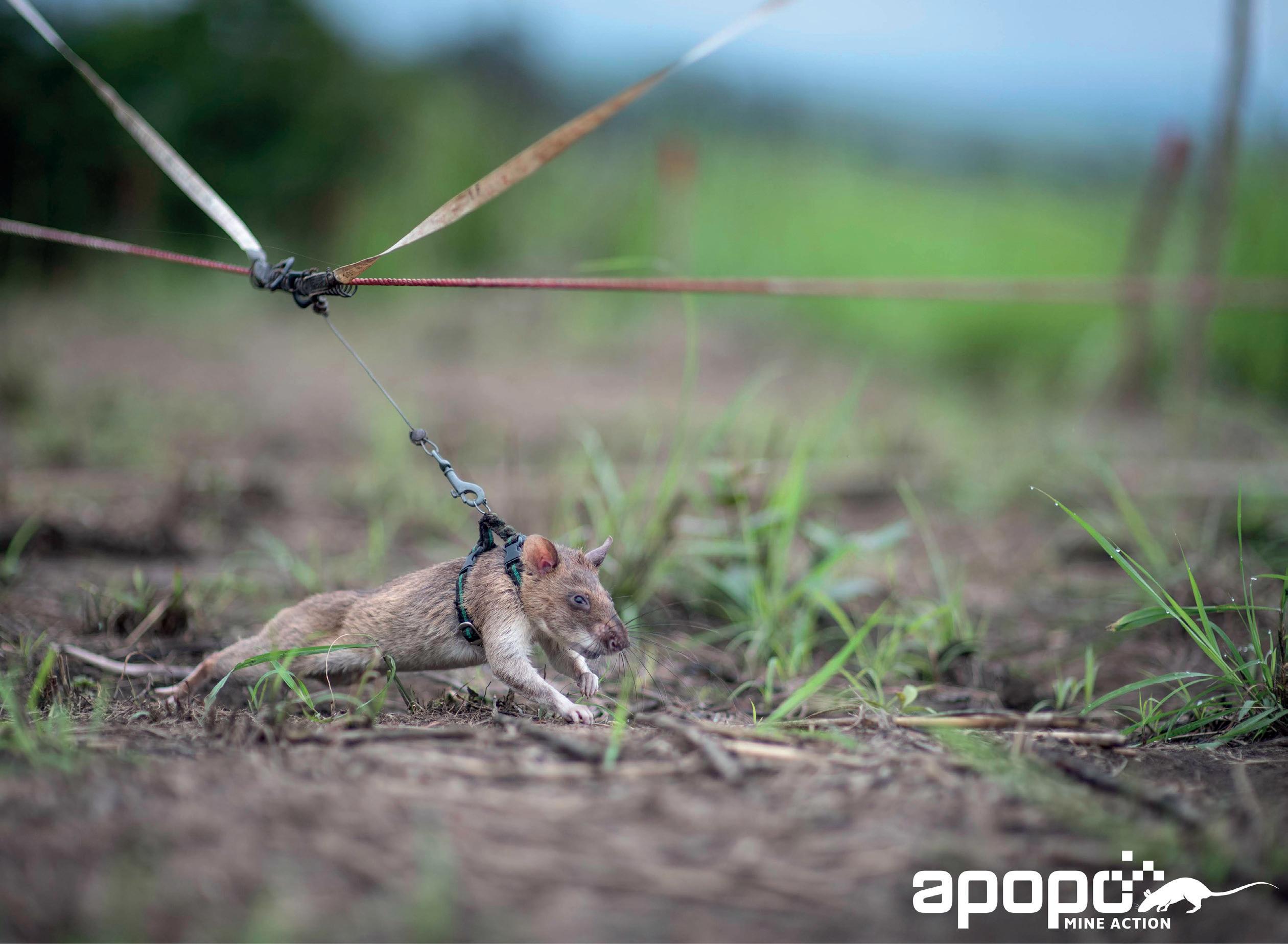
which are affectionately referred to as ‘pouchies’ are often mistakenly likened to the more common ‘fancy rat’.
Shannon continued: “Even when I’ve booked Edna into the vets before and say, ‘it’s a giant pouched rat’, I’ll have receptionists say ‘oh, that’s okay they deal with rats all the time’. In reality, they’re genetically closer to hamsters.”
“These animals are not technically domesticated yet as they’ve not been kept as pets for a long time. Good genetics helps, good breeders help, but realistically you still might end up living with a little wild animal. Mine are amazing, but one of their siblings just isn’t a people rat. So, her keeper is having to always use gloves and I think that’s a complicated situation to explain. You’ve just got to accept it and provide
A Hero of Giant Proportions
a happy and healthy life with as much enrichment as possible.”
Just like many exotic mammals, enrichment plays a huge part in the welfare of the animal. Such highly cognitive species may be capable of forming extremely close relationships with their keeper but also demand lots of socialisation and play time. “Commitment and structure are really important” explained Shannon. “If you have one that isn’t as friendly, it’s all about patience and things like; appearing at the cage at the same time each day, so they know when to expect you. Even though it sounds strange, they’re animals that work to a schedule. Now Edna is an older animal, after having a routine of coming out for an hour each day, when the hour is up, she will signal to go back into her enclosure.”
27 MARCH 2022
“I have to actually leave bits of rubbish around my room for Edna to run around and tidy up, so she’s very switched on. They absolutely love nest building. Sharing nest materials is a good bonding activity. Having lots of little bits of paper ripped up is great, if I give her one little piece of paper at a time, she gets so excited. She’ll grab it, make sure it’s the right paper (she’s really fussy) then she’ll take it to the bin, then come back for the next piece of paper. I’ve had it before where I’ve been ill, she’s known I’m ill, she’s had a sniff around and started building a nest next to me.”
Undeniably, the pouched rat’s incredible smell supports its intelligent behaviour. Pouched rats can identify different people and will tend to bond with just one keeper. While this may be very appealing for the keeper, it adds further pressure on the commitment required to keep one. Boarding services and finding a babysitter can be extremely difficult without the correct network. Changes in lifestyle can cause issues that, in some cases, the rat knows about well before the keeper.
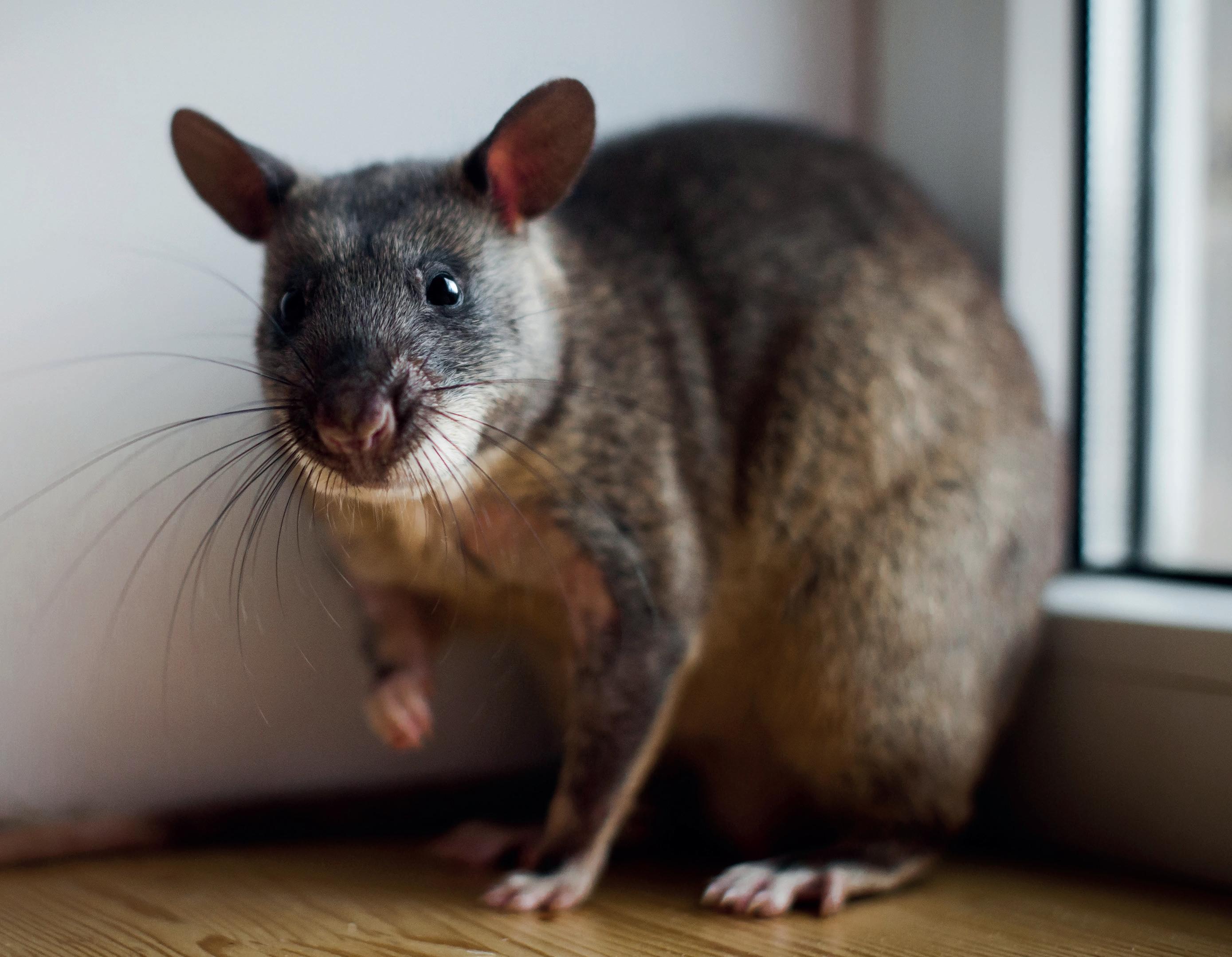
Shannon continued: “We’ve actually had a couple of members now who have owned pouchies and bonded with their animal and then all of a sudden their pouchies behaviour has just changed. When they’ve taken them to the vets they’ve found there’s nothing wrong with them. Then, it turns out it’s because the owner is pregnant. They’re very sensitive to changes!”
Husbandry, care and keeping
Pouched rats are generally kept in large sturdy cages for much of the day. Although there are a handful of specialist cages that can be utilised for pouched rats, parrot cages and modified ferret enclosures are the only commercially available products. Cages should be robust, provide multiple levels of solid flooring, not made from galvanised steel and provide a deep layer of substrate.
“They can be really destructive” explained Shannon. “They are really strong, and they can be really powerful. They’re very lean and very muscular. Edna is 1.8kg and Bernard is 2.2kg. They’ll chew things, they have a lot of strength, and they will rip things apart. I’ve been lucky with mine, but they’re not for the faint hearted.”
Pouchies should be provided with a deep, absorbent substrate layer. A large cat litter style substrate that cannot be pushed outside of the cage through the bars is generally recommended. Extra heating is not necessary, provided they are kept indoors and at a comfortable room temperature. Without extensive research into the relationship between UVB and pouched rats, providing additional light fixtures is also not currently recommended.
As for diet, there is still a lot of debate in the community regarding the ideal diet for these animals. There are currently no complete diets available and as opportunistic
28 MARCH 2022
feeders in the wild, the ‘perfect’ composition is difficult to achieve. Most keepers will provide a spectrum of seeds, complimented with the occasional fruit and veg (being careful not to overfeed highly sugary foods) as well as mealworms and other live foods for enrichment.
Shannon added: “Pouched rats don’t tend to drink water. They have learnt to retain as much water as possible, so they get most of their water from the food they eat. They also hoard lots of
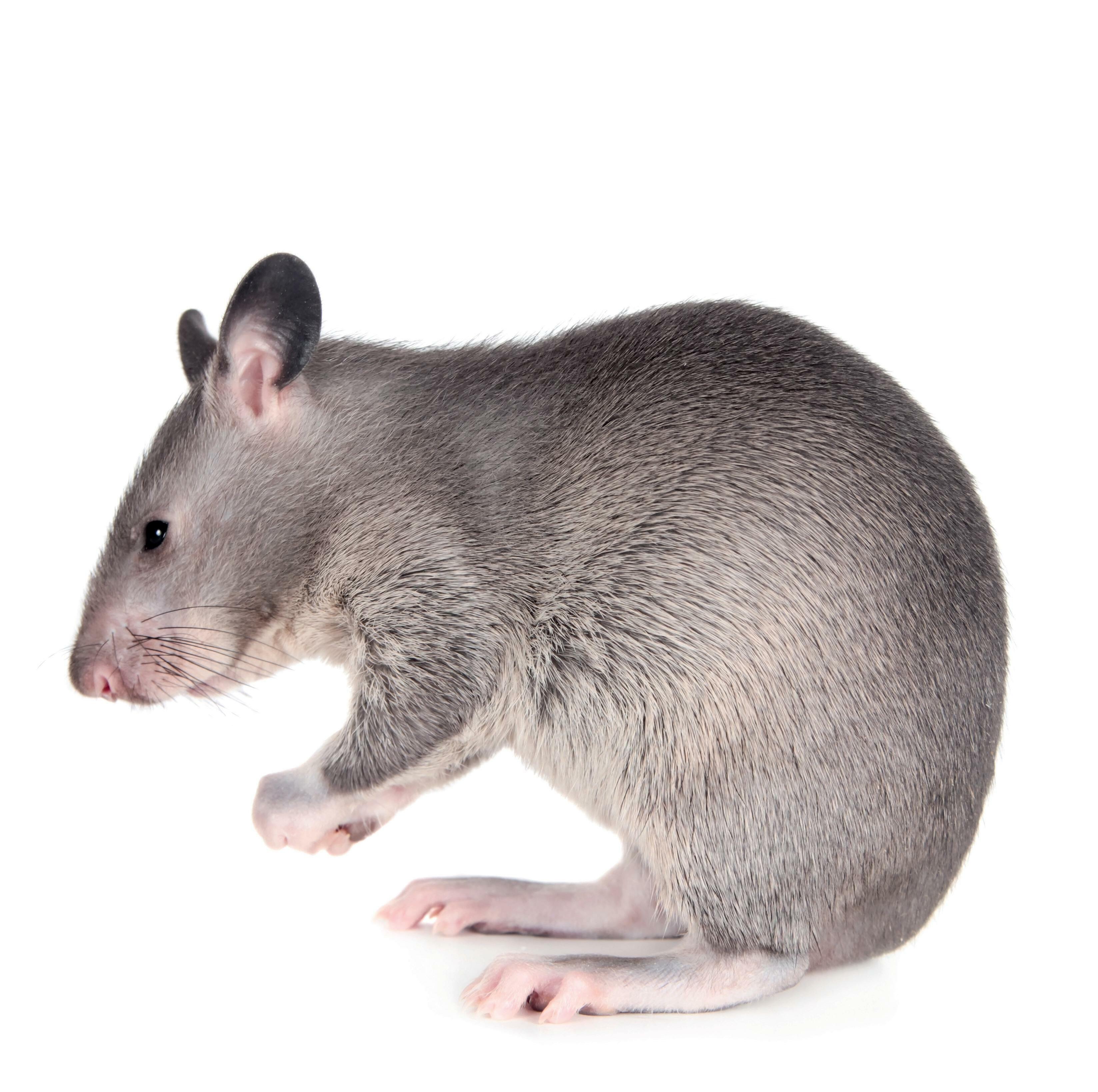
breeders in Europe, their insight into the species here in the UK is not only creating a new subculture of exotics keeping but improving the welfare of captive animals across Europe.
Clare explained: “Little is known about this species. Previous studies suggest that they have a breeding season in summer, and do not mate in the winter months. This could mean their cycles relate to light or temperature in the wild or that the animals may self-select and “choose” when to breed. The experience we have had is that the females do, indeed, choose. Even when living with a companion, they will not breed to demand. They do not appear to come into “heat” at cyclical intervals, it appears to be by choice, at the female’s discretion.”
“Females have a wide pelvic girdle and after an average of 28 days gestation, deliver with relatively few problems, and the litters are generally healthy. In the wild,
A Hero of Giant Proportions
females will have between 1 and 6 in a litter (most commonly 3 or 4). This is true in their captive setting too. The young are born blind, deaf and hairless, relying on their mother for everything. Fathers are normally persuaded to leave the nest just before the birth. However, we have had a pair that raised young together, with the father washing and guarding the babies too. The babies will open their eyes after 3 weeks and begin tasting their mother’s food. By 4 weeks they will still feed from the mother but can and will eat a wide range of foods too.”
As more people begin to breed the species, public knowledge appears to be growing at a steady rate. However, the species has already encountered issues overseas, as a limited gene pool is demanding very strict monitoring of bloodlines and may require imported animals from Europe. Part of the reason the hobby is condensed is that pouched rats have been banned in the United States for many years following a court ruling
DID YOU KNOW
A bomb-sniffing rat can search the size of a tennis court in ten minutes, whereas a human will take closer to 10 days.
The Gambian giant pouched rat can reach up to three feet in length.
The term ‘pouched’ refers to the rats cheek pouches which they use to store food in a similar manner to hamsters.
The National Pouched Rat Society
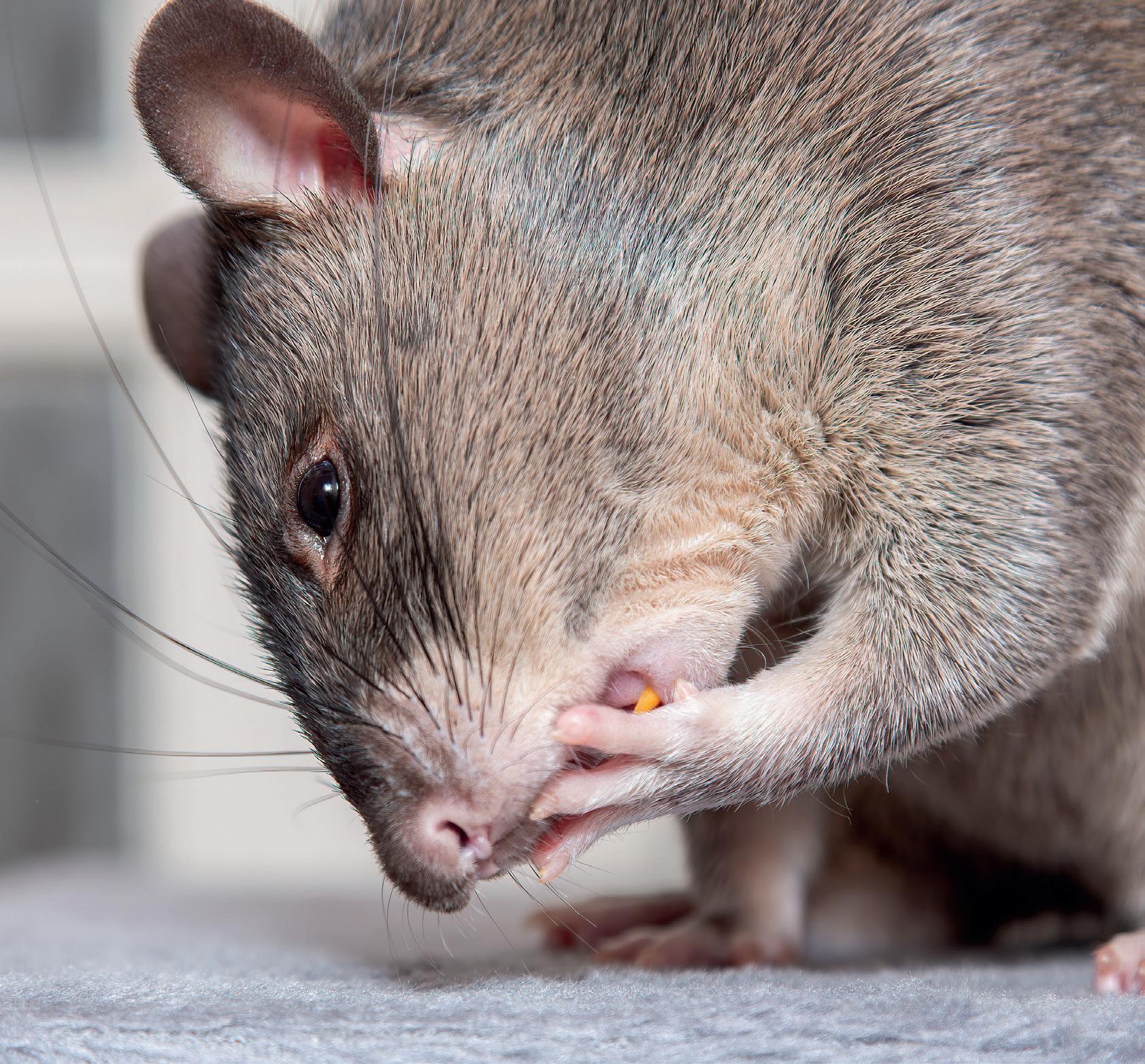
The National Pouched Rat Society is a group of around 4000 members, established by Claire and Louis Varley in 2018 with the goal of spreading current information and husbandry advice for the ‘pouchy’. Although the group is comprised of several thousand members, very few members actually keep animals and even fewer breed, meaning care advice for the Gambian pouched rat is extremely limited and thus, very valuable. The NPRS is now creating regular video content via their YouTube channel to help improve the welfare of all captive animals and give new keepers a head start in the hobby. More information can be found at www.nprs.org.uk.
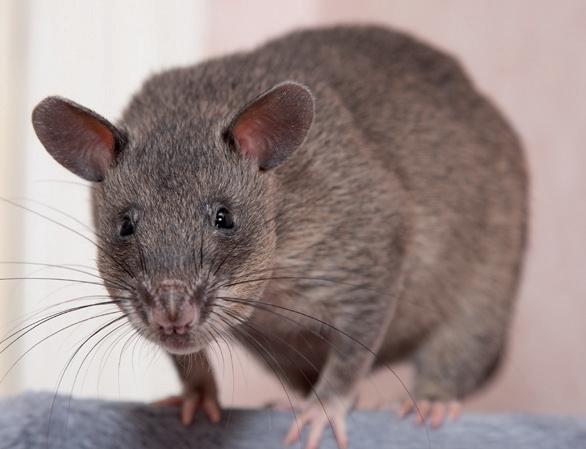
in Florida that they were ‘invasive’. Therefore, maintaining genetic diversity is crucial to the developing hobby.
Clare explained: “Unlike fancy rats, Gambian pouched rats must be completely unrelated for a breeding programme to maintain health and hybrid vigour. There have been significant issues in the past with breeding for sale, as the gene pool is so narrow. These include muscular and skeletal problems, neurological issues, skin disorders. APOPO resolve the issues by capturing wild males to mate to their stock females, and the males are released when mating is successful. Here in the UK, we do not have that access. The NPRS have invested in breeding animals from Belgium, Germany, The Netherlands and recently the Czech Republic, as well as from likeminded ethical breeders in the UK who work with us. Our links with the Czech Republic will be further bonded when, at the end of January 2022, a litter of 3 will be exported to expand their breeding programme.”
“We asked APOPO if they selected breeding rats for temperament, as their willingness to be trained is vital. APOPO didn’t believe that temperament was a heritable characteristic, and this has been borne out many times over. Our main and most successful breeding female, frankly, does not like humans
and is happy to remind us if she’s not respectfully handled. The offspring have been kept here and gone on to other owners and have grown into bright, intelligent, and friendly pets throughout the UK. We keep stringent breeding records and encourage owners to keep in touch via social media. We have over 2 thousand contributors worldwide and aim to preserve and advance this amazing species in the UK, and beyond.
Exotic mammals as pets
To many, the appeal of exotic mammals comes largely from their highly charismatic personalities and intelligent behaviours. Whilst this can prove challenging in some species that are frankly unsuitable for most private keepers, the dedication of certain individuals and organisations to bring more suitable pet species into the conversation is improving the hobby overall. It appears that Gambian pouched rats are generally thriving in captivity and with a vast support network to improve the hobby, change the perception of rodents and in some cases, save hundreds of thousands of lives, exotics keeping can have a myriad of benefits.
This month’s charitable donation will go to APOPO. More information on the work they do can be found on their website: https://www.apopo.org/en
Title 30
Shingleback skink (Tiliqua rugosa)
30 MARCH 2022
MISUNDERSTOOD MONSTERS
A look at the relationship between man and (Gila) monster
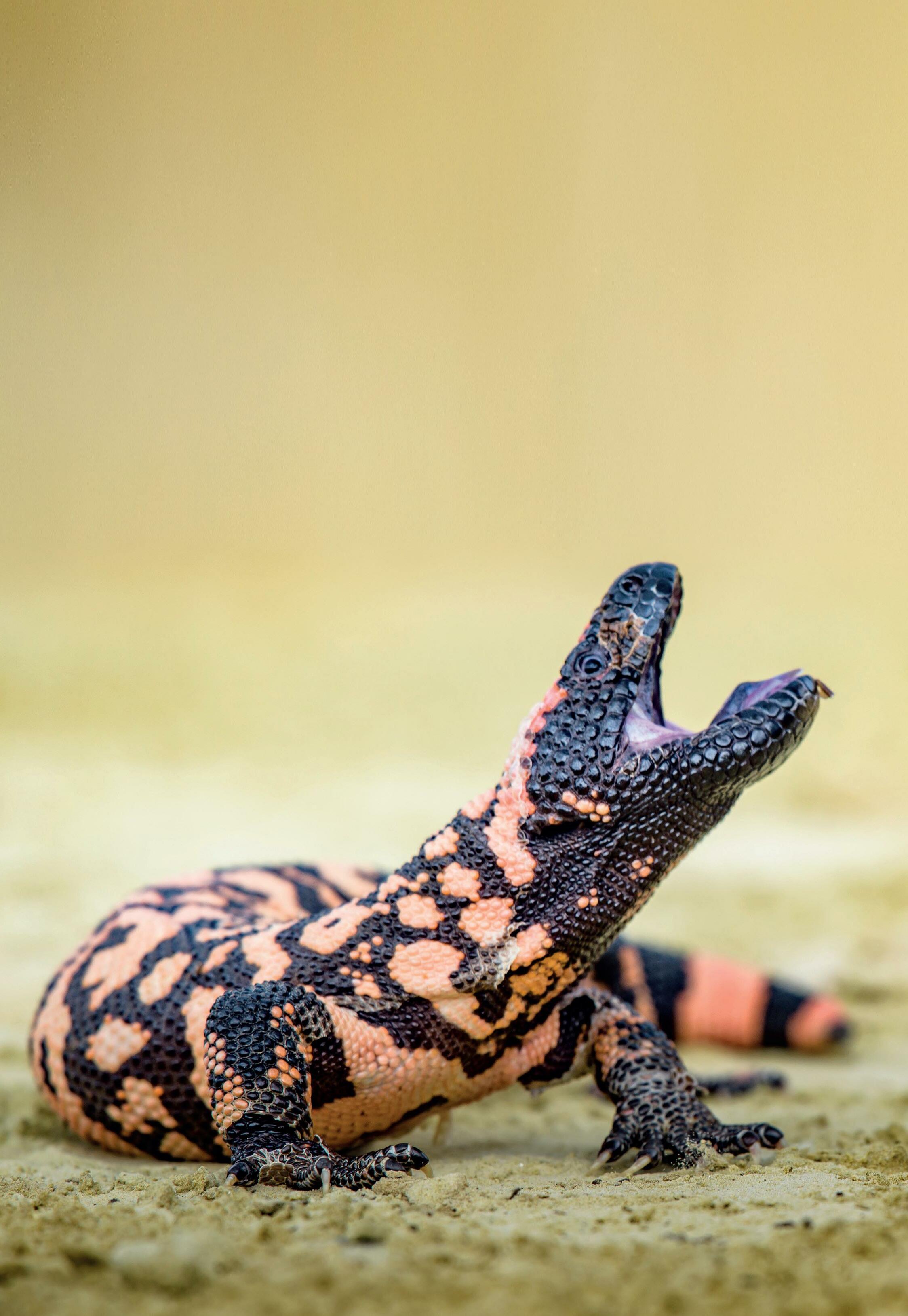
31
Gila monster (Heloderma suspectum)
The Gila Monster (Heloderma suspectum) is one of the most well-known lizards on the planet. Aside from the very catchy name, they’re commonly described as one of only two venomous lizards. We now know that primitive venom glands are present in several species, but regardless, the Heloderma genus certainly has the most advanced delivery methods. Despite a fearsome reputation, these lizards have seen significant threats to their native habitat and population numbers have been declining for around 15 years.
Heloderma
Although it’s easier to describe to budding herpetologists that the two venomous lizards are the beaded lizard and the Gila monster, there are in fact five species belonging to the Heloderma genus. One ‘Gila monster’ and four species of beaded lizard. Populations of all species are currently in decline, with the Guatemala beaded lizard (H. charlesborgoti) now considered an endangered species comprised of fewer than 500 individuals left in the wild.
Despite being a widespread genus, stretching as far north as Utah and as far south as Guatemala, one significant threat links all populations from across each species: agricultural development and road infrastructure. These bulky lizards are predominantly slow-moving terrestrial animals and although some species of beaded lizard are often seen in trees above the ground, their arid habitats make road-crossings a common occurrence and one which rarely fares well for the animal. Couple this with a rather fearsome reputation and it is easy to see why the growing number of human-animal conflicts could seriously impact these prehistoric reptiles.
Gila conservation
Although classified as a ‘near threatened’ species by the IUCN, there is significant cause to believe the Gila monster is facing many threats to localised populations. Outside of the safe havens provided by National Parks throughout the Southwest United States, Gila Monster numbers are continuing to decline.
This species was once abundant across its entire range and in 1952 was the first ever venomous animal to receive legal protection. This was a huge milestone in conservation efforts and helped reinforce positive attitudes towards the lizards, especially within a society that would regularly slaughter rattlesnakes for the potential harm they could cause to people or livestock. Ongoing protection plans have been reinforced with several states keeping a close eye on population numbers. However, being a cryptic species that spends most the year below the ground, there is still much to learn before conservationists can actively implement measures that protect the longevity of the species. With many small towns located alongside rivers and fertile
32 MARCH 2022 Misunderstood
Monsters
grounds which the Gila monster relies on, the growing infrastructure of these areas have seriously fragmented populations. Whilst their legal protection did offer some level of safeguarding, conservation efforts have not been straightforward.

Myths and monsters
Gila monsters have been shrouded in myths and superstition for thousands of years. Native American tribes had varying opinions of the species. Some feared the Gila monster and believed their breath to be deadly, while others celebrated the animal, believing its hide had healing properties. Although vastly different belief sets,
neither provided a positive outcome for the lizards.
These myths were accelerated as settlers colonised the Southwest USA and the human population grew exponentially. Soon, it was widely believed that the Gila monster could kill a person with its breath and spit venom at its victim. Eventually this progressed to more outlandish rumours that the animal would defecate through its mouth, harbouring bacteria instead of venom. Even though these ideas seem absurd, the venom of the Glia monster does have a distinct smell which supported the continuation of these myths.
Throughout the 1800s, the population of America’s Southwest continued to grow and with more people living there, human-animal conflict became more common. Eventually, zoological studies dispelled many rumours but also confirmed the toxicity of the Gila monster’s venom. In urbanised areas where there were small children and pets, the Gila monster was feared, and mortality rates grew. Fast forward to the 20th Century and all states across the Gila monster’s range began pushing for the removal of ‘nuisance’ Gila monsters for decades. However, an important study in 2004 by Brian K Sullivan et al discovered that the relocation of Gila monsters from urbanised areas presented a lot of issues.
33 MARCH 2022
DID YOU KNOW
Misunderstood Monsters
A problematic conservation tool
Sullivan’s study ‘Translocation of urban Gila Monsters: A problematic conservation tool’ assessed 25 Gila monsters that were translocated from the metropolitan areas of Phoenix, Arizona. The ‘nuisance’ animals were fitted with radio transmitters and released into suitable habitat at varying distances away from their capture site. With many Gila monsters going through this process in several cities across their range, the study simulated the experiences of translocated animals that would frequently find themselves in midst of human habitation.
The researchers predicted that many of the animals to be relocated outside of the metropolitan area would return. As burrowing species, Gila monsters require familiar hides with specific microclimates to regulate temperatures and stay hydrated. However, their findings discovered The genus Heloderma is named after the Greek helo meaning ‘wart’ and derma meaning ‘skin’.
Edward Drinker Cope, who first officially described the Gila monster chose to name it Heloderma suspectum because he suspected it to be venomous.
The term ‘Gila’ comes from the Gila River Basin in Arizona, where this species was once plentiful. There are two subspecies of Gila monster, the reticulated (H. s. suspectum) and the banded (H. s. cinctum) forms.

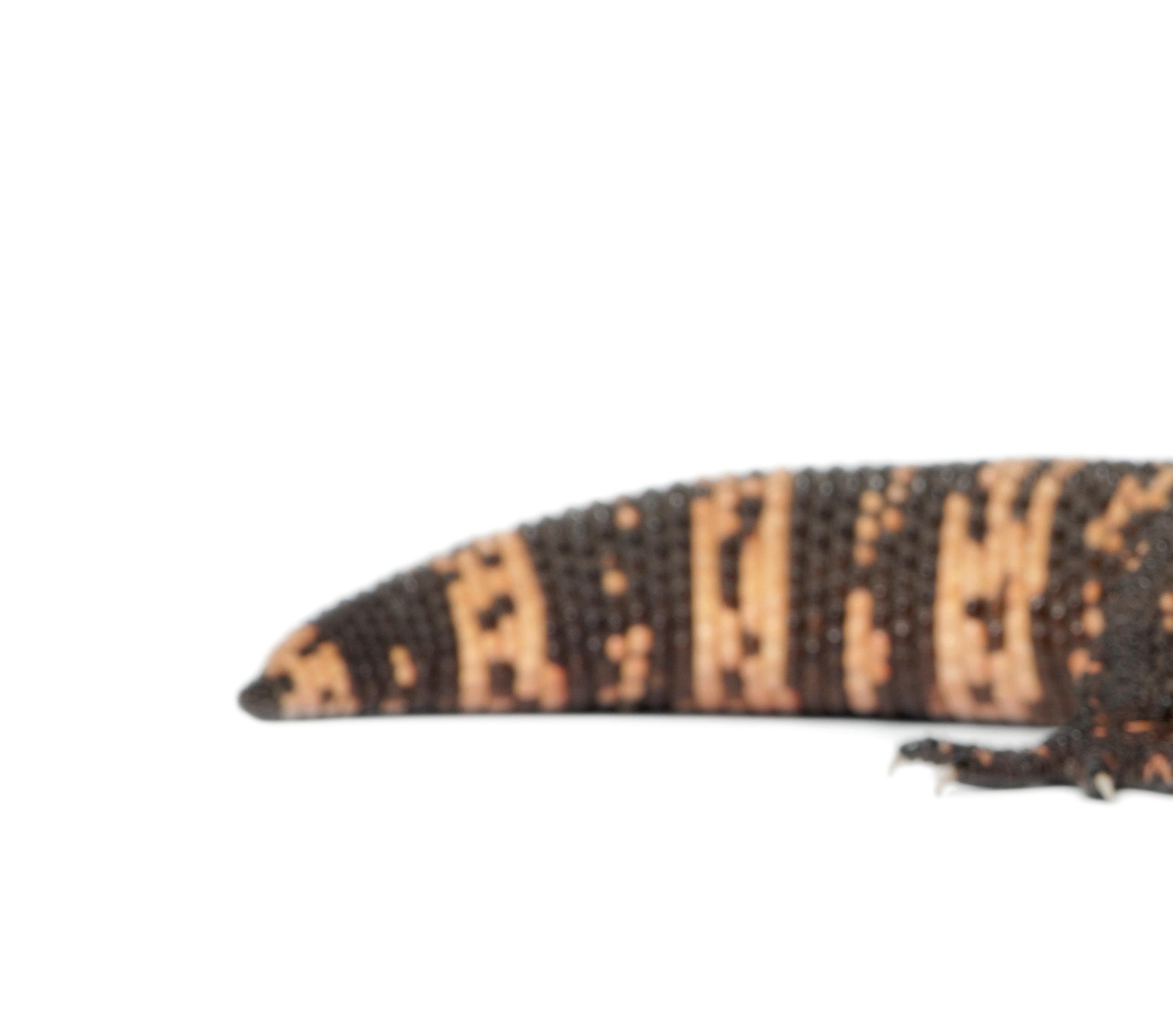
examined. Unfortunately, all adult subjects that failed to return were lost or died, suggesting that translocated individuals do not readily tolerate a novel environment. Translocated Gila monsters exhibited higher mean daily movements, almost five times higher than non-translocated individuals. Increased activity, especially for the typically sedentary Gila monster might entail significant energetic and thermoregulatory costs, as well as predation risks.”
As translocation is not only ineffective but can endanger the lives of Gila monsters, another strategy must be implemented. The paper continues: “Despite this dilemma, we are optimistic that public education by agencies and scientists working on Gila monsters can alter negative opinions, and that this species can be portrayed as an extraordinarily low risk threat to humans, minimizing the need for translocation. Our own interactions with homeowners, for example, demonstrated high interest in the safety and well-being of individual Gila monsters.”
Currently, many rattlesnake species face the same threats of human-animal conflict and while they understandably pose a greater threat, research prompted by the Gila monster study suggests that mortality in these translocations are also exceptionally high. The Gila monster is a perfect example of conservation that necessitates education to succeed.
34
Lovestruck Lizards
34 MARCH 2022
Lifesaving lizard
Despite such widespread myths and rumours surrounding the Gila monster, it would be wrong to completely dispel the truly incredible natural history and evolutionary adaptations that gave this species it’s fearsome reputation. The Gila monster has developed grooved teeth in its lower jaw (much like beaded lizards, Komodo dragons and some Iguanids) to deliver its neurotoxic venom which is comprised of enzymes, hyaluronidase, phospholipase A and serotonin. In fact, Gila monster venom is comparatively as toxic as Western diamondback rattlesnake (Crotalus atrox) venom. However, given the primitive delivery method, a Gila monster would need to chew on its prey for a very long time to deliver a similar quantity of venom as its fangweilding counterpart.
The venom of the Gila monster does contain a few more tricks, however. In the mid 1990’s, Dr John Eng and Dr Jean-Pierre Raufman discovered a hormone called exendin-4 in the lizard’s venom. Under closer analysis, they found that this hormone was very similar to GLP-1 which
is found in human digestive tracts and is used to regulate blood glucose. The pair theorised that this hormone could stimulate insulin production which could prove to be extremely important in fighting diabetes.
Dr Eng licensed the discovery to a pharmaceutical company which worked towards creating a synthetic version of the compound which they called “exenatide”. The formula was approved in the United States by the FDA in 2005 and sold commercially as Byetta. Across the world, Byetta has several different names, but all are designed to help extend the periods in which Type 2 diabetes sufferers must go between taking insulin. Across the world, more than 2 million people use the drug to support their health whilst living with the disease.
More recently, Gila monster venom has been found to inhibit the growth of some cancer cell lines. The venom, which contains a protein called ‘helodermin’ has been studied since the 1980s. New research is beginning to paint a picture for potentially life-saving drugs that we would not have access to without the Gila monster.
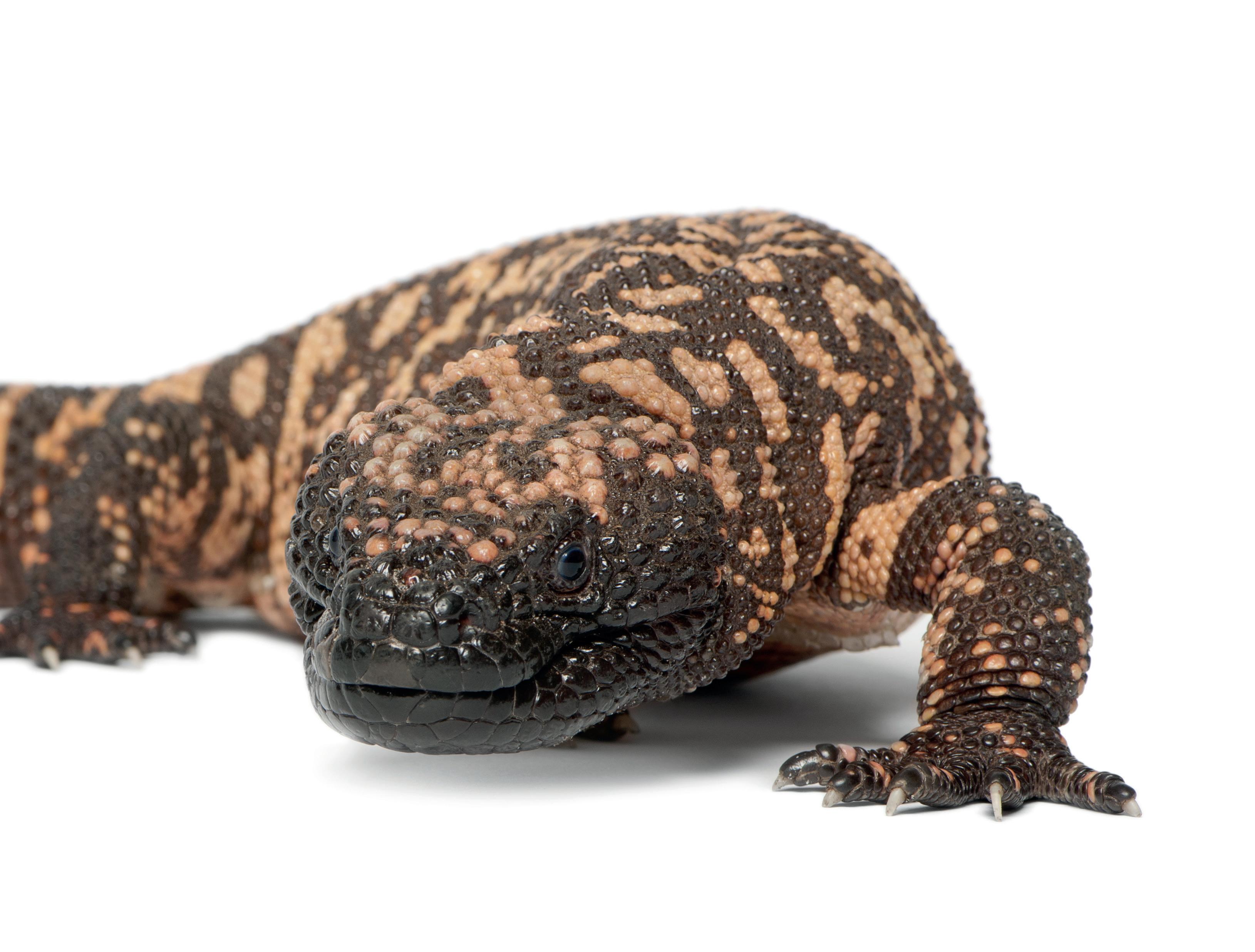
Misunderstood Monsters
“Populations of all species are currently in decline, with the Guatemala beaded lizard (H. charlesborgoti) now considered an endangered species comprised of fewer than 500 individuals left in the wild.”
DRY FOODS, FORMULAS & SUPPLEMENTS











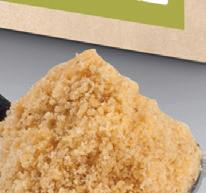











Not all parrot food is created equal. The Psi�acus range of complete parrot foods features over 50 dis�nct products which are widely regarded as the best on the market.
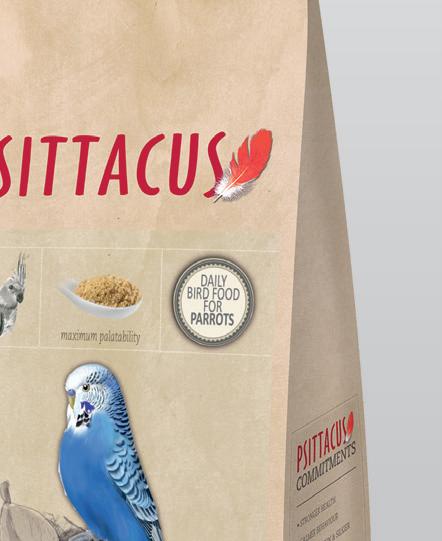







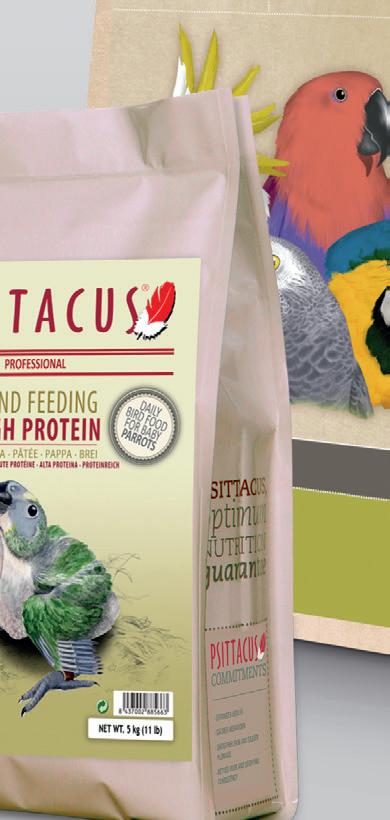




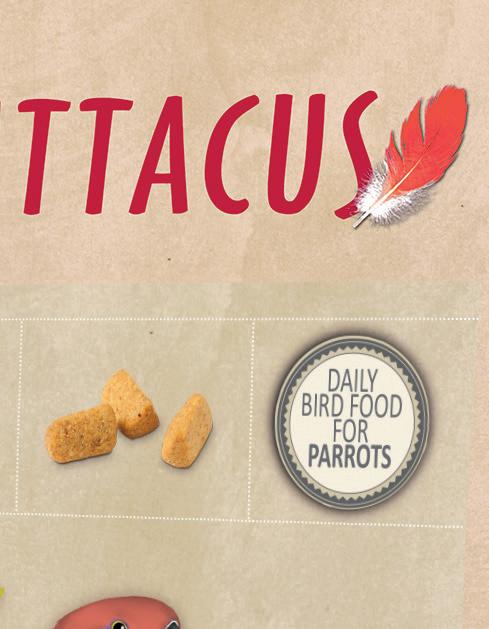
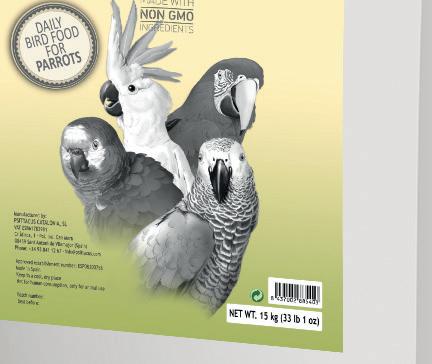

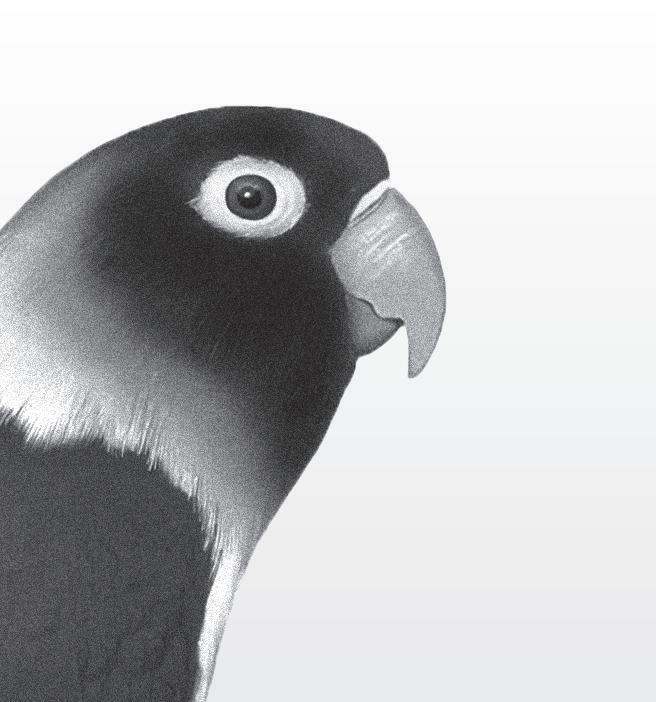
For over 20 years Psi�acus have developed and refined the range at their dedicated research laboratory and extensive breeding facility, along with collabora�on with other respected breeding centres.



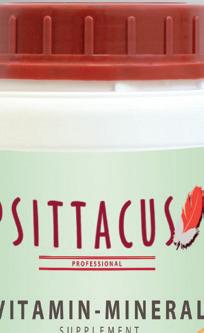






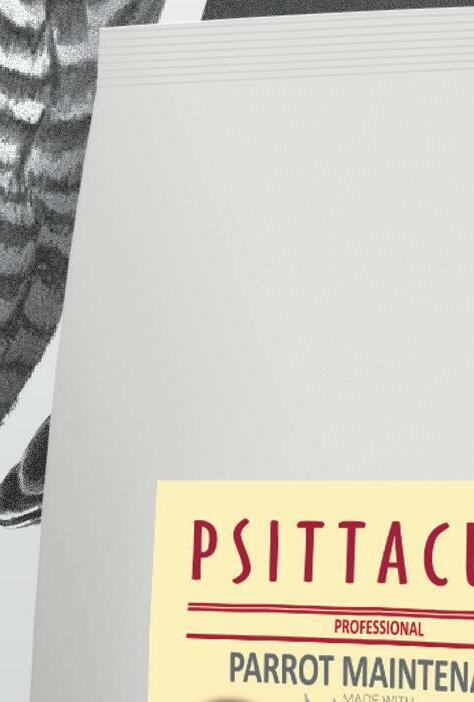

The result is a range of pelleted complete diets with proven benefits including: Speed of growth of the young, its weight and overall development | Improved appetite and increased daily consumption Improved digestive processes | Prevention of the bacterial and fungal proliferations in the craw Improved plumage quality, general appearance and behaviour | Improved reproductive success
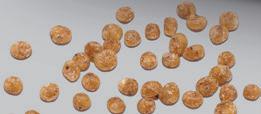

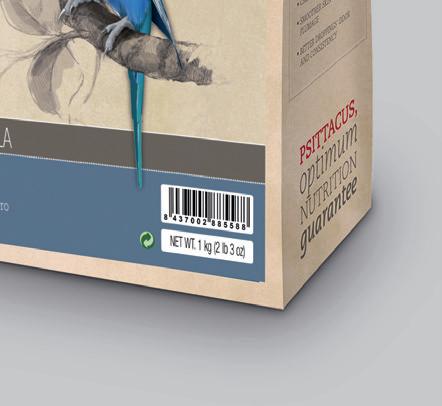

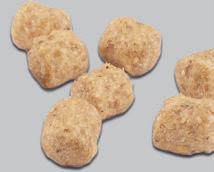






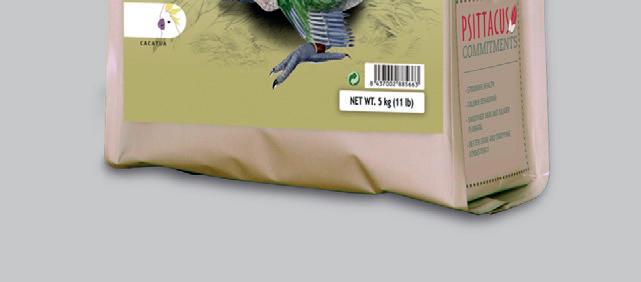


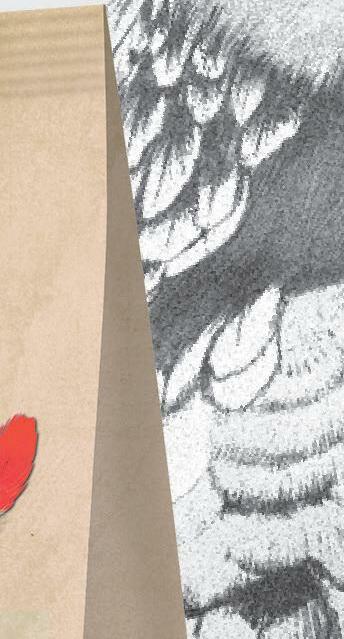

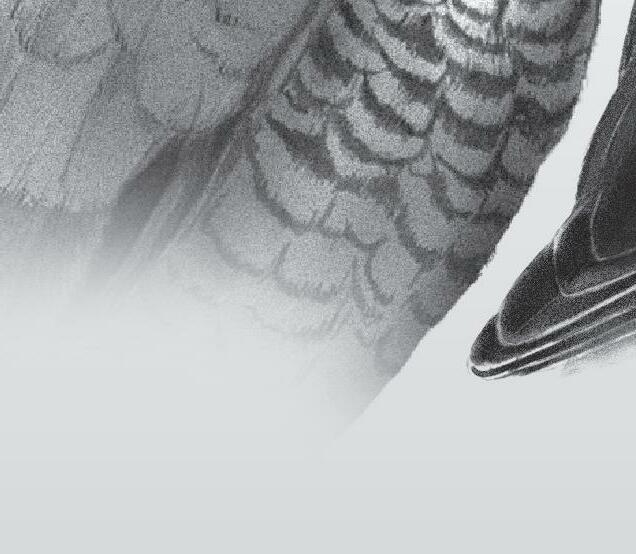
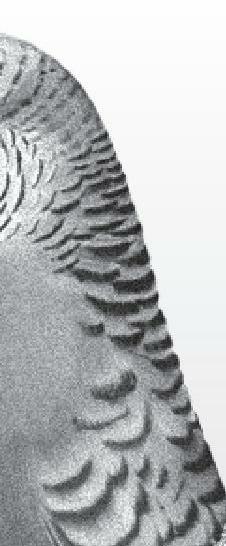
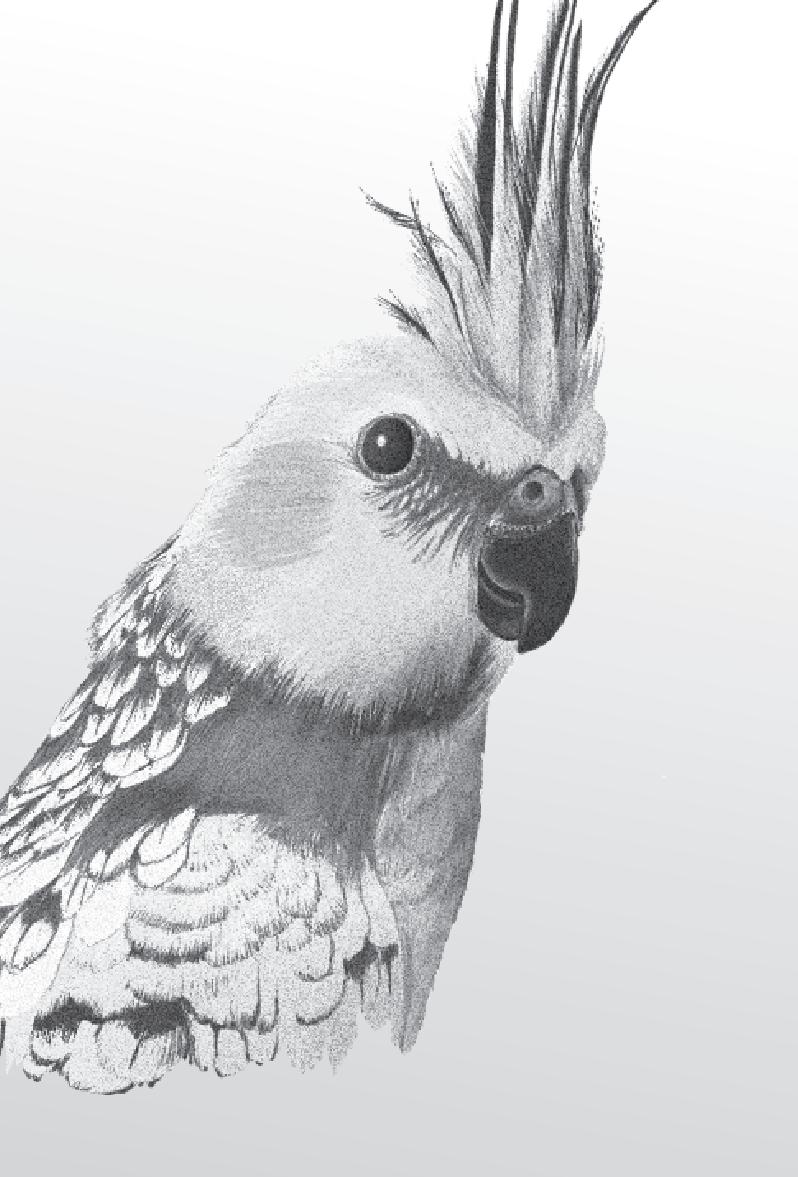





36
KEEPER BASICS: LIGHTING


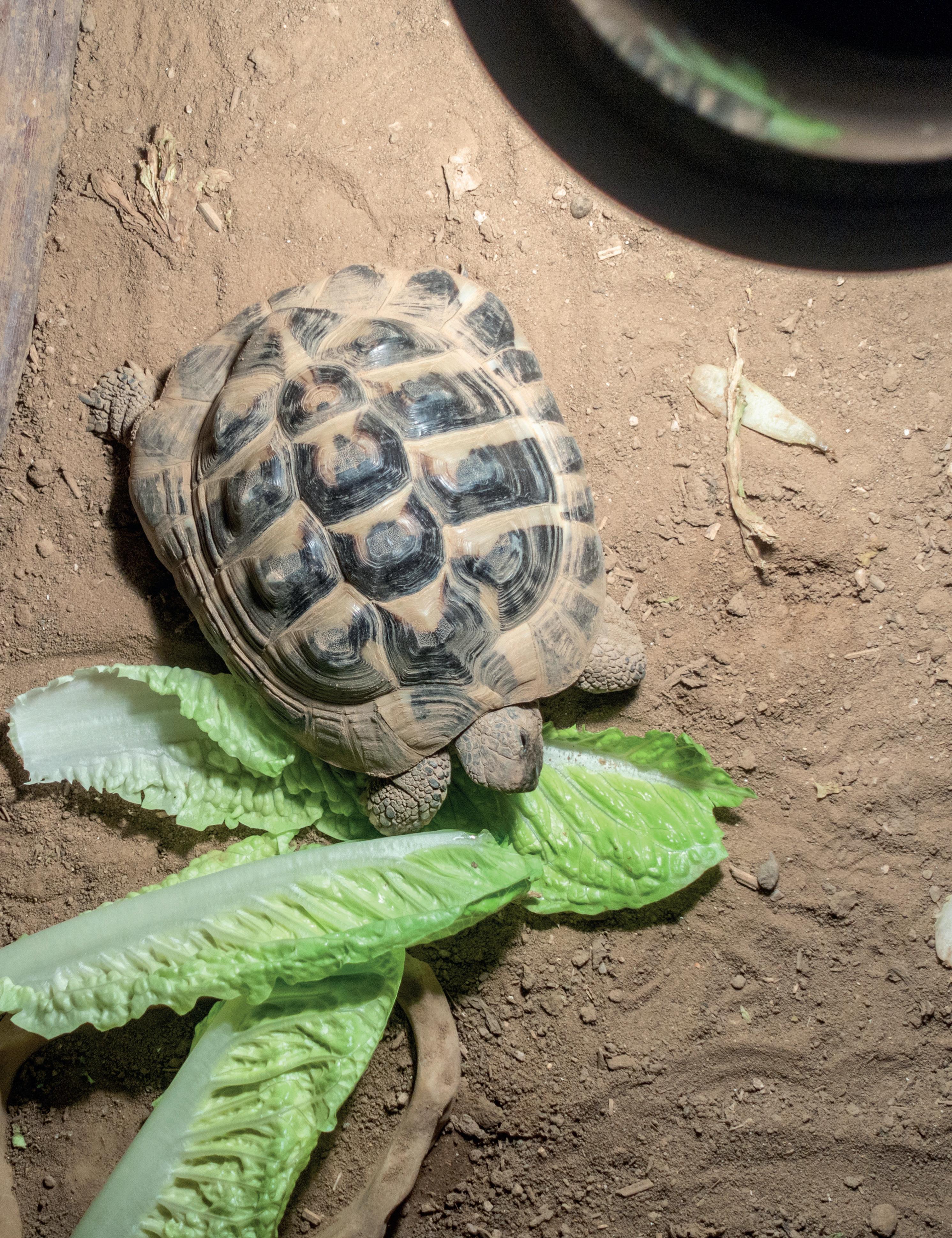 Keeper Basics: Lighting
Keeper Basics: Lighting
One of the key components to providing good animal welfare is the provision of natural light. It is very easy to be overwhelmed by the choices available, but by understanding the spectrum of light produced by the sun, we can begin to define which is best for our animal.
Replicating the sun
The sun gives off electromagnetic radiation which is filtered by the Earth’s atmosphere. This consists of infrared, visible, and ultraviolet light. Different animals have different adaptations to their vision which influences what they can see of the electromagnetic spectrum. As the name suggests, we humans only see the ‘visible’ portion with our natural eyesight.
UV
• UVC cannot reach the Earth as it is blocked by both the ozone layer and the upper atmosphere of the planet. That’s good as UVC would be extremely damaging to cells.
• UVB is an important component in biology on Earth and this spills over into the husbandry of our captive animals. Its main function is to facilitate the production of vitamin D in animals. Of course, too much is harmful,
but it is essential in the correct amounts depending on the species.
• UVA is not seen by the human eye but for many animals, reptiles included, it contributes to vision and comprehension of the environment around them.
Visible Spectrum
• This is light that ranges through indigo, blue, green, yellow, orange and red. This then spills into the infrared wavelengths that we cannot see but feel as heat energy.
• Organisms on Earth also utilise these wavelengths for many functions. Plants in particular need red and blue wavelengths from the spectrum for photosynthetic processes. Therefore, LED lights are great at facilitating plant growth as they focus on producing these colours specifically.
38 MARCH 2022
• For us and other animals, the detection of this spectrum influences our natural physiological rhythms (such as the circadian rhythm) by allowing us to process night and day transitions. Hence, why blue light emitted from electronic screens can cause sleeping issues.
Infrared
• This is separated into near, mid and far infrared (NIR, MIR and FIR) or infrared A, B, and C.
• We cannot see infrared, but some animals can. Snake species detect infrared to hunt warm blooded prey.
• IR-A is the highest energy infrared (short wavelength = high frequency = high energy) and this decreases through IR-B and IR-C. It is important to note
that bright light (mimicking the daytime sun) prompts basking behaviour in ectothermic animals such as reptiles because they seek sources of IR-A to deeply warm their tissues (approximately 35% of sun radiance is IR-A).
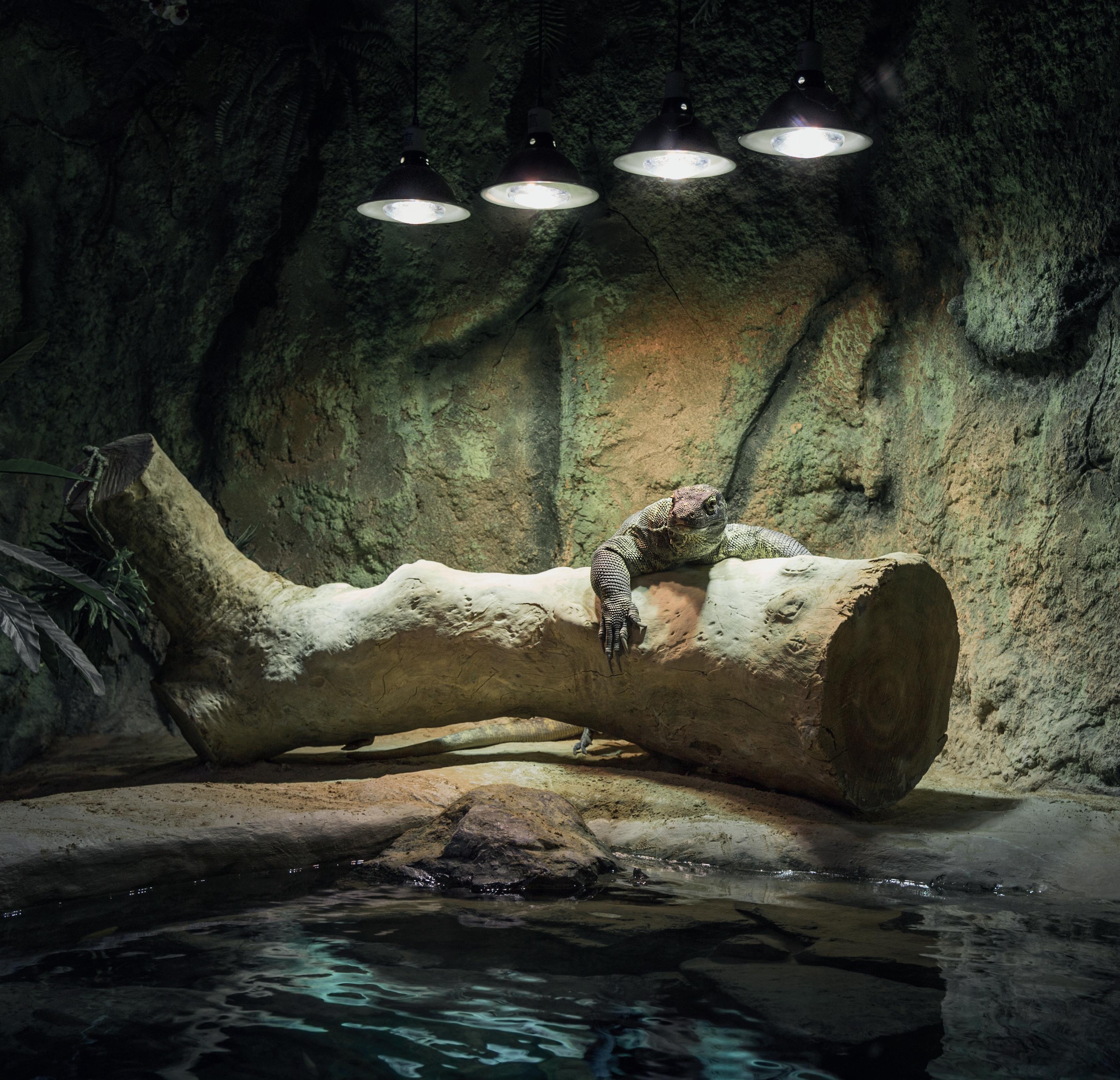
What does UVA mean to reptiles and amphibians?
Most reptiles (diurnal lizards in particular) have a fourth retinal cone associated with colour vision, whereas humans have three. This fourth cone is sensitive to UVA, which allows them to perceive more colour than we do. This is thought to be associated with prey and mate detection, especially in species with vibrant skin pigmentations. Therefore, UV lighting needs to be provided if reptiles are to have access to their full spectrum of vision.
39 MARCH 2022
Vitamin D is produced from provitamin D3, also known as 7-dehydrocholesterol. This is already produced naturally in the body by cells in the epidermis. However, UVB is required to begin its conversion into usable D3. It is also worth noting that vitamin D3 is a hormone and not a vitamin because it is predominately produced by the body with very little coming from the diet. This hormone has many functions from improving the functions of the immune system, signalling the gut to absorb calcium, to binding calcium to the skeleton. Without proper calcium uptake, it is instead taken out of the bones, leaving them weak and fracture prone. They often then end up bending and becoming misshapen, leading to a crippling condition called metabolic bone disease (MBD).
Additionally, herptiles that are reproducing need adequate calcium for egg production. Lacking at this time can cause reproductive issues, exacerbated calcium taken from the bones, and even a condition known as ‘egg binding’ (the eggs are unable to pass out of the body).
Keep in mind that UVB is blocked by glass and most plastics, so UV wavelengths will not reach an animal through the transparent walls of their enclosure. This also poses a big risk of overheating the interior.
Picking the right product
The first step in choosing correct lighting is to determine what strength of UVB your animal needs. This comes from data collected on how wild specimens act, and where they live. Since Ferguson Zones were created with real behavioural data, they are considered the most accurate way of grading UV sources.

Following Gary Ferguson’s original study, the ‘UV-Tool’ was created by several prominent zoologists and researchers on the BIAZA RAWG committee. More than 200 species’ UVB requirements have now been estimated thanks to these developments. Subtle nuances such as physiological differences in nocturnal species, UV absorption of albino and hypomelanistic individuals and more vital information is available to access. This information is free to access online and is invaluable when choosing lighting products for captive animals.
Fluorescent tubes
The most popular and arguably the easiest way of providing UVB to reptiles and amphibians is with the use of a fluorescent tube.
T8 Tubes: The ‘older’ model of fluorescent UVB tubes, The T stands for tubular and the number immediately following the T gives the diameter of the lamp in eighths of an inch (25.4mm). They provide adequate UVB strength when used with a reflector at the manufacturer’s recommended distance – this is usually 8-10 inches between the tube and the animal’s skin. These can be used without a reflector for species that do not seek out higher levels of UVB.
T5 Tubes: Newer on the market and often described as ‘High Output’. They have a diameter of 5/8ths of an inch (15.88mm). The light from T5s are often stronger and brighter, and do not flicker as T8s are known to do. The better strength does mean that the safety distance is increased for T5s – generally around 12 inches.
Depending on the dimensions of your setup and the needs of you animal, T8 and T5 tubes with or without reflectors both have solid positions in the hobby.
40 MARCH 2022
Keeper Basics: Lighting
What does UVB mean to reptiles and amphibians?
Compact Fluorescent UVB Bulbs &


































































UVB/LED Bulbs

These produce a low level or diffused amount of UVB at standard basking distances and can be used with a canopy/hood top. Equally, these compacts now come as combined UVB/LED units, giving you a full spectrum of light, perfect for plant growth in a single unit.
When providing UVB of any sort, but particularly with a compact bulb, it’s important to provide a photogradient. This means plenty of shaded areas and different elevation points that gives access to the full range of UVI. Your animal can then bask or hide as it pleases throughout the day.
Overexposure may cause eye issues (photokeratoconjunctivitis) in reptiles, so ensuring the bulb is placed above the enclosure and at a suitable distance is important.
Mercury Vapour Lamps
Specialist reptile mercury vapour lamps are produced with a special glass so that UVB rays can pass through, whilst also creating heat and visible light. This may seem extremely convenient, but there are some caveats.
Firstly, these lamps cannot be thermostatically controlled.
This makes them extremely impractical for most hobbyists at home. They must also be positioned carefully so that the animal has the correct exposure of heat and UV. These lamps are most often used by zoos, in large enclosures with decent height to allow for sufficient safe basking distances.
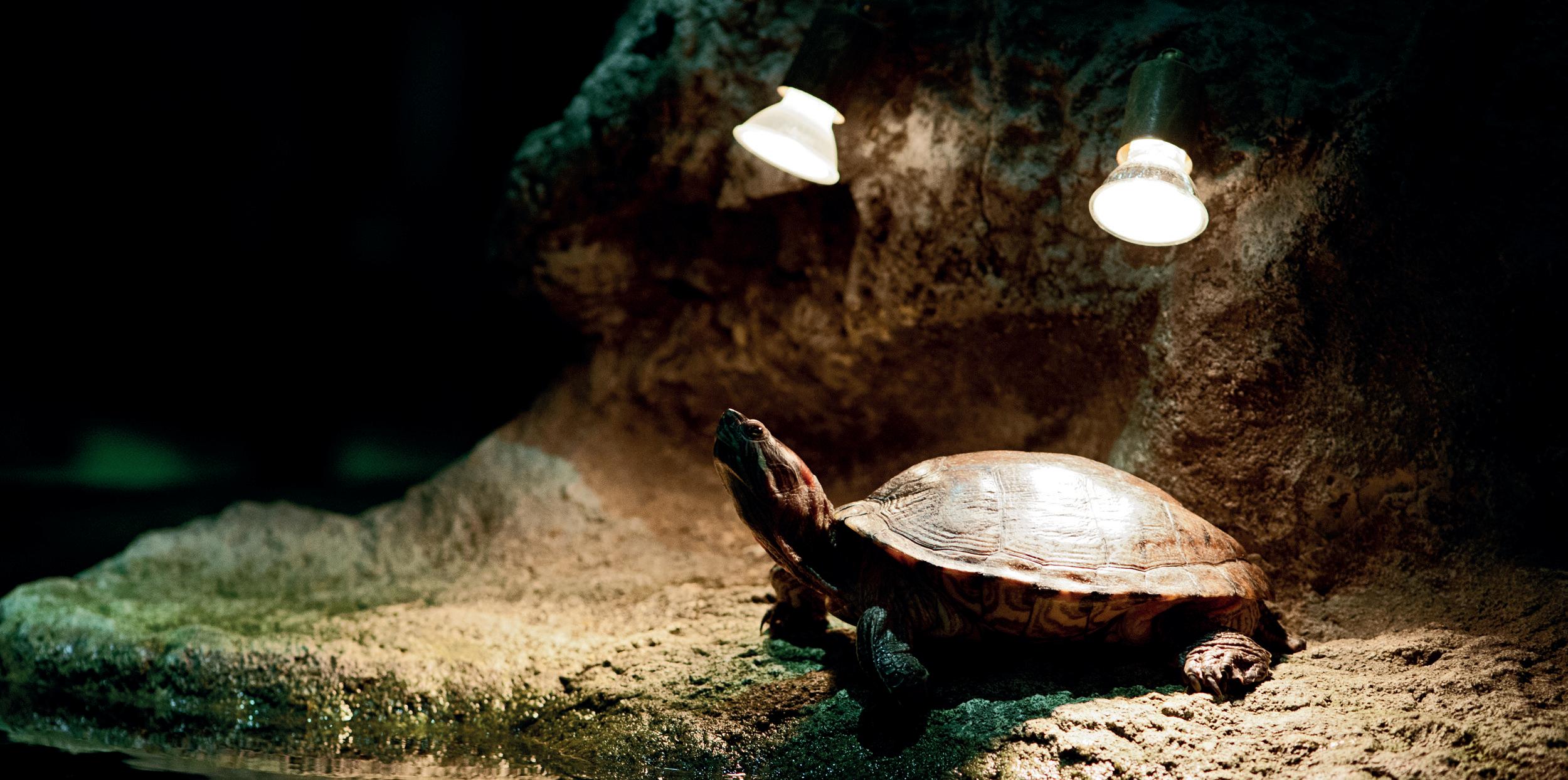
Without a wide enough beam, the lighting may result in uneven exposure and could lead to complications. Zoological and professional facilities will generally have access to a Solarmeter to take regular readings and ensure precision of the setup.
Metal Halide Lamps (H.I.D)
Like mercury vapour lamps, specialist metal halide lamps (HID) also produce heat, visible light and UVB but they must be powered by an external ballast. These lamps are also unable to be thermostatically controlled, however, the heat generated by these lamps is not as intense as a mercury vapour lamp and are available in lower wattages enabling a wider range of use amongst different species.
In addition to lower temperatures, these lamps also provide a much better visible light spectrum than most other types of lamps on the market and are ideal for bioactive set ups. However, they are again, more suitable for large custom enclosures.
41 MARCH 2022
Halogen/Incandescent Lamps
The most common heat and light source combo, incandescent lamps (or tungsten filament lamps) are great for their heat output. These lamps have been at the forefront of herpetology for many years due to the heat that they produce (primarily IR-A and IR-B for ideal basking conditions). They do not provide essential UVB and so must be used alongside a UVB lamp. Halogen lamps work in the same way as incandescent lamps but have added halogen gases which supress the tungsten on the filament. This increases the pressure in the lamp resulting in a better colour temperature that is whiter than the traditional incandescent lamp. Ensure a heat guard is used where appropriate.
LED Lights
LED lighting is most often used in a bioactive setup as they will put out the correct photosynthetic wavelengths that plants need to thrive. 400 – 700 nanometre wavelengths are needed, as well as 5500 – 6500 Kelvin output which

Summary of Lighting
is closest to natural sunlight (this describes the ‘colour temperature’). In relation to animals – LEDs provide a bright daytime light, but no UV or significant heat.

Coloured Bulbs
Red, green, and blue or purple bulbs are common in the exotic pet industry. However, these hold no benefits for our animals and in fact, could be harmful in the long-term.

It used to be said that reptiles could not see into the red spectrum, especially if they were nocturnal. However, while some nocturnal reptiles do lack red-sensitive cones in their eye structure, their green-sensitive cone does respond to the light source, meaning they are aware that they are not in darkness. Night lamps such as ‘moonlight bulbs’ are obviously much brighter than the light reflected from the moon and are definitely detectable at night. The main consequence of this is the interruption of your animal’s circadian rhythm. Even if they are nocturnal, it can be disturbing and detract from their natural behaviours.
• Identify the UVB needs of your animal first and foremost.
• Pair UVB with a visible spectrum basking lamp for complete spectrum vision. These should be positioned together at the ‘warm end’.
• Use thermostats as well as guards and reflectors where needed. Always refer to manufacturers’ guidance.

• Keep lighting directly overhead and at a safe distance.
• Ensure heat is spread over a wide area.
• Replace UVB lighting as per manufacturer’s guidance or via assessment with a Solarmeter.
• Set the photoperiod accurately to your species’ requirements, changing for seasonality where applicable for optimisation.
42 MARCH 2022












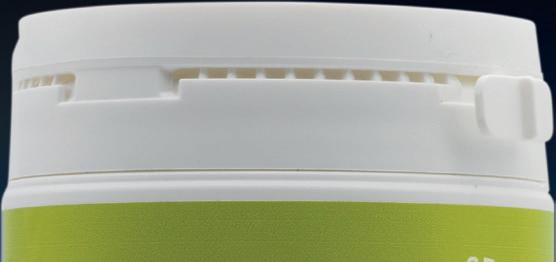
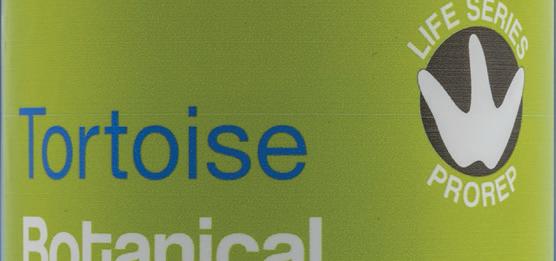

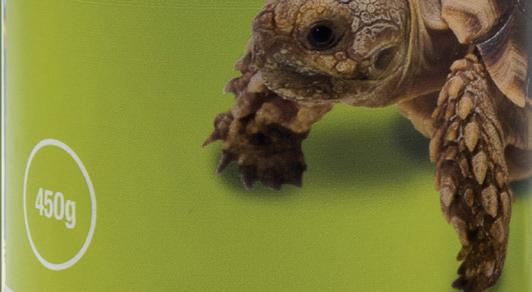
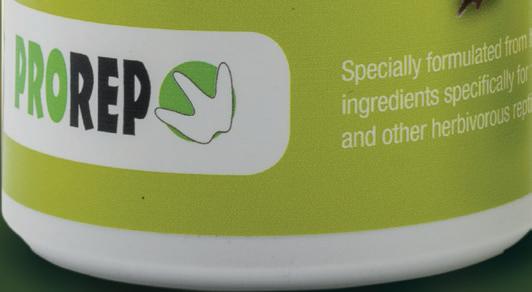

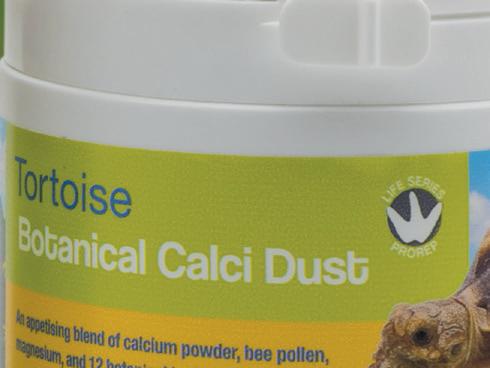




SOLARMETER™ IS YOUR REPTILE HEALTHY & SAFE? SolarMeter.com | Glenside, PA USA | 1-215-517-8700
®
handheld
safety
your
Tor toise Botanical Calci Dust LIFE S ERIES PRO REP A premium calcium supplement. Fortified with magnesium, bee pollen and 12 botanical herbs and flowers which add natural vitamins and minerals to create an appetising dusting powder. Botanical Calci Dust is great for tortoises and any other herbivorous and omnivorous animals which routinely require calcium supplementation. www.pro-rep.co.uk
Solarmeter
point-and-click
meters ensure the health and
of
reptile. The Model 6.2R is used to monitor lamp intensity and lamp life. Similarly, the Model 6.5R measures the UV Index related to the Vitamin D action spectrum and Ferguson Zones to identify reptile-safe basking areas.
Life Tortoise




ProRep’s Tortoise Life is the ideal substrate for Mediterranean and Russian tortoises.


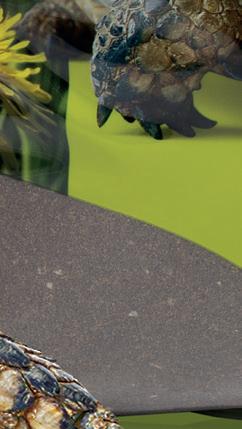
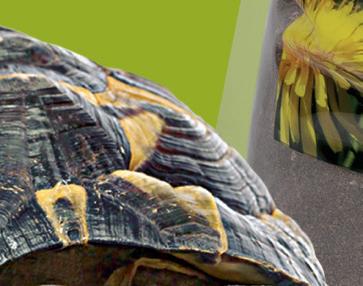












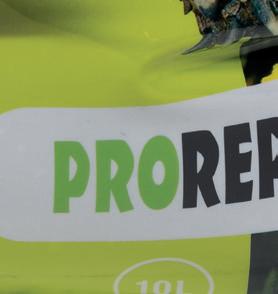


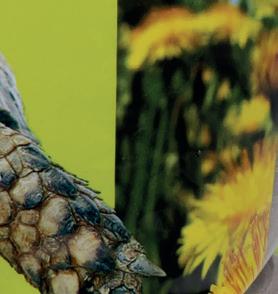
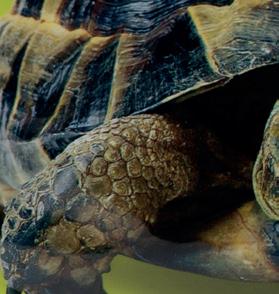
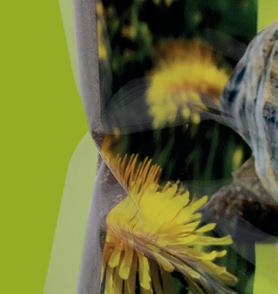



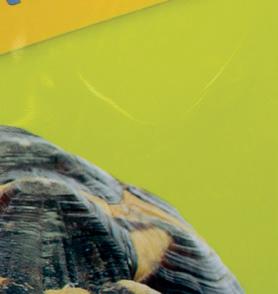

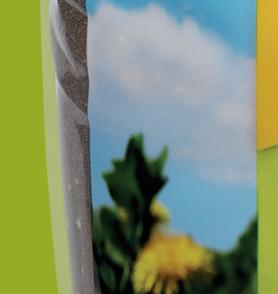



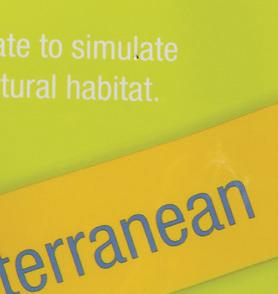





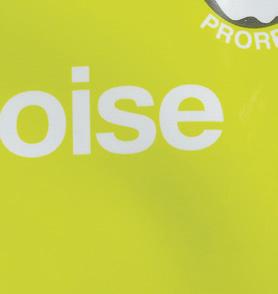





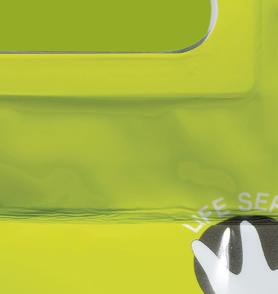
















It consists of high-quality loam topsoil and sand with some added limestone grit, which provides a great digging texture. Tortoise Life is trusted by expert keepers and zoos nationwide.
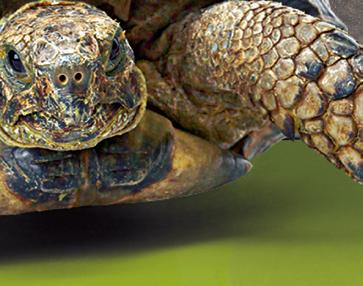
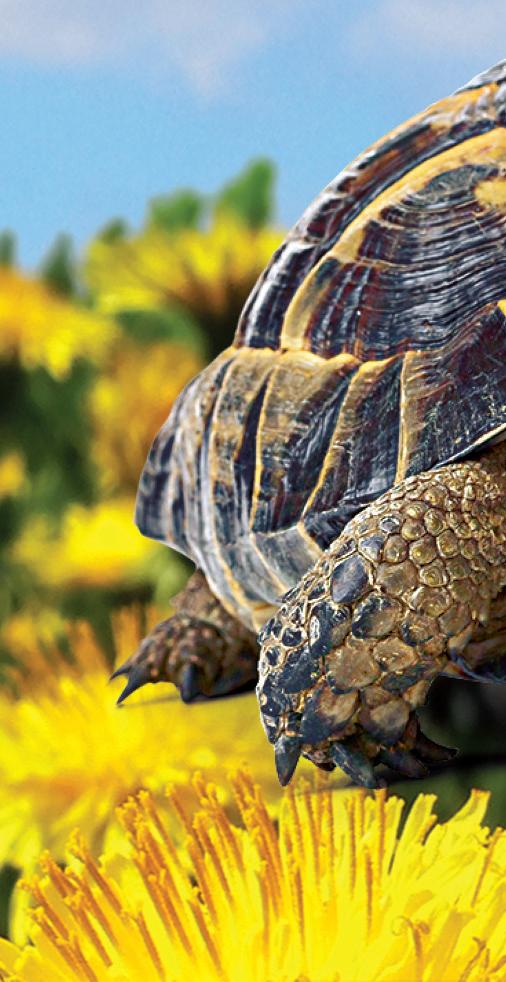

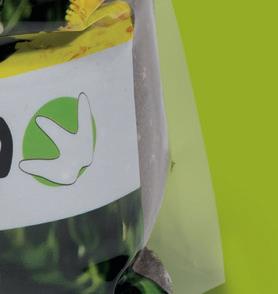
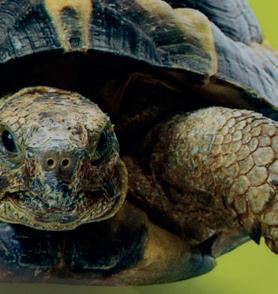
MARCH 2022
FASCINATING FACT
Pick your poison
In naturalist and herpetologist circles across the world, fewer people are using the term ‘poison dart’ or ‘poison arrow’ frogs. This is because there are actually only three species that can be accurately referred to as poison dart frogs: Phyllobates terribilis, P. aurotenia and P. bicolor are the only species on record to have been used by indigenous tribes to poison hunting arrows. Phyllobates terribilis ‘terrible’ poison dart frog is almost 20 times more toxic than most other species and is considered one of the most toxic animals on the planet.
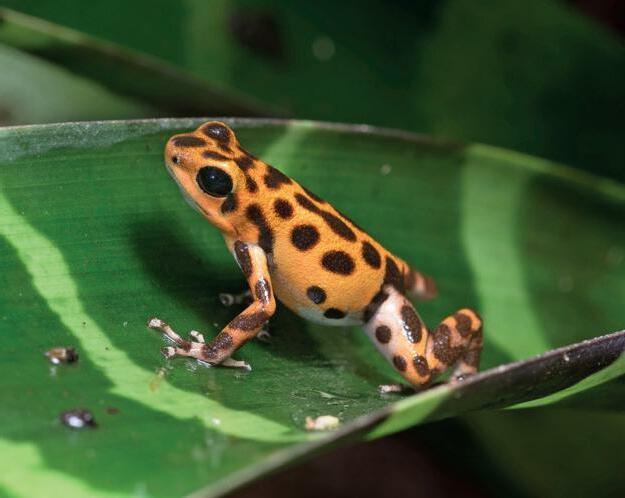
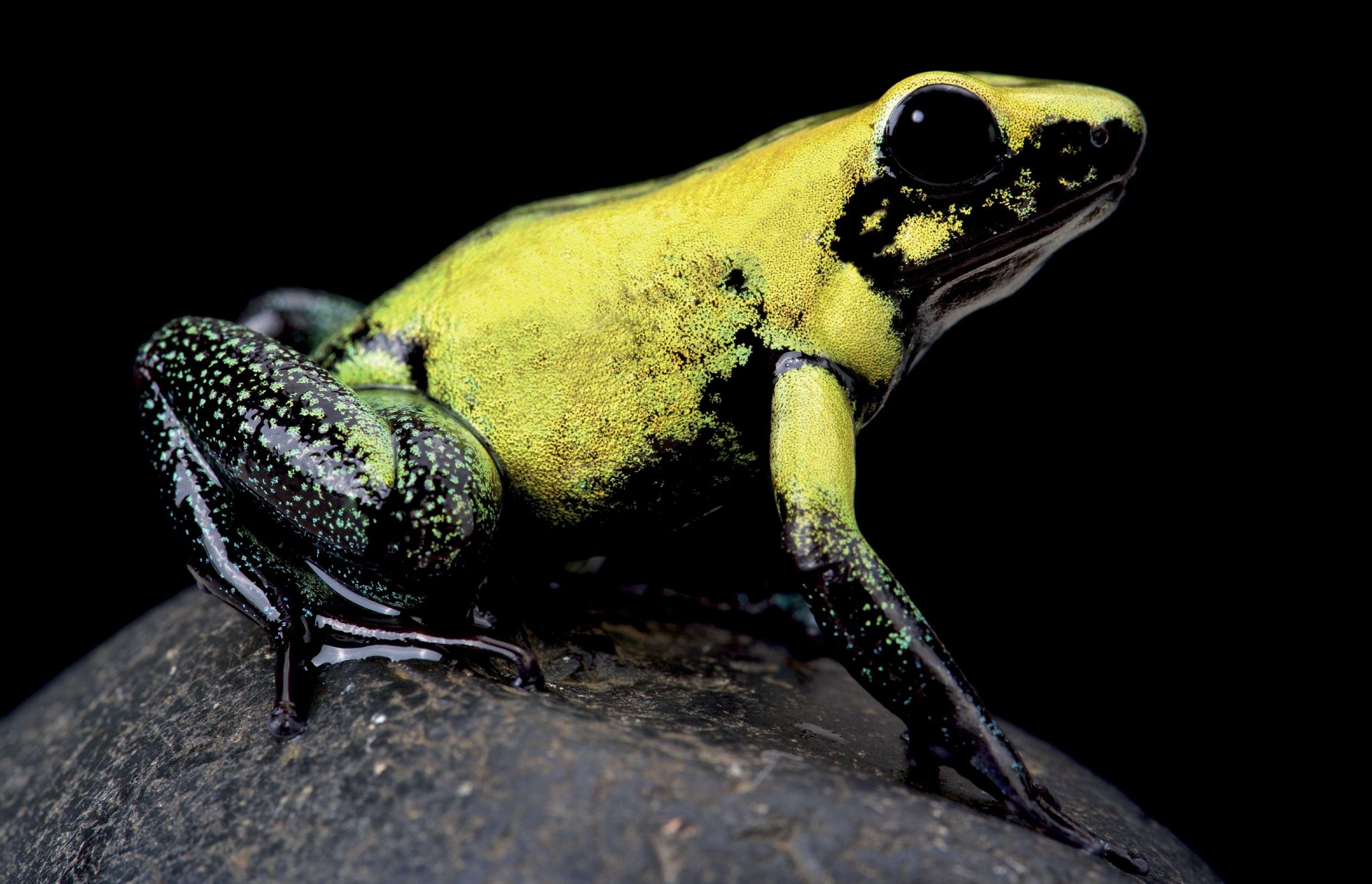
Nowadays, herpetologists refer to the Dendrobatidae family as ‘poison frogs’. This family is currently comprised of 336 species from 20 different genera. However, as some of the most polymorphic species on the planet (Oophaga pumilio or the ‘strawberry’ poison frog being the most), they are found in such a wide spectrum of colours and patterns that new species and locales are still being described. In fact, the strawberry poison frog, despite only having a small range stretching along the Caribbean coast between Nicaragua and Panama, has 102 recorded colour morphs. In the Bocas del Toro region of Panama, a very small group of islands in the Northeast, there are over 20 entirely different colours of the same species.
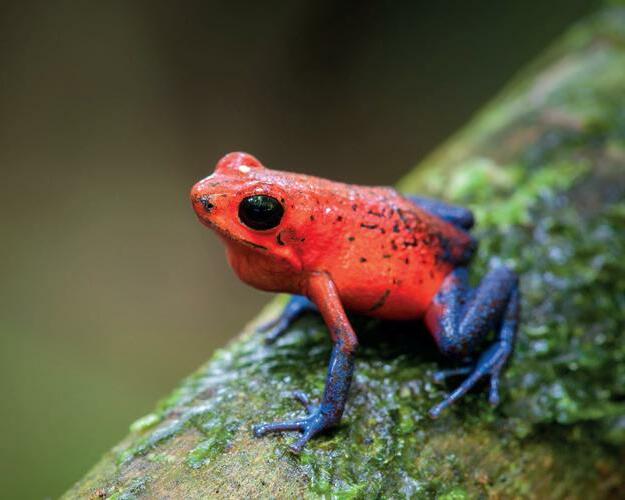
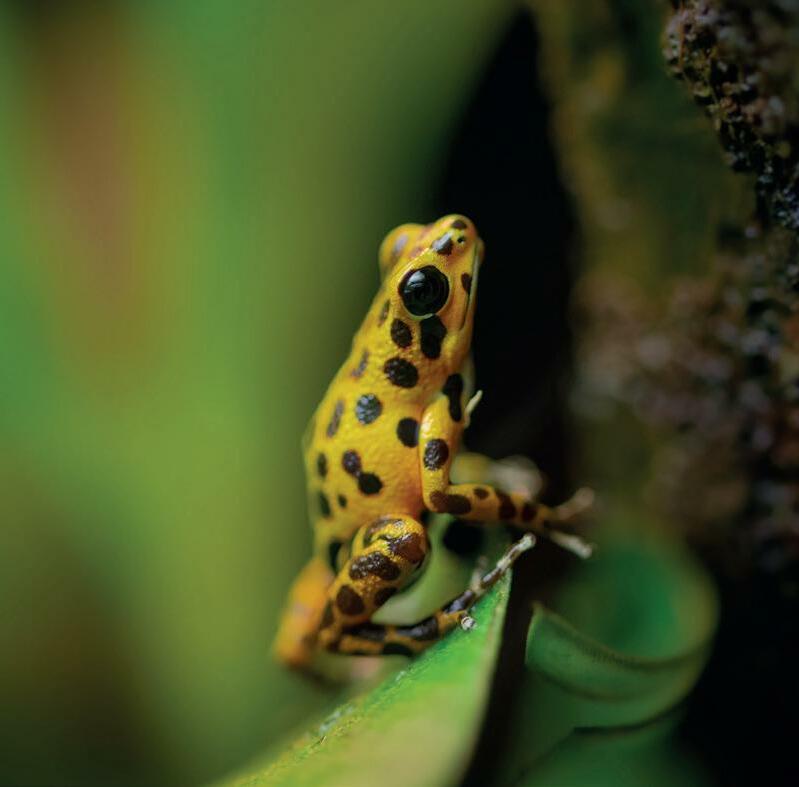
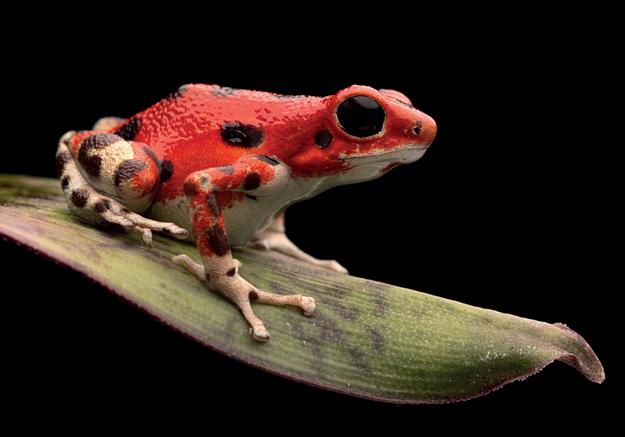
45 MARCH 2022 Fascinating Fact
Poison dart frog (Phyllobates bicolor)
Some of the variations in Oophaga pumilio
ENRICHMENT IDEAS
Seasonality
Enrichment is the pinnacle of good animal welfare. It converts husbandry goals from “keeping an animal alive”, to “allowing the animal to thrive”. Enrichment is a broad term and a multi-faceted approach is key. Enrichment doesn’t just benefit the animal but gives us keepers new and exciting ways to interact or observe our animals. In this new monthly feature, EK discusses some of the best enrichment ideas that are being used today. Please submit your own ideas to thomas@exoticskeeper.com.
1. Realistic daylight hours
Once a keeper knows the core concepts of lighting and can confidently provide a spectrum that simulates sunlight, they can begin to experiment with seasonality. On a very basic level, adjusting the daylight hours to mimic the wild conditions of the species is a great way to provide enrichment. Data on the country of origin can be found on timeanddate.com.
2. Fine-tuned lighting and heating
opposed to ‘summer’ and ‘winter’. Setting up a fogger or misting system that represents these two distinct seasons is a great way to create a more natural environment. Many amphibians will require this seasonality to breed, but even the most novice keepers can still provide some enrichment to their animals by doing this. Again, it is worth checking timeanddate.com as a reference point. However, if you know that the ambient temperatures in the home will drop in winter or rise in summer, it can be beneficial to use this to your advantage and simulate a ‘wet’ and a ‘dry’ accordingly.
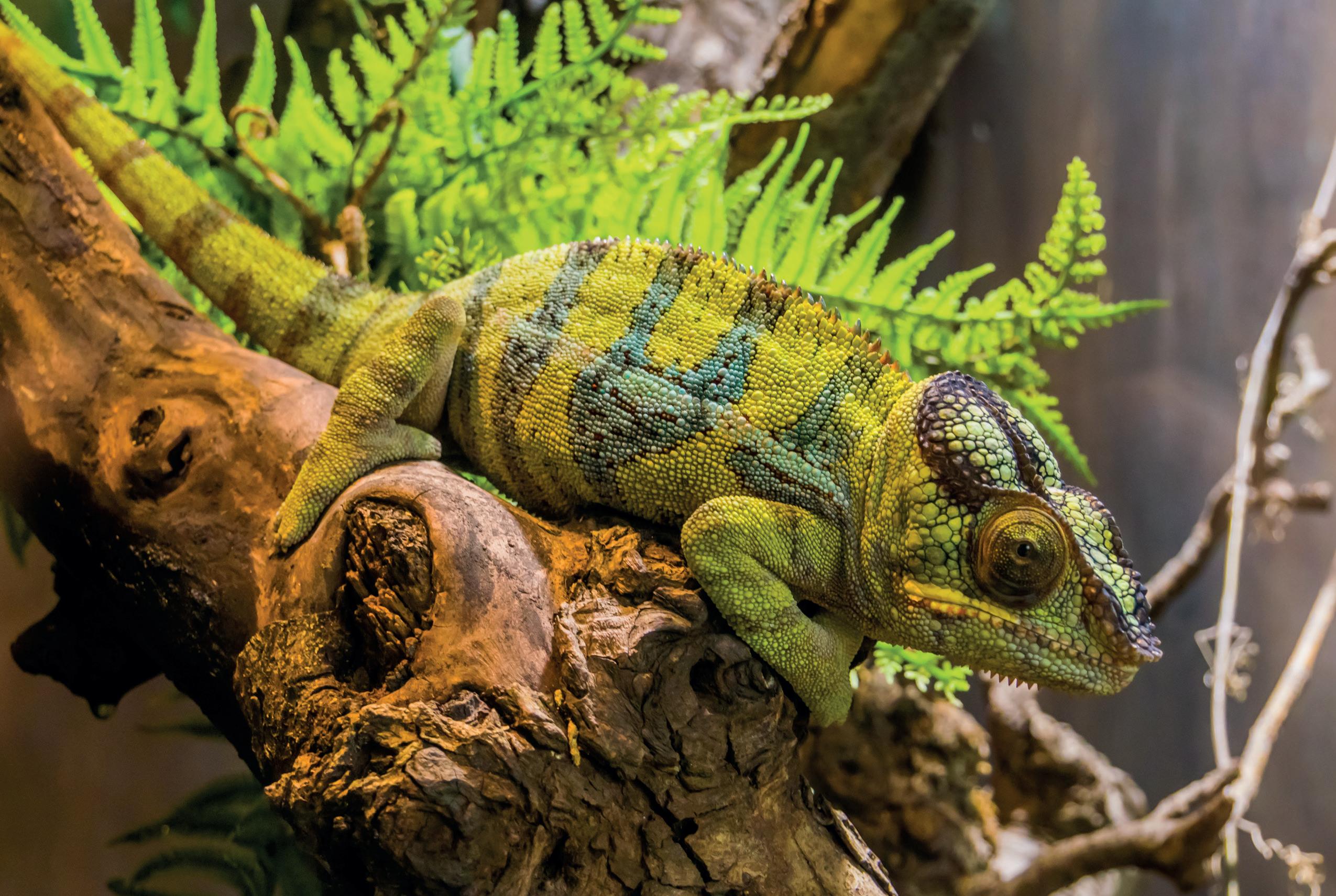
4. Décor choice
Scheduling in a ‘spring clean’ of all vivaria can provide an excellent opportunity for the keeper to get creative beyond the routine maintenance required to keep a species. Researching the natural habitat of a species, networking with researchers or residents in that area and planning a new enclosure layout can provide some great enrichment opportunities. No natural habitat remains the same all year round and depending on the species; increased
Enrichment Ideas
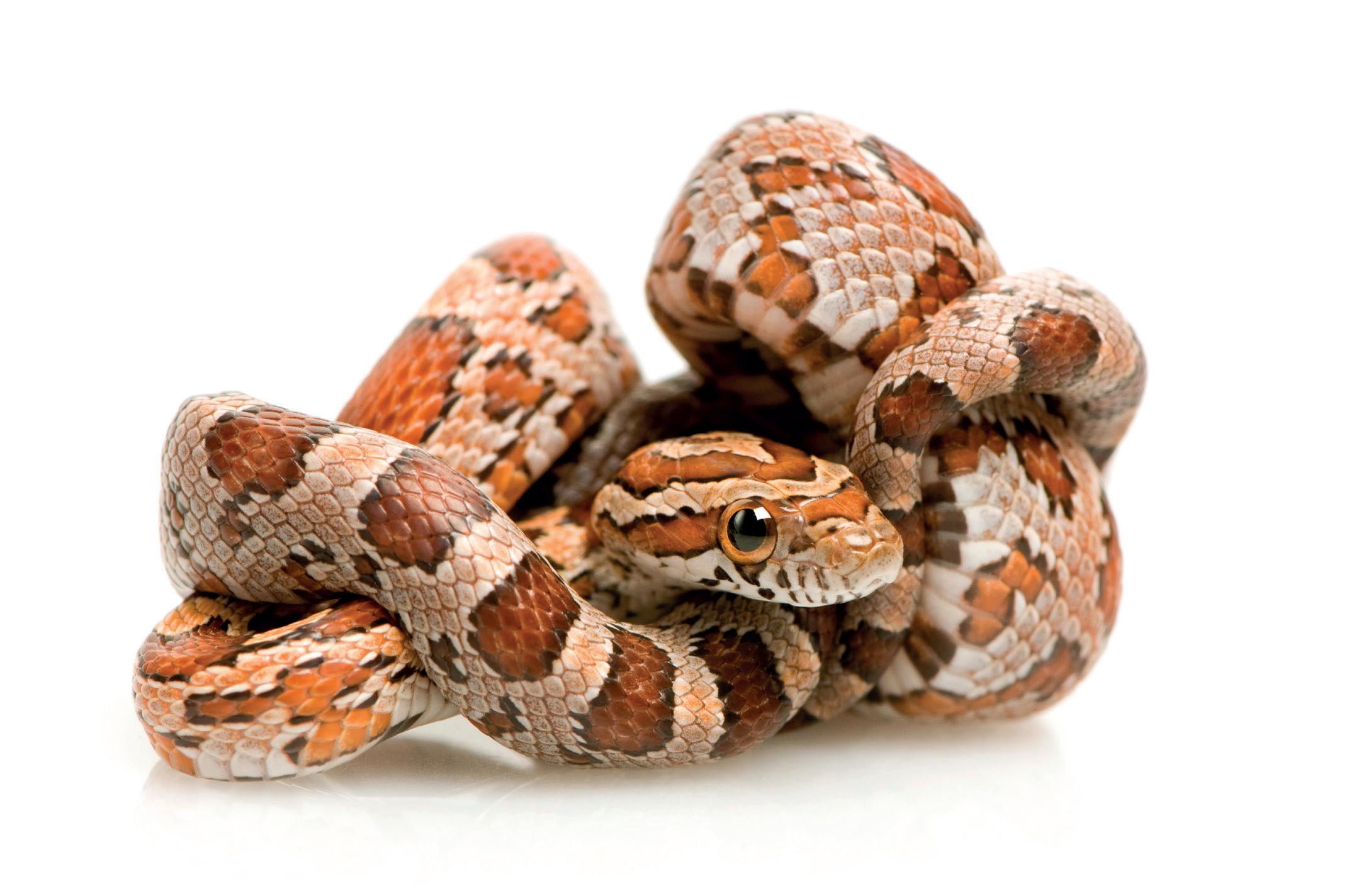
Title 47 MARCH 2022 We provide the most flexible Exotic Insurance around. We also offer dog, cat and horse insurance, all with a fantastic 10% multi-pet discount!* Get a quote TODAY at britishpetinsurance.co.uk or call us on 01444 708840. *10% discount on three pets or more from any species we cover within our pet insurance product range. British Pet Insurance Services is a trading name of Petcover EU Limited who is registered in England and Wales under number 10001319. Petcover EU Limited is authorised and regulated by the Financial Conduct Authority under reference number 747757.
Replicating
high temperatures for
doesn’t have to be hard:

breeding
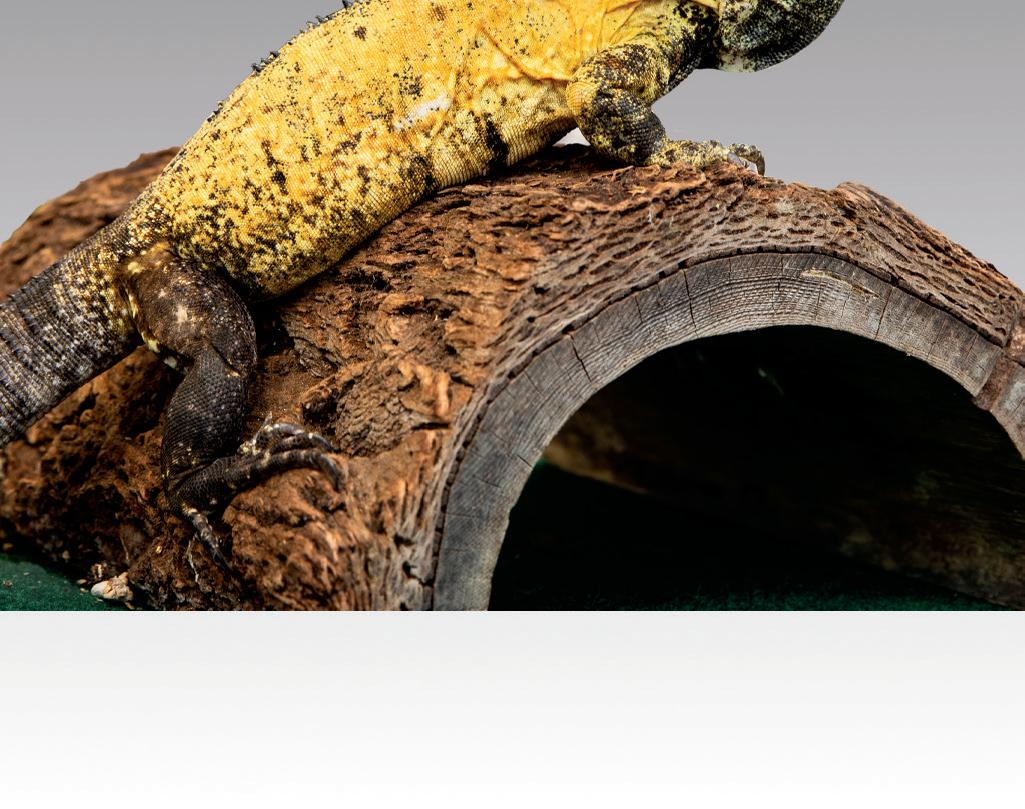

• Deep penetrating infrared wavelengths for safe & efficient heat.






















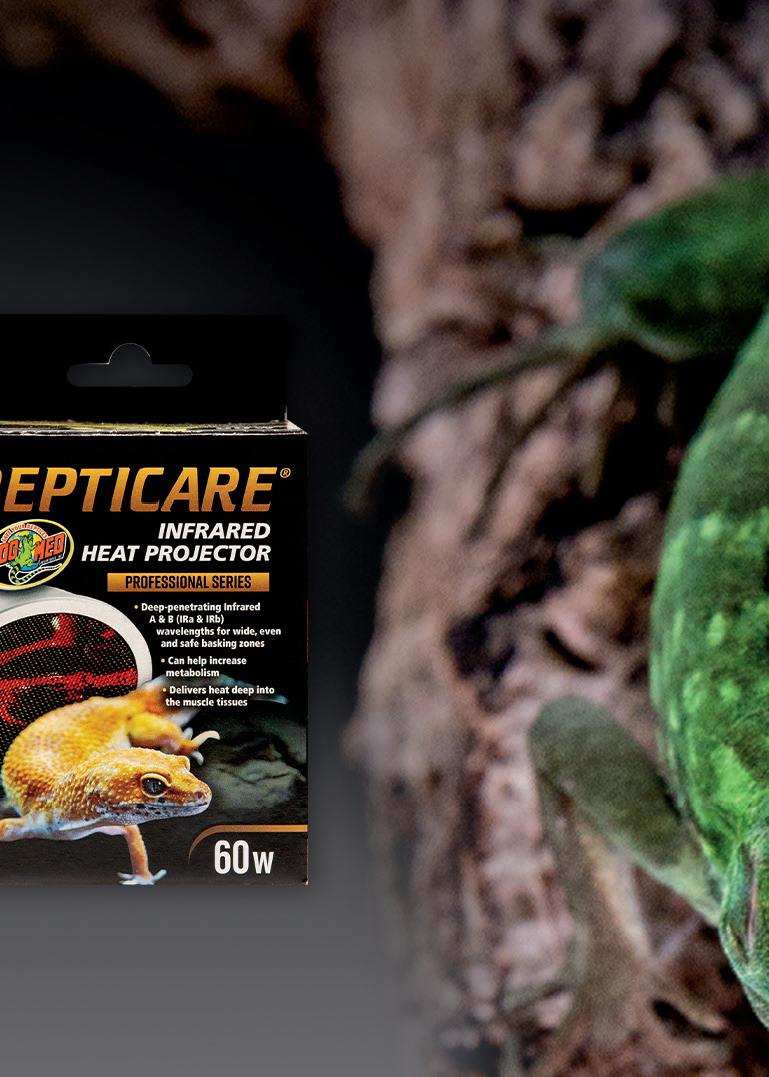
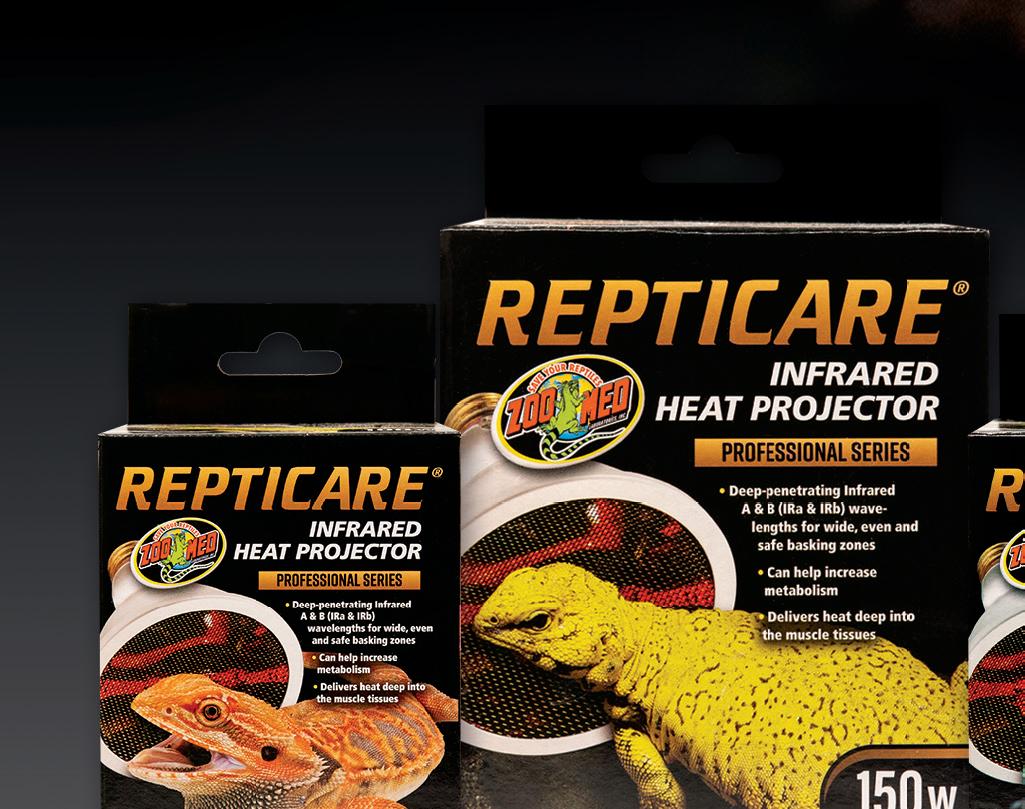

• Wide beam for thorough coverage.



• Can be used 24h/day.

ZOO MED SUCCESS:
Banana Iguanas (Ctenosaura pectinata) are large lizards native to hot, dry habitats such as dry forests and deserts in Mexico and Central America where they regularly experience ambient basking temperatures of over 104º F. In our large Iguana Habitat here in the mild climate, we found it difficult to attain the high basking temperatures these animals desired. Although these animals were active and appeared healthy for over 12 years here, we did not have any success breeding them until adding a Zoo Med Infrared Heat Projector above one of their basking sites. The animals seemed to prefer this heat and spent an increased amount of time relaxing under these heating elements, then finally laid a beautiful clutch of eggs that hatched successfully 77 days later. After many years of trying different strategies to encourage reproduction, we are pleased to finally introduce the offspring of our Banana Iguanas! www.zoomed.com
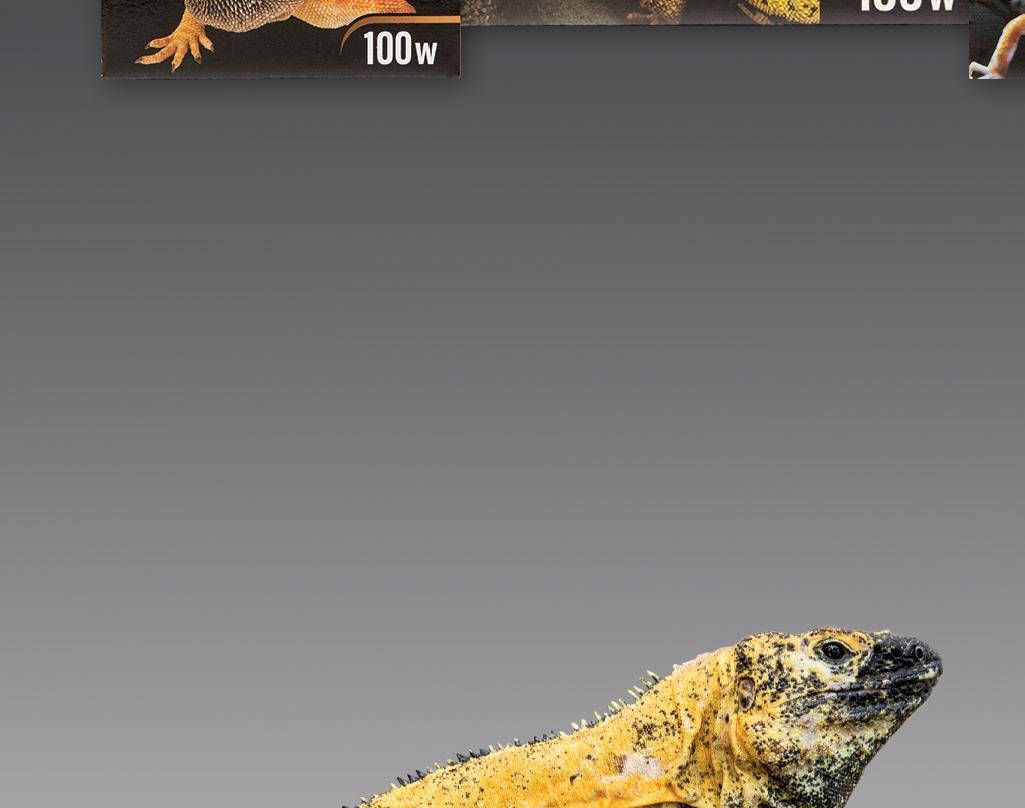
FOR
Adult Banana Iguana Ctenosaura pectinata
Baby Banana Iguana Ctenosaura pectinata




































































 Red ornate pacman frog (Ceratophrys ornata)
Red ornate pacman frog (Ceratophrys ornata)




 Ornate horned frog (Ceratophrys ornata)
Ornate horned frog (Ceratophrys ornata)





























































































 by Max Pedley
by Max Pedley




























































 Gambian pouched rat (Cricetomys gambianus)
Gambian pouched rat (Cricetomys gambianus)












































































 Keeper Basics: Lighting
Keeper Basics: Lighting

































































































































